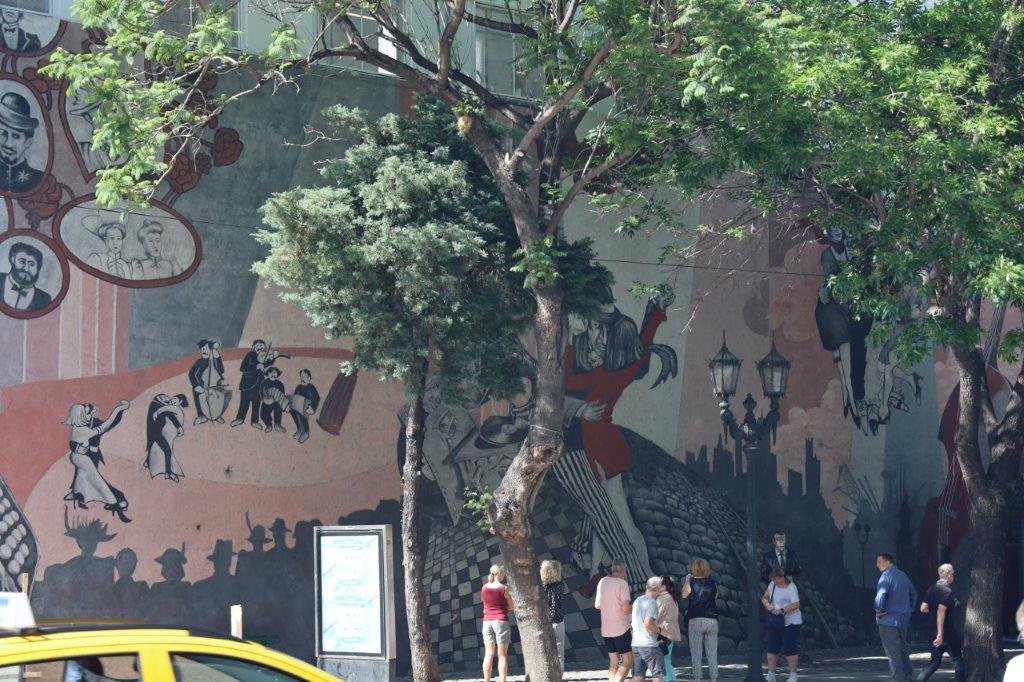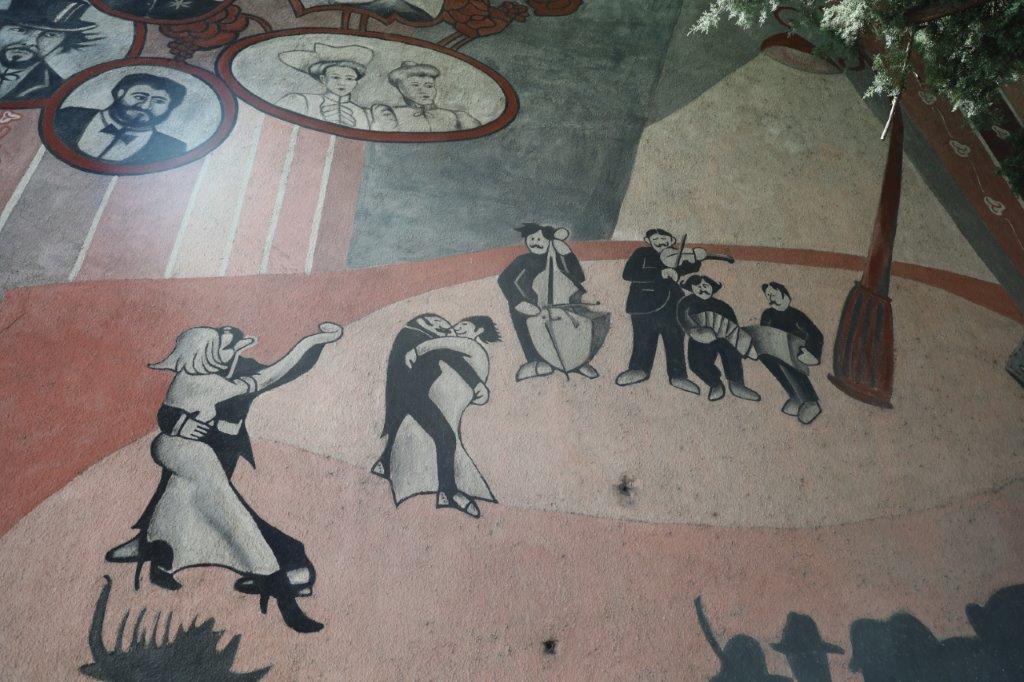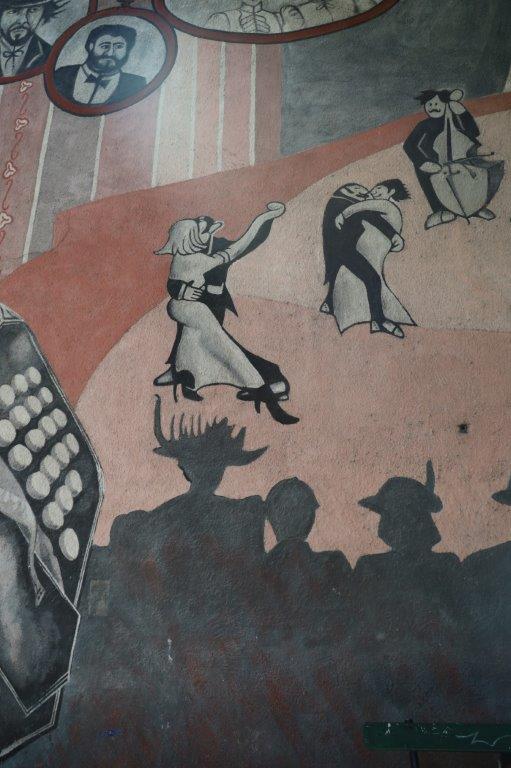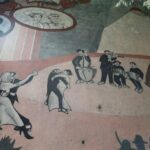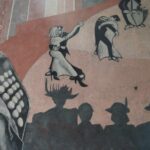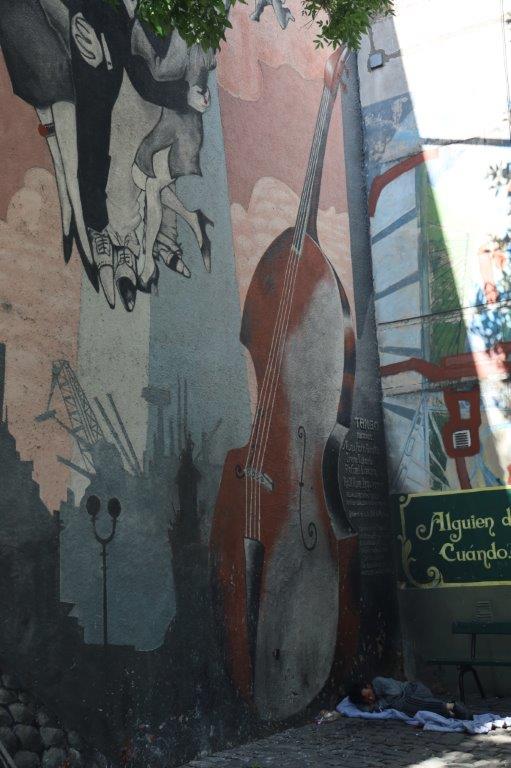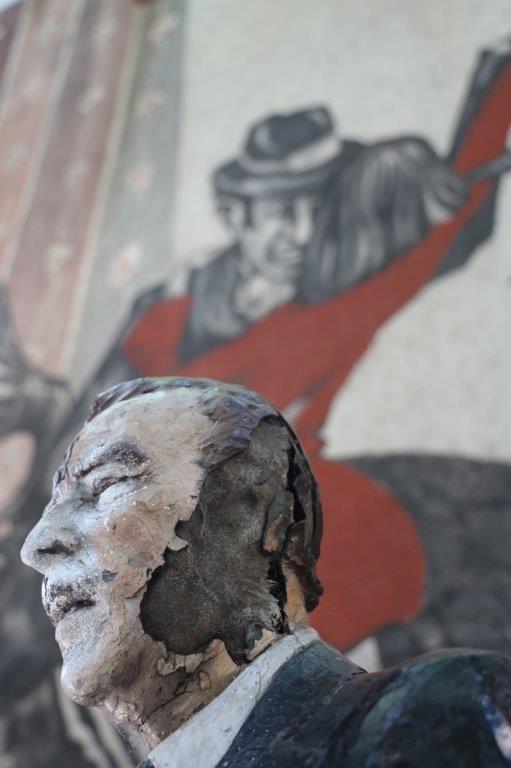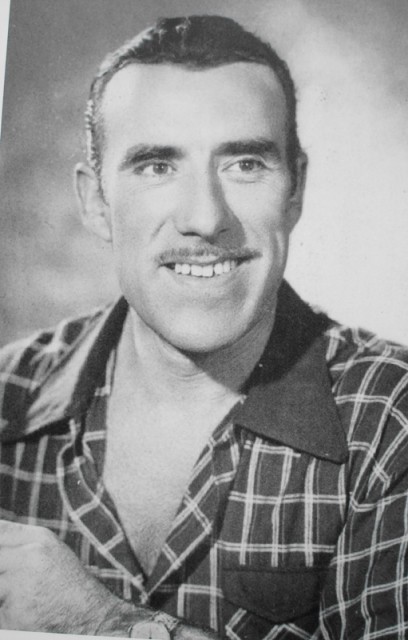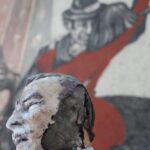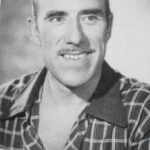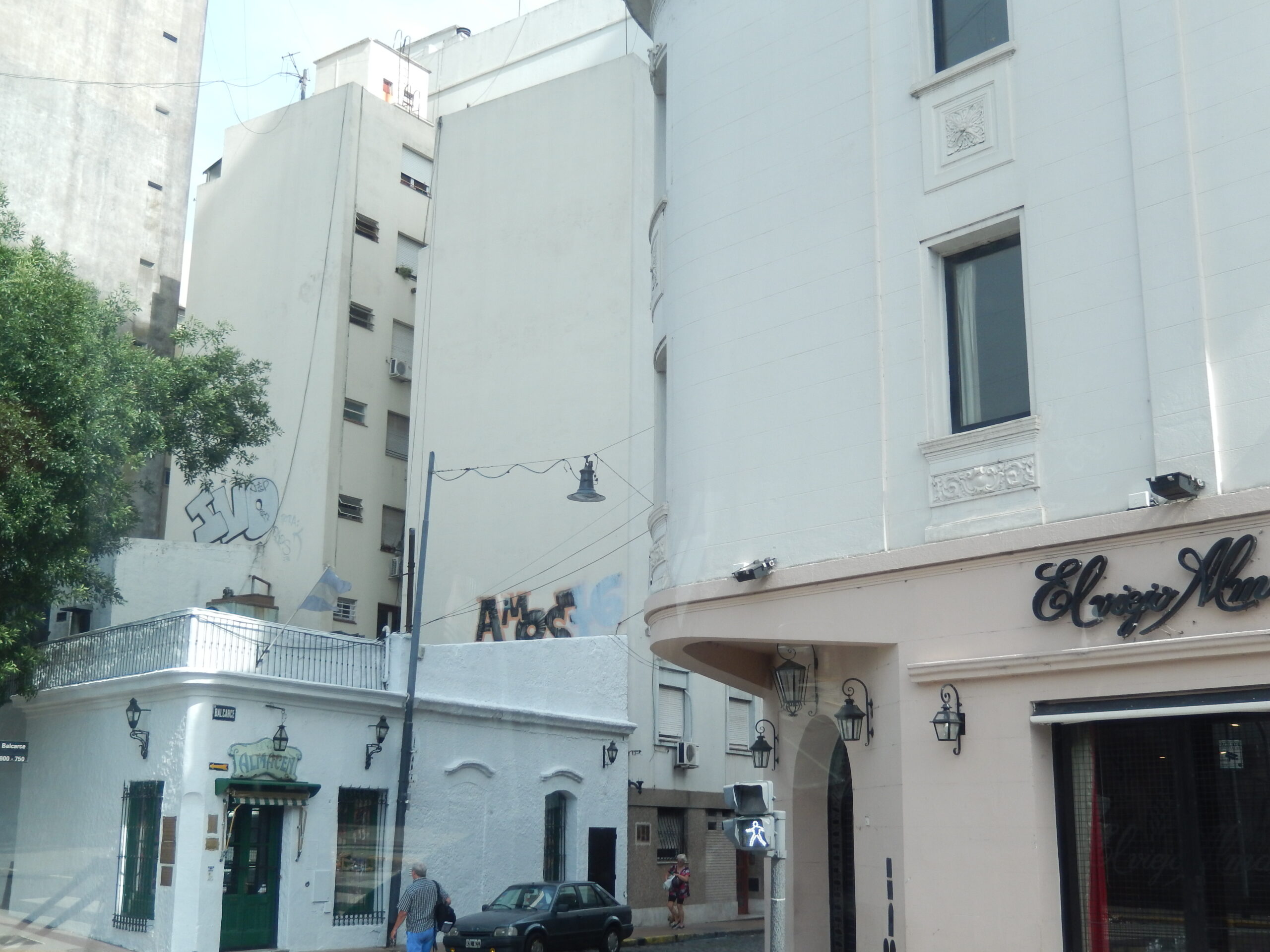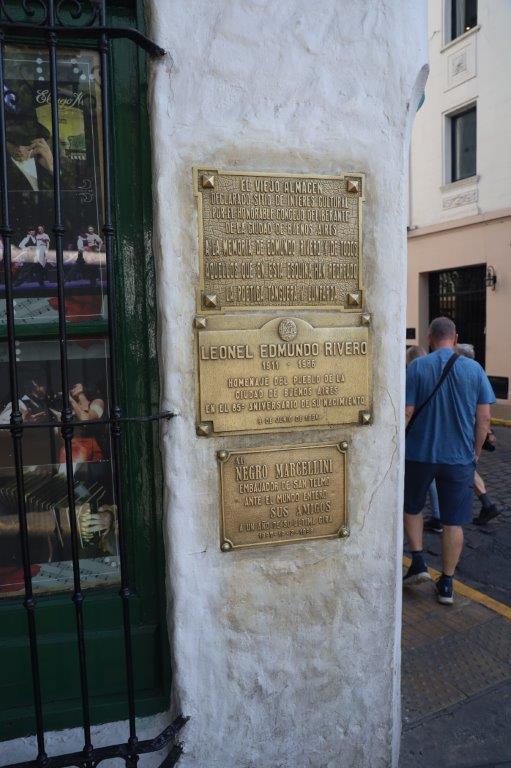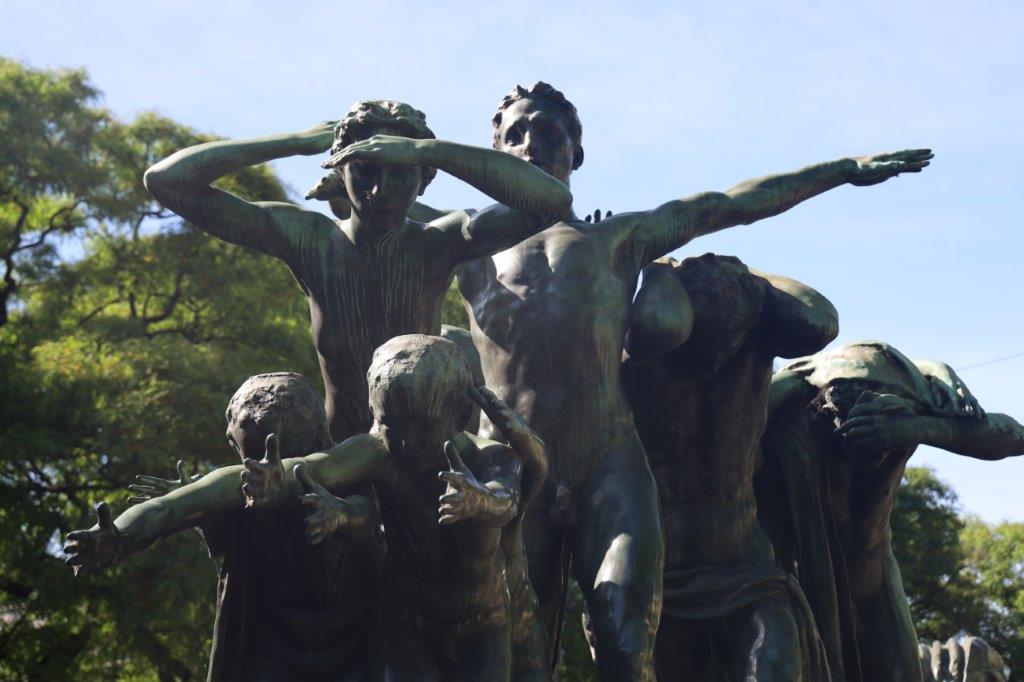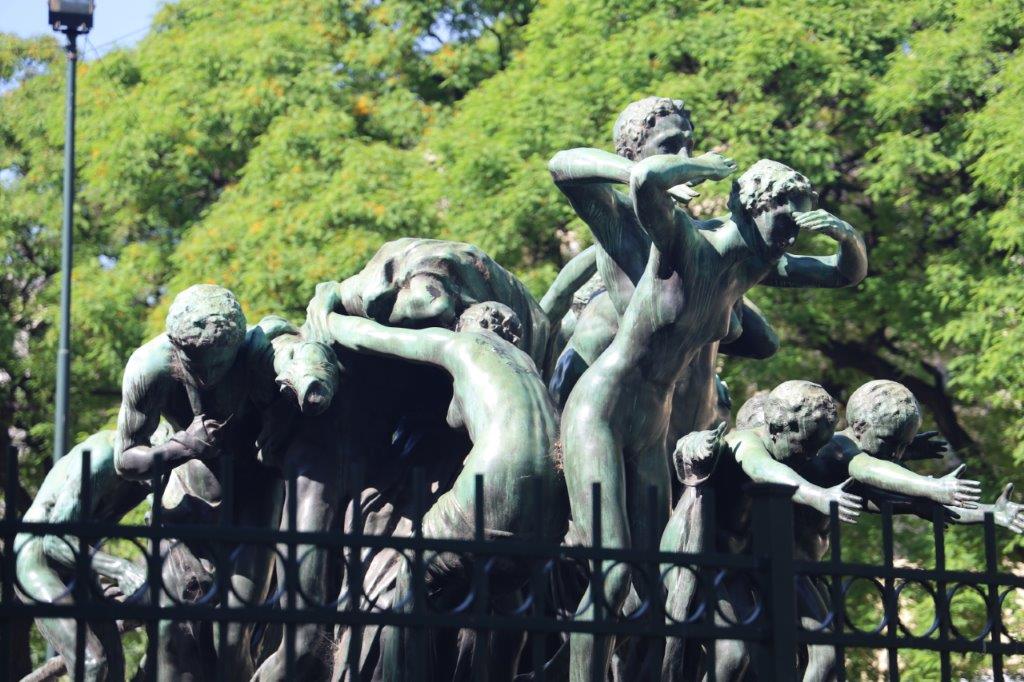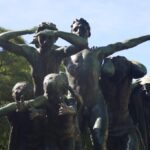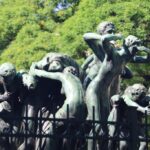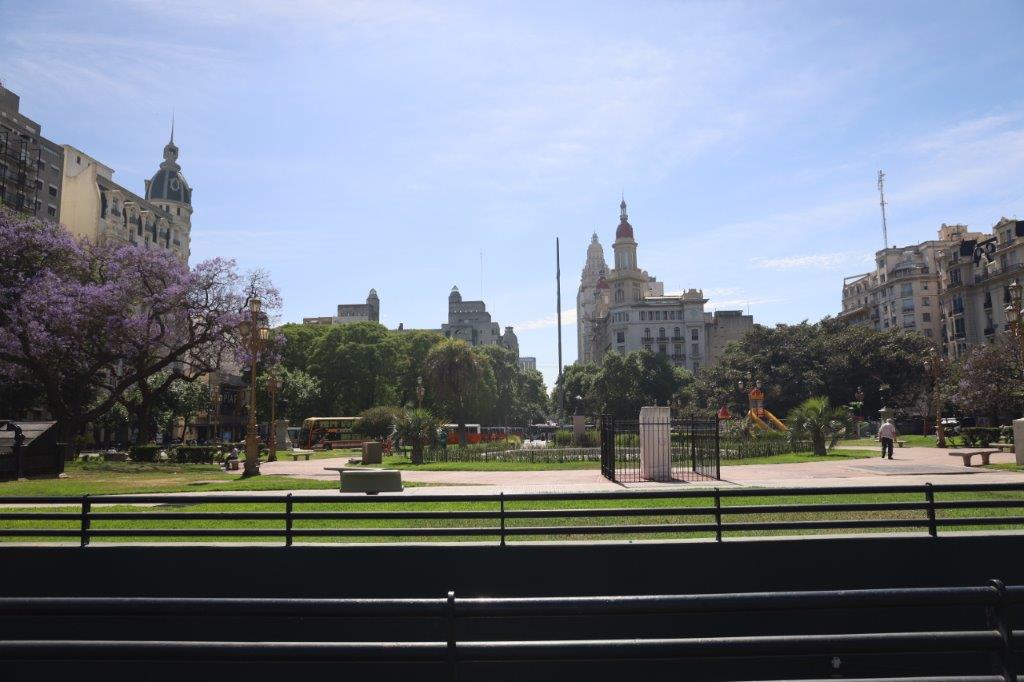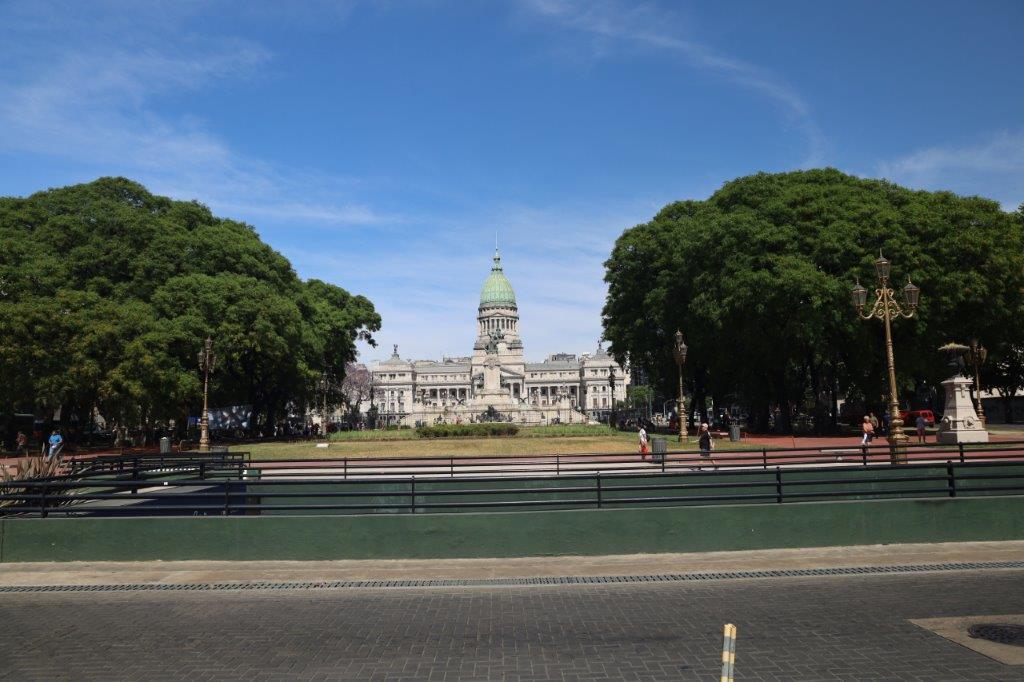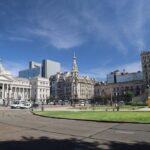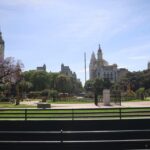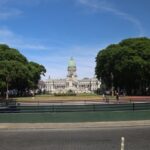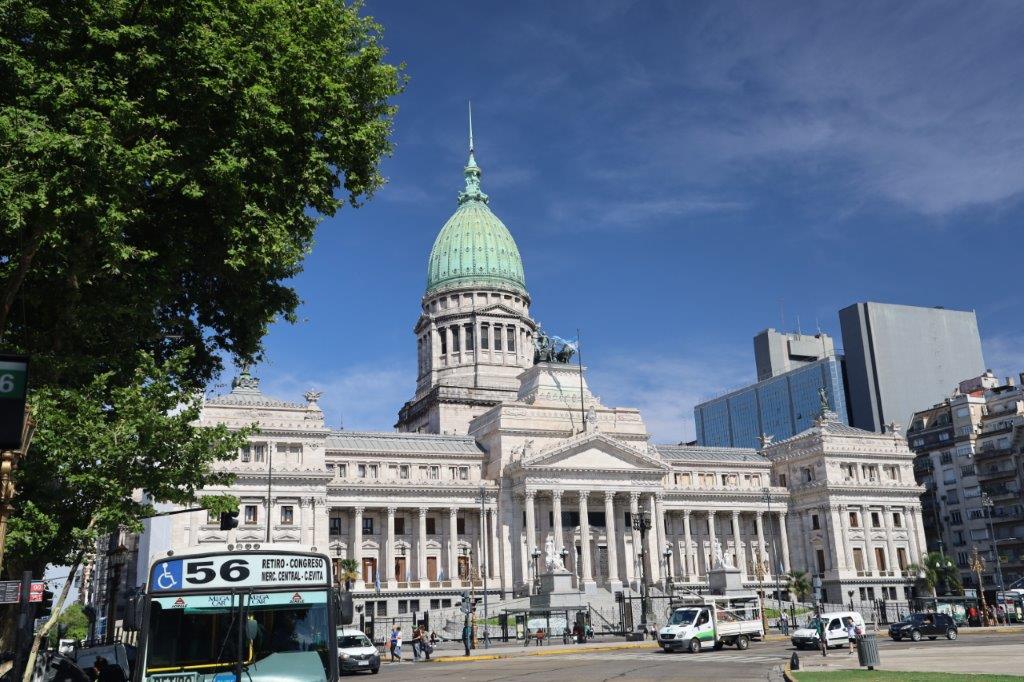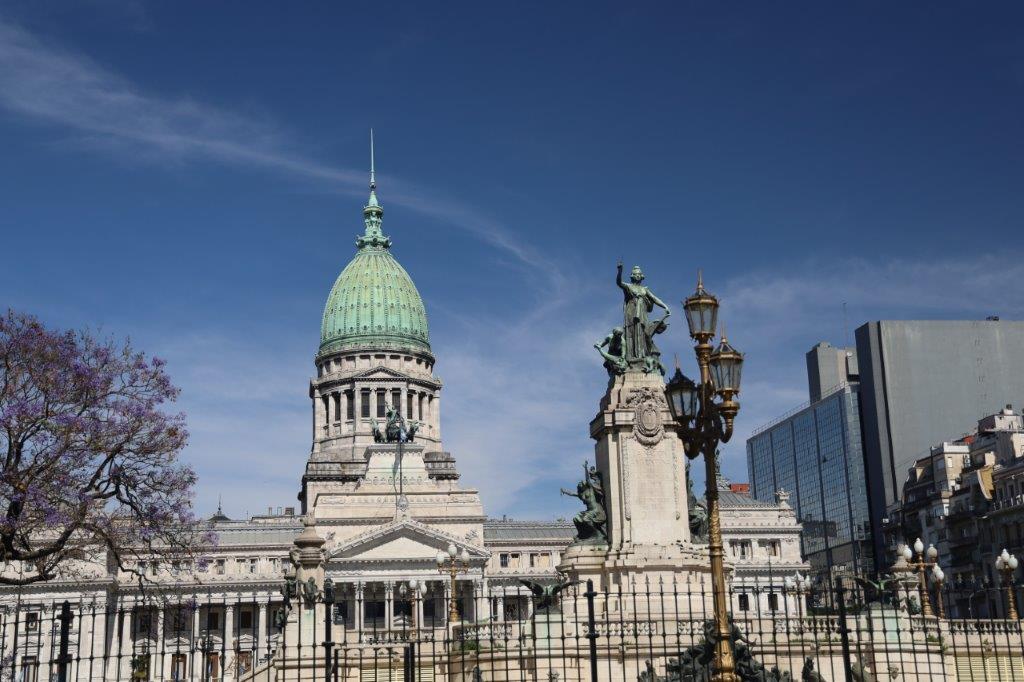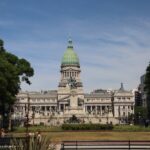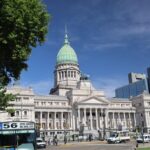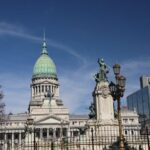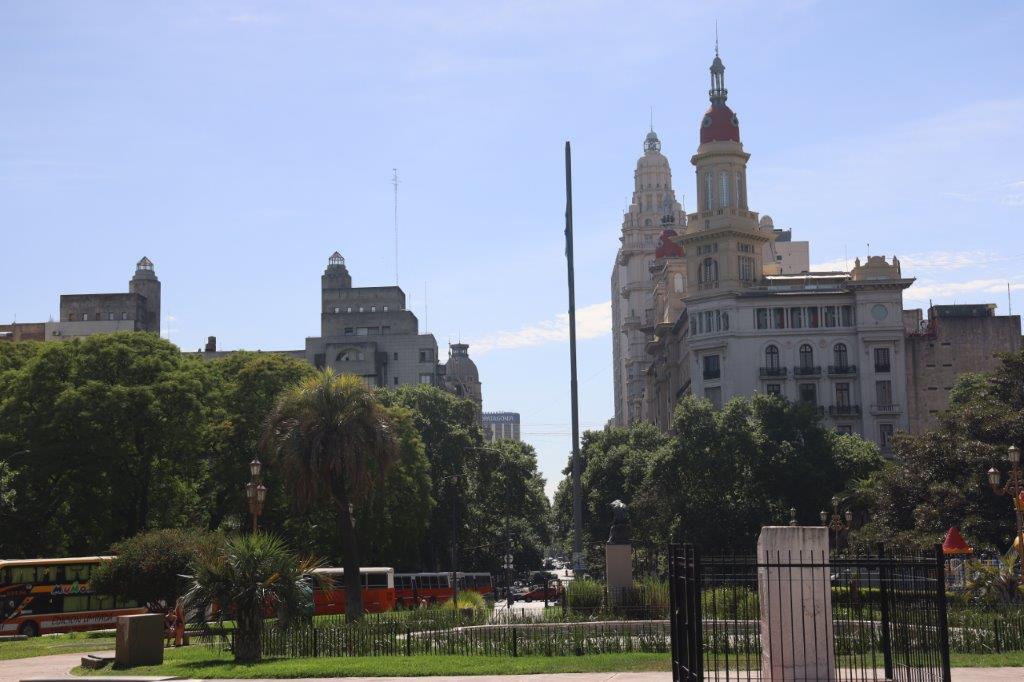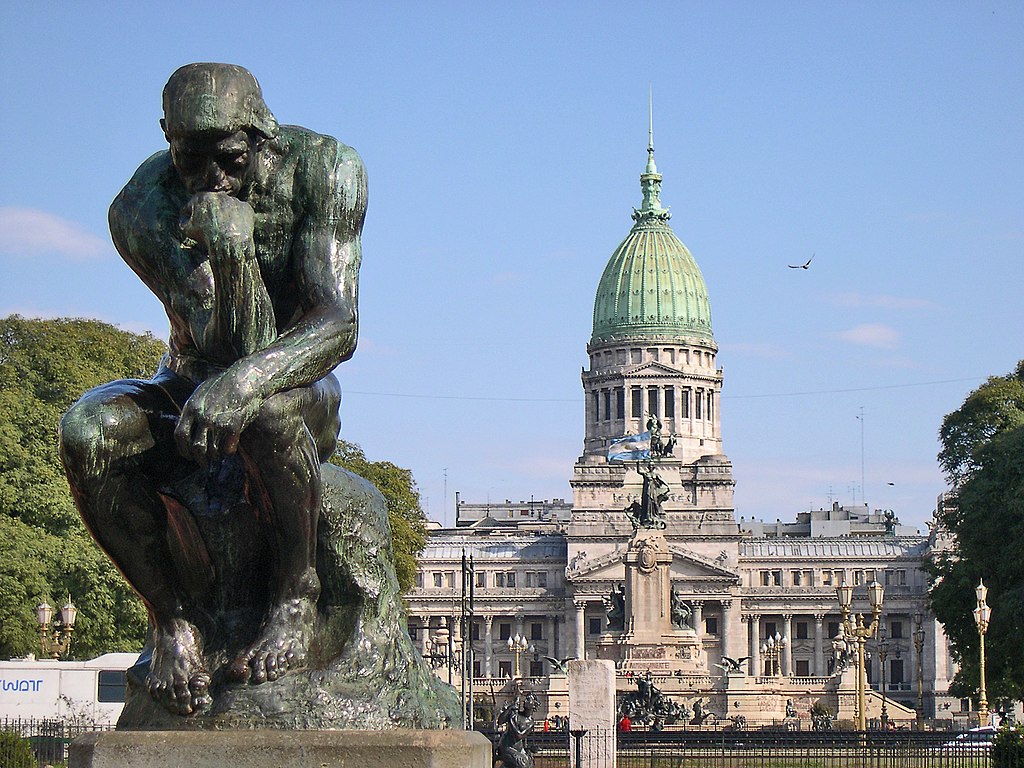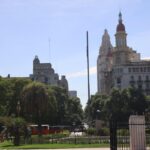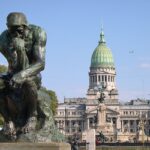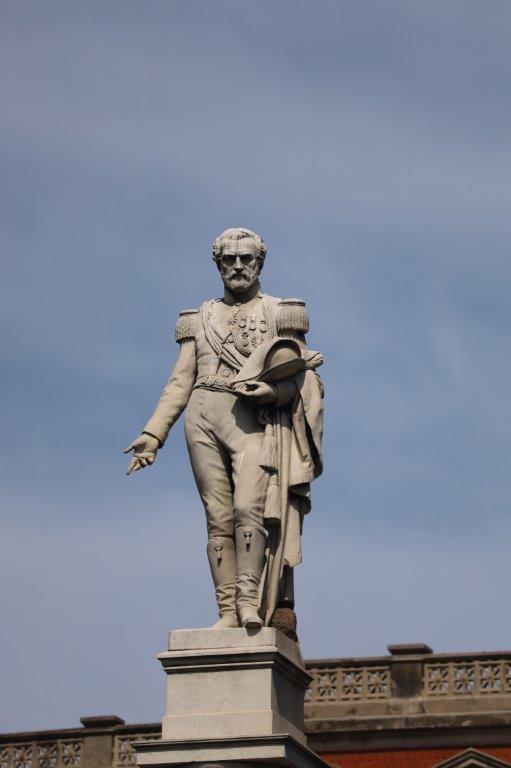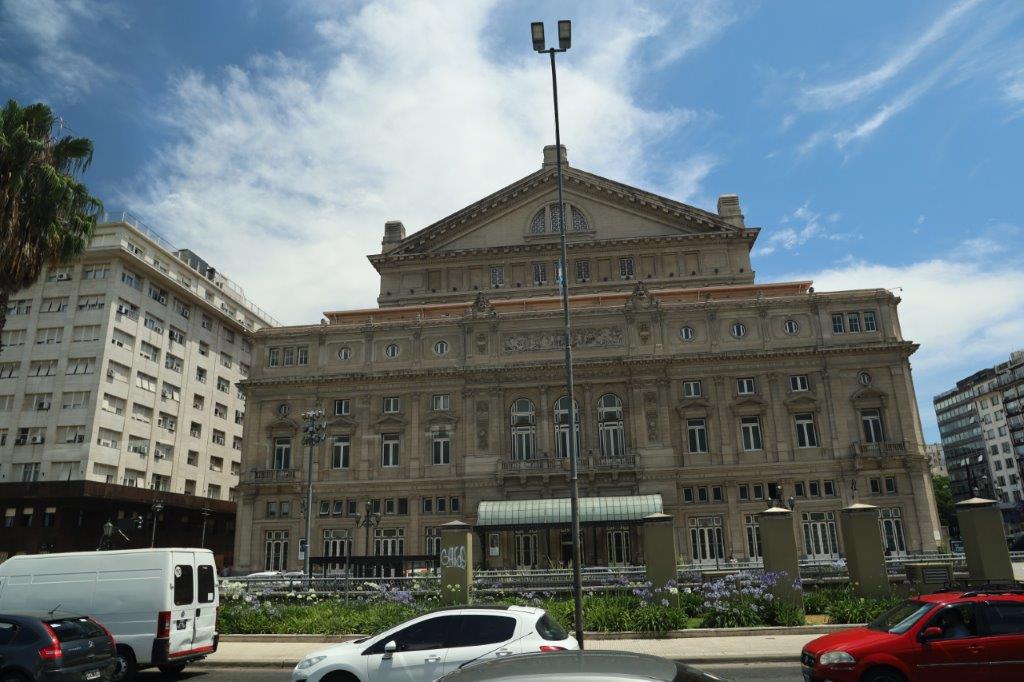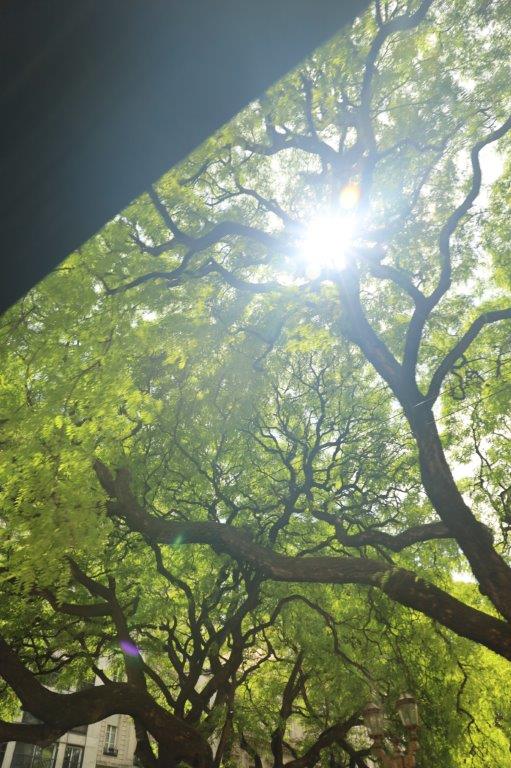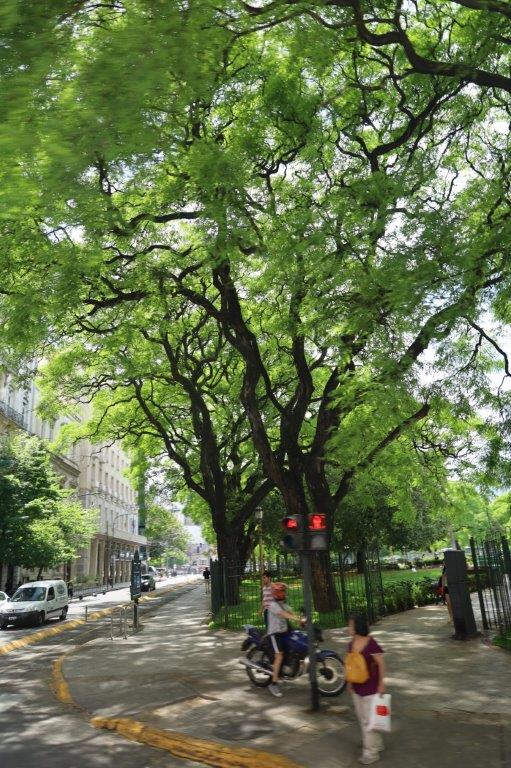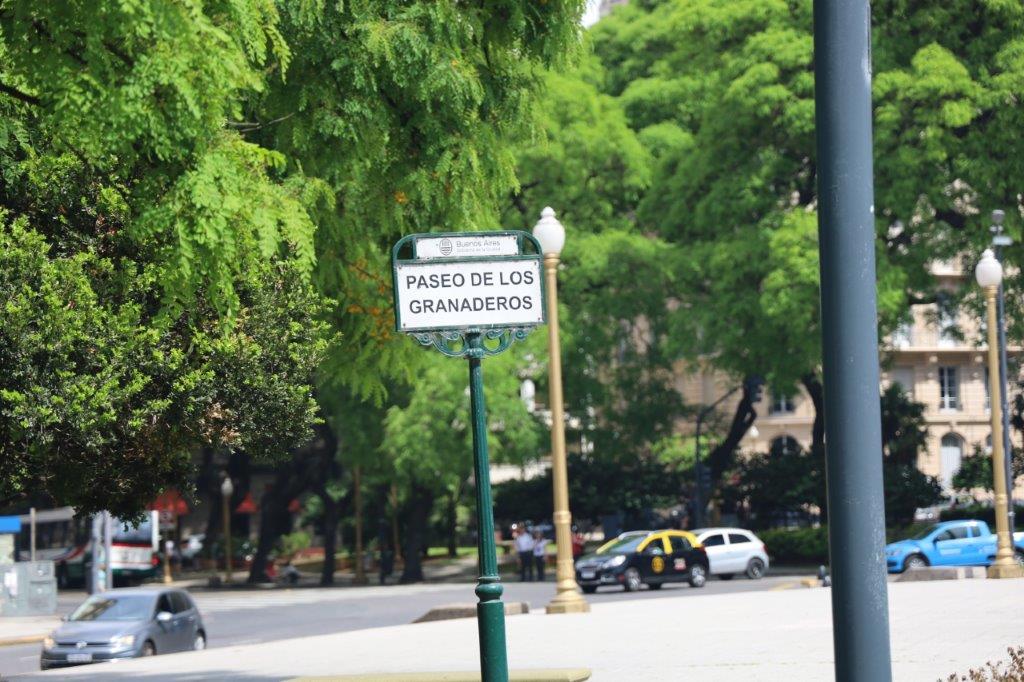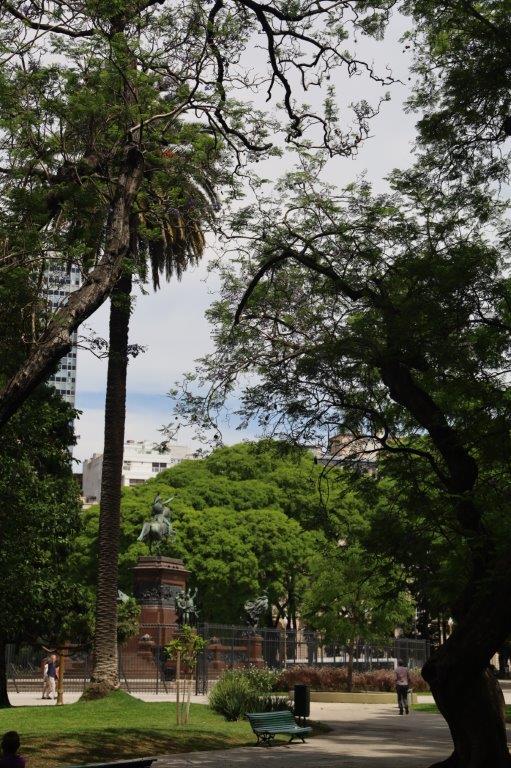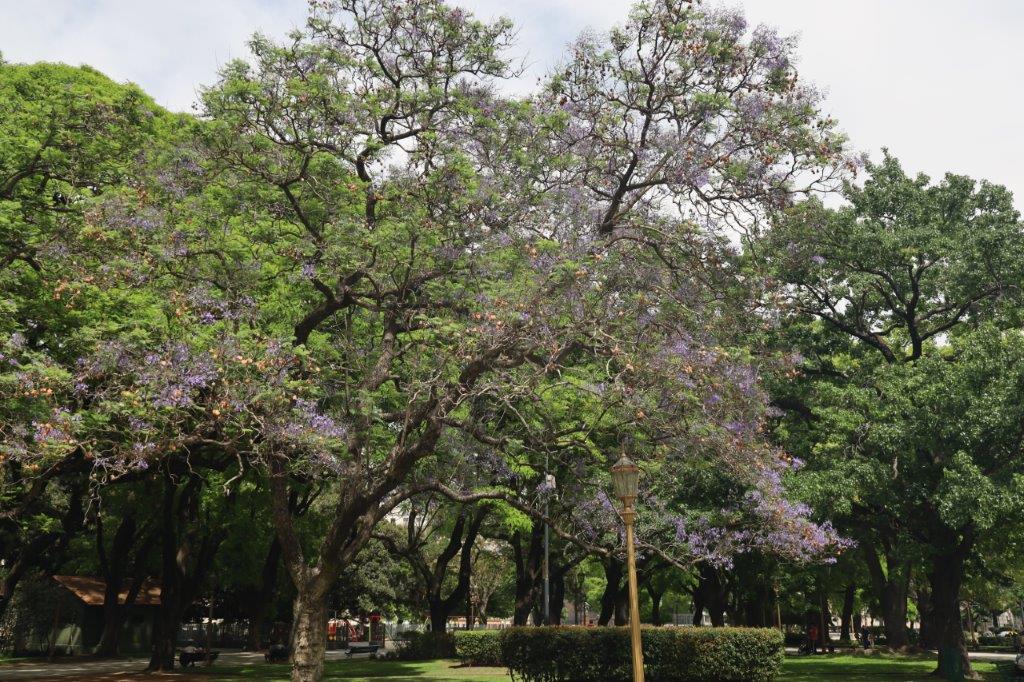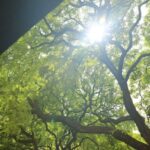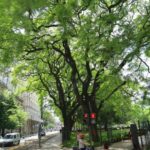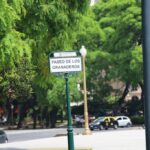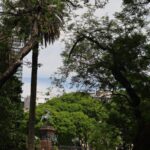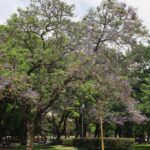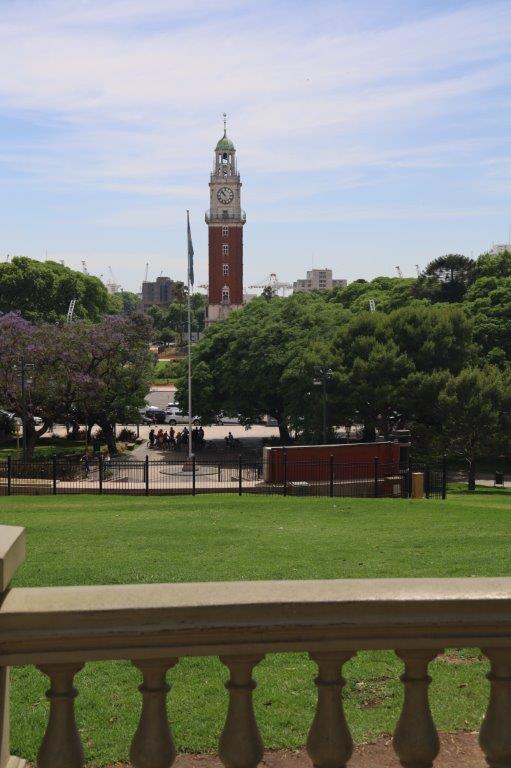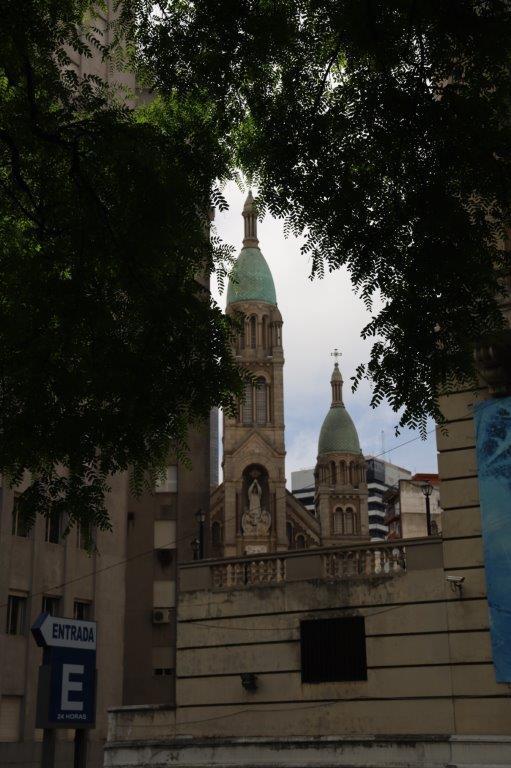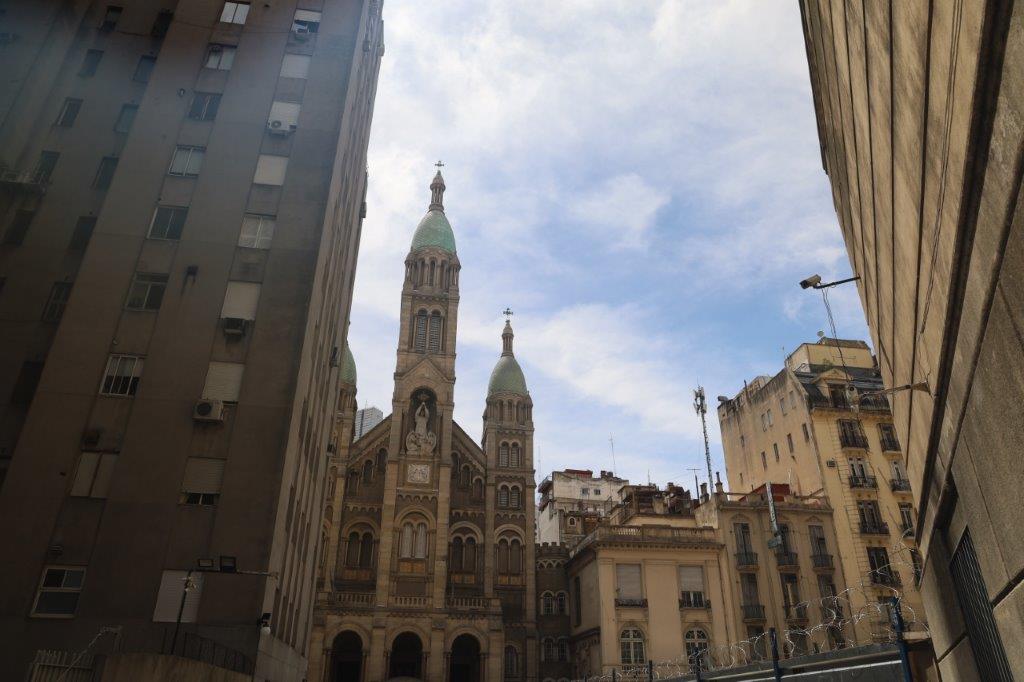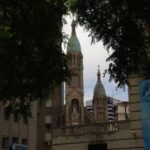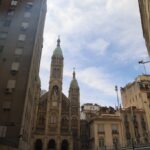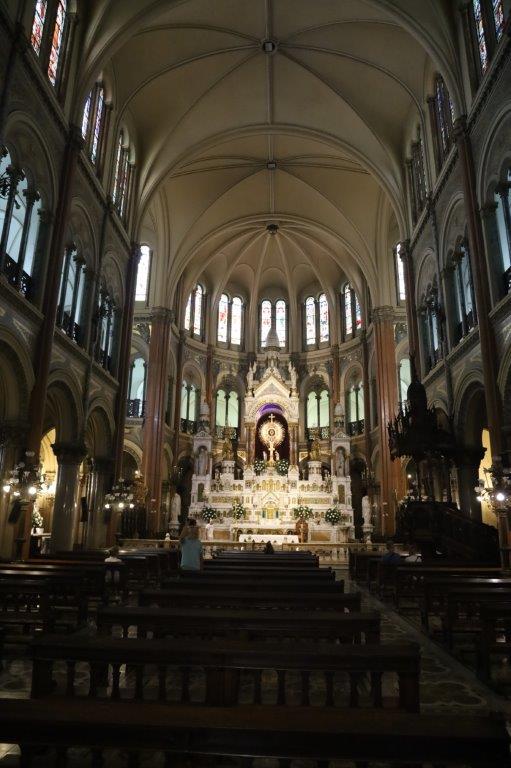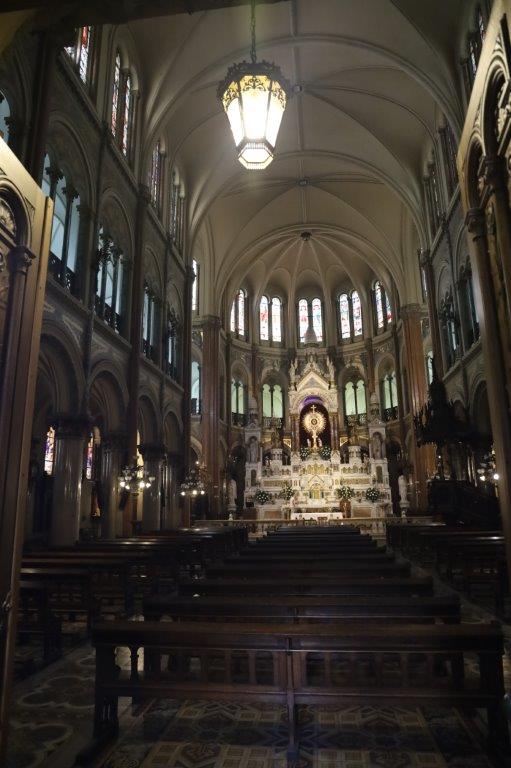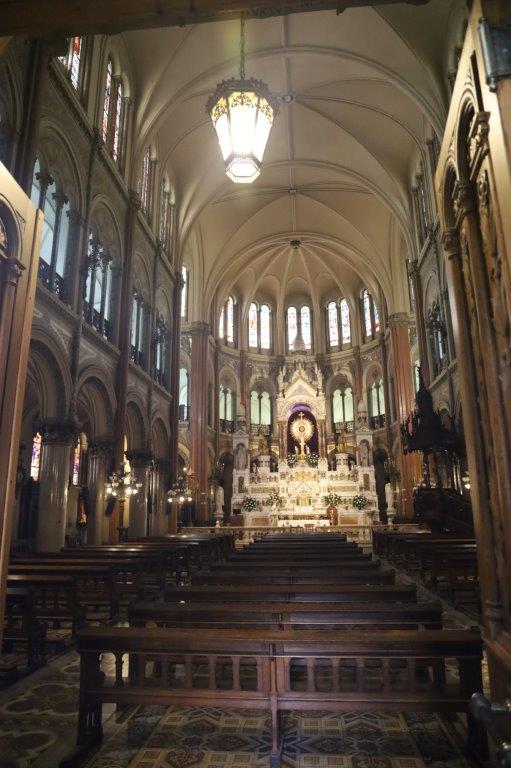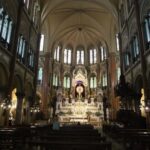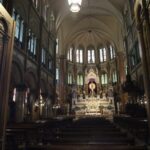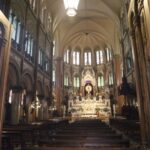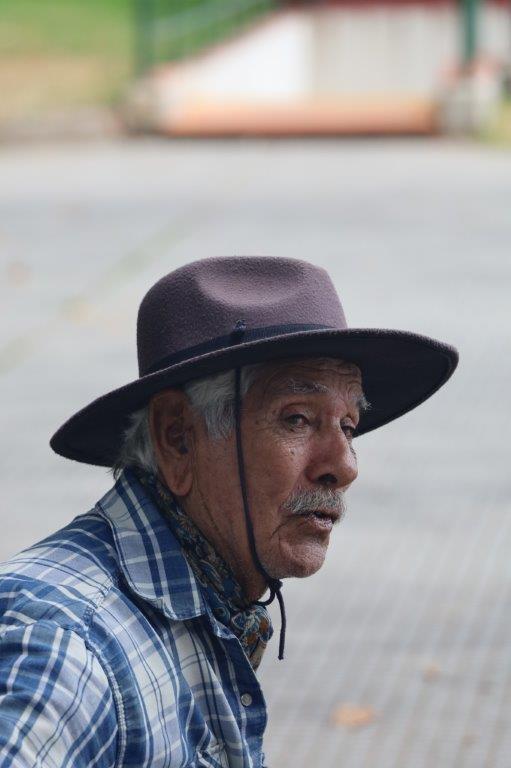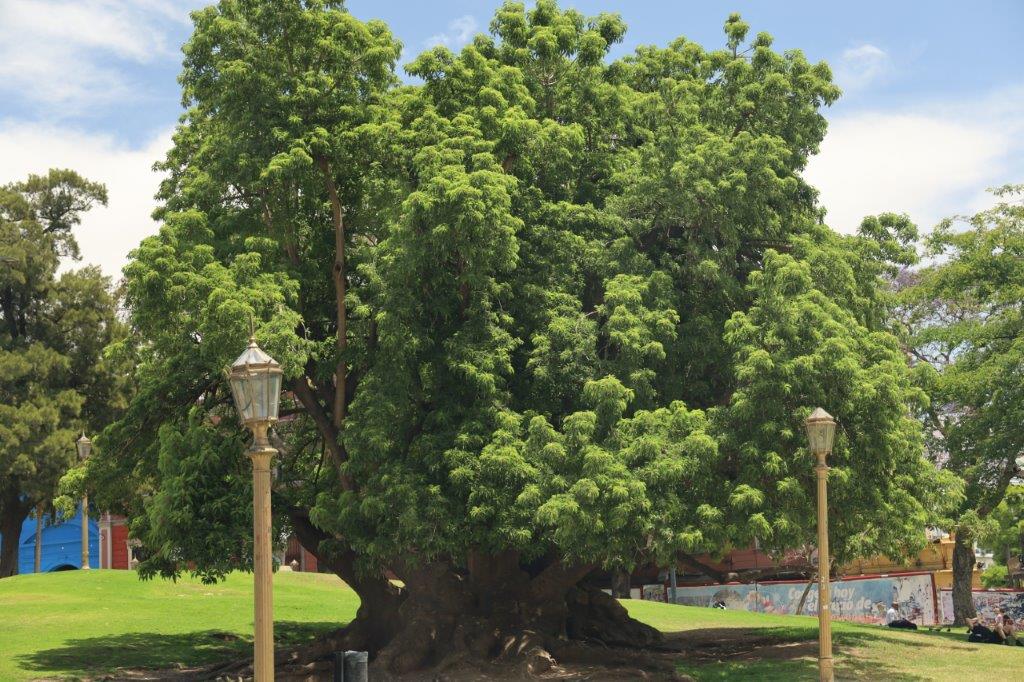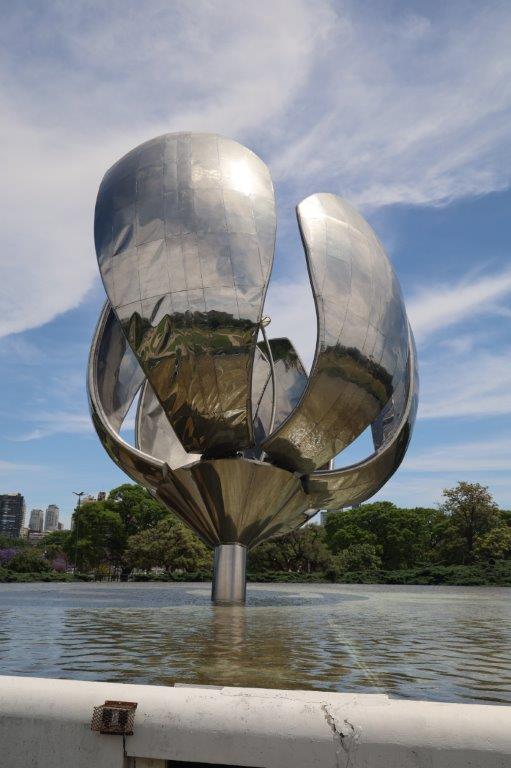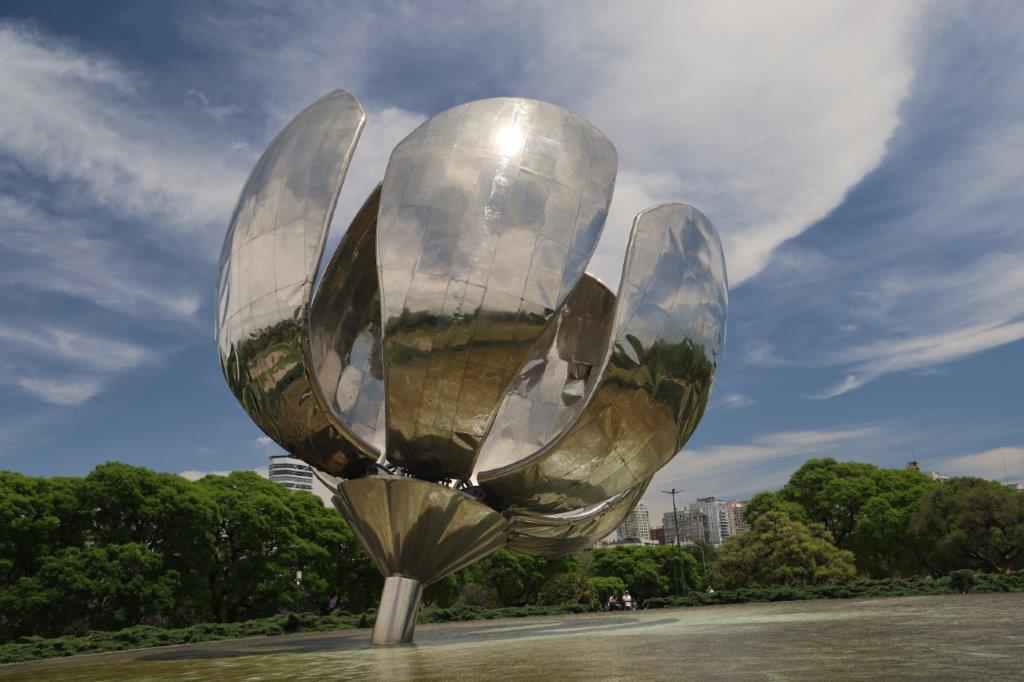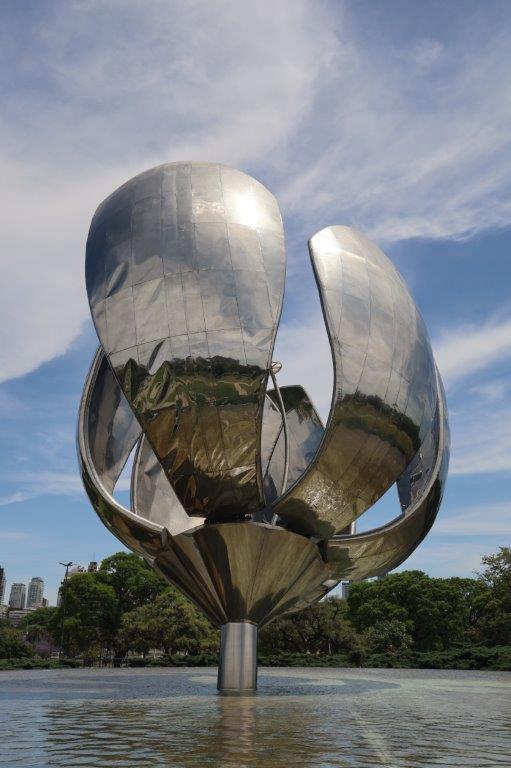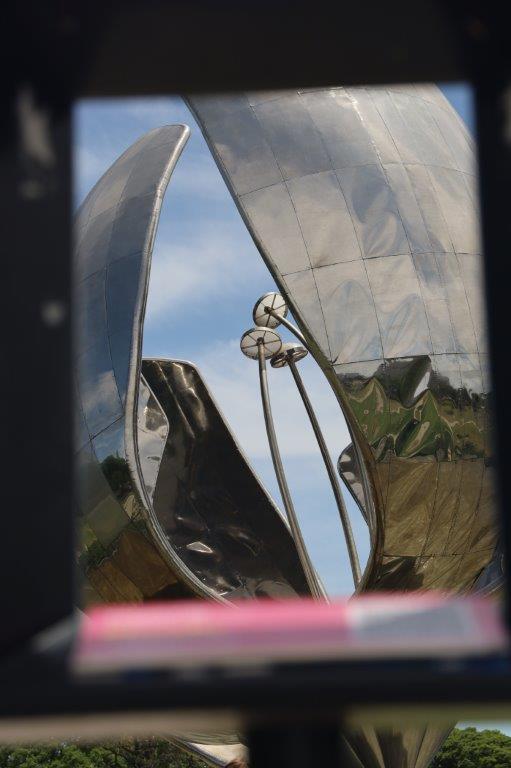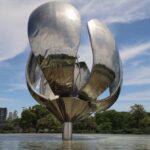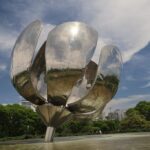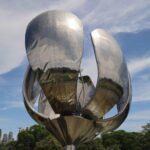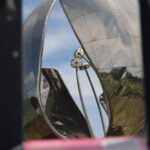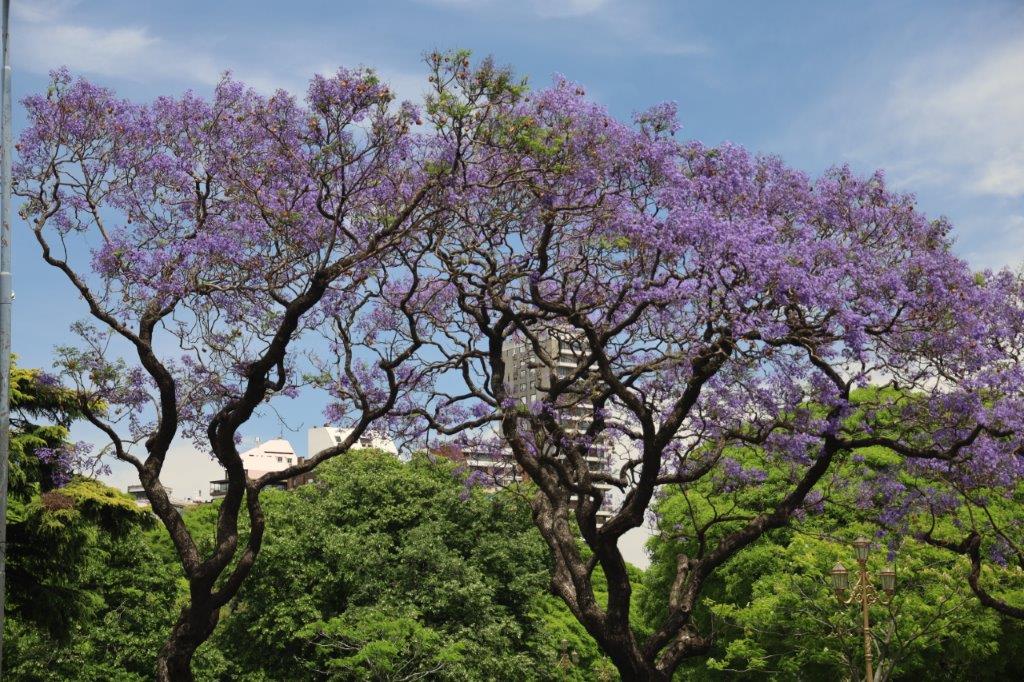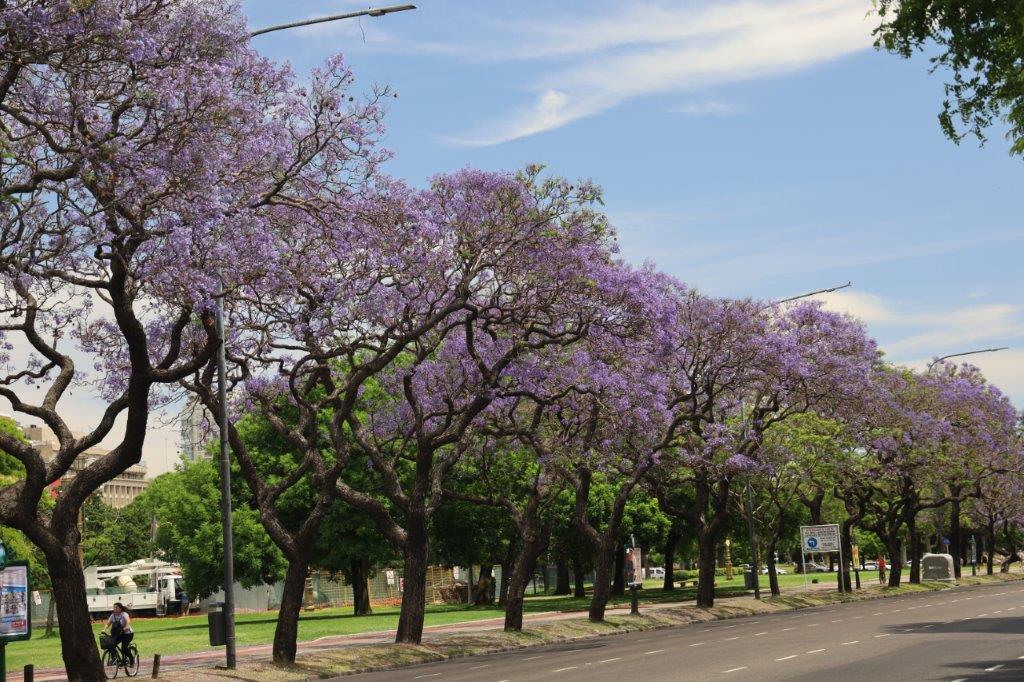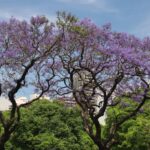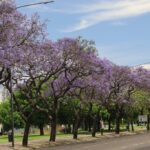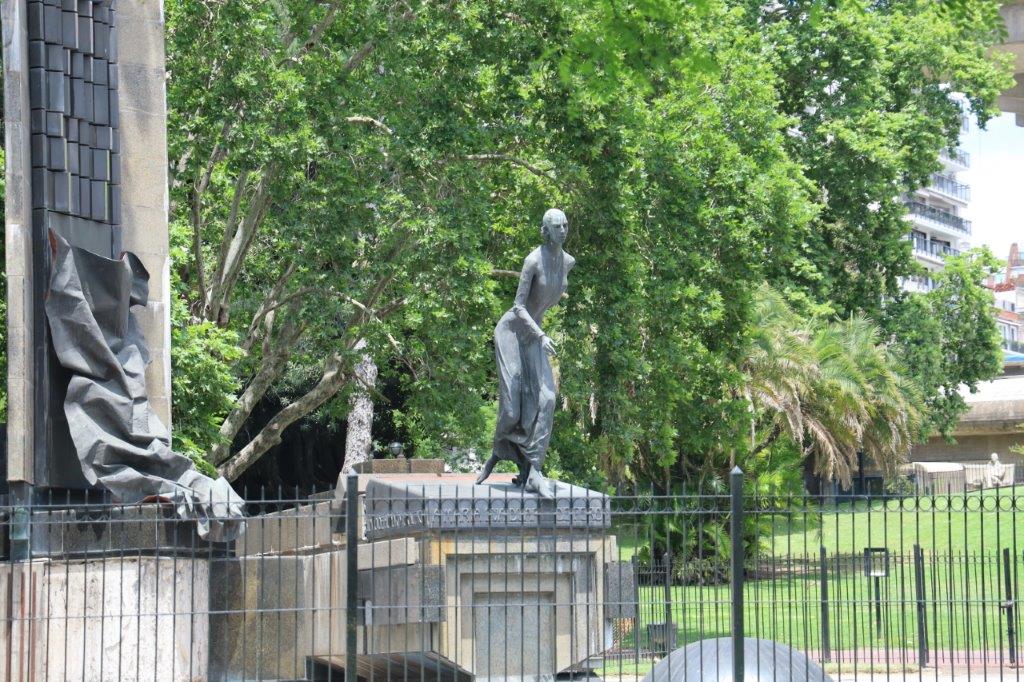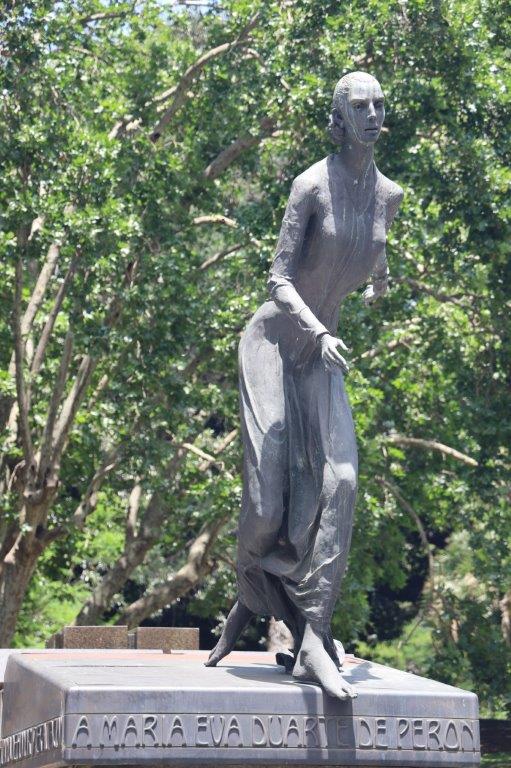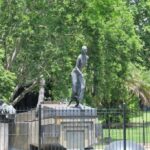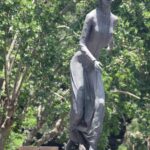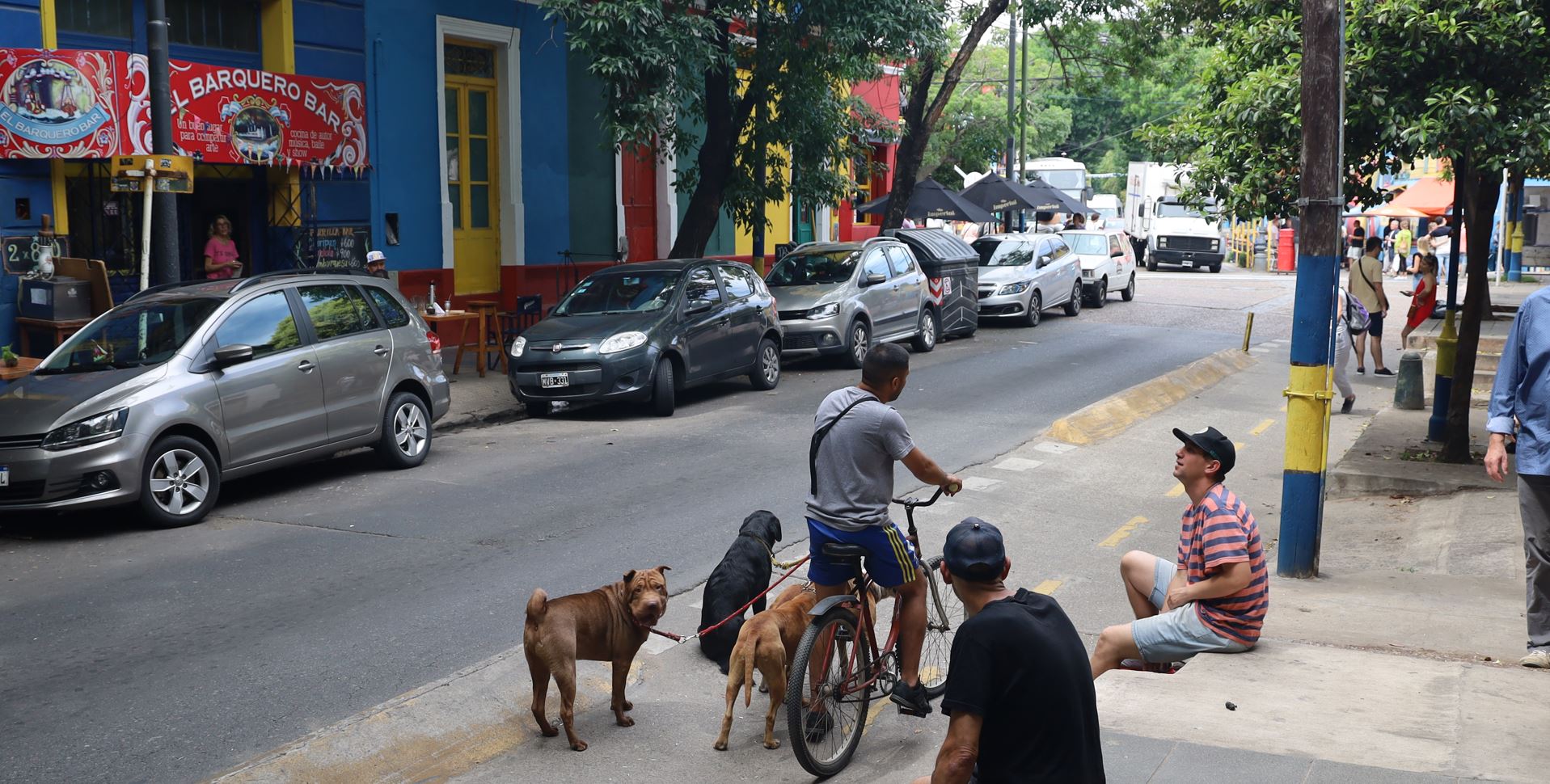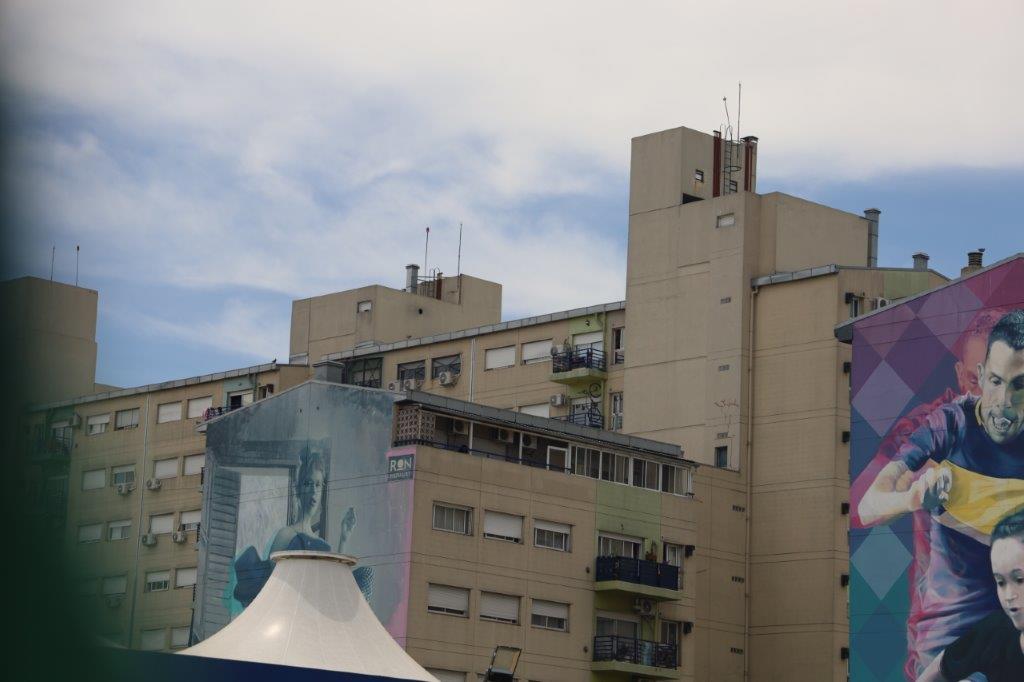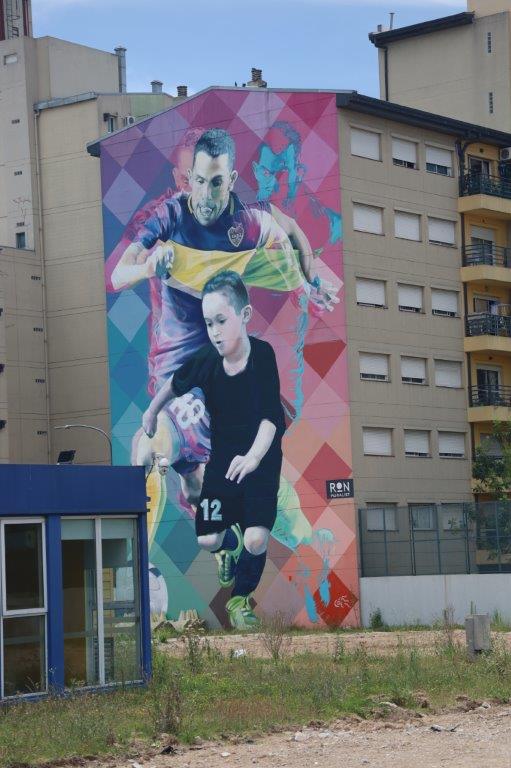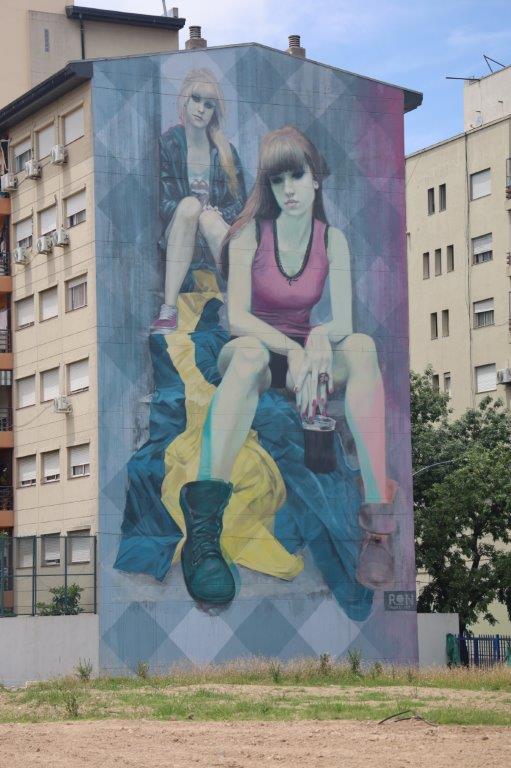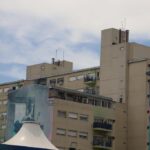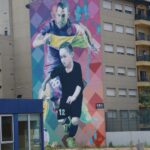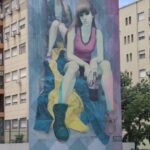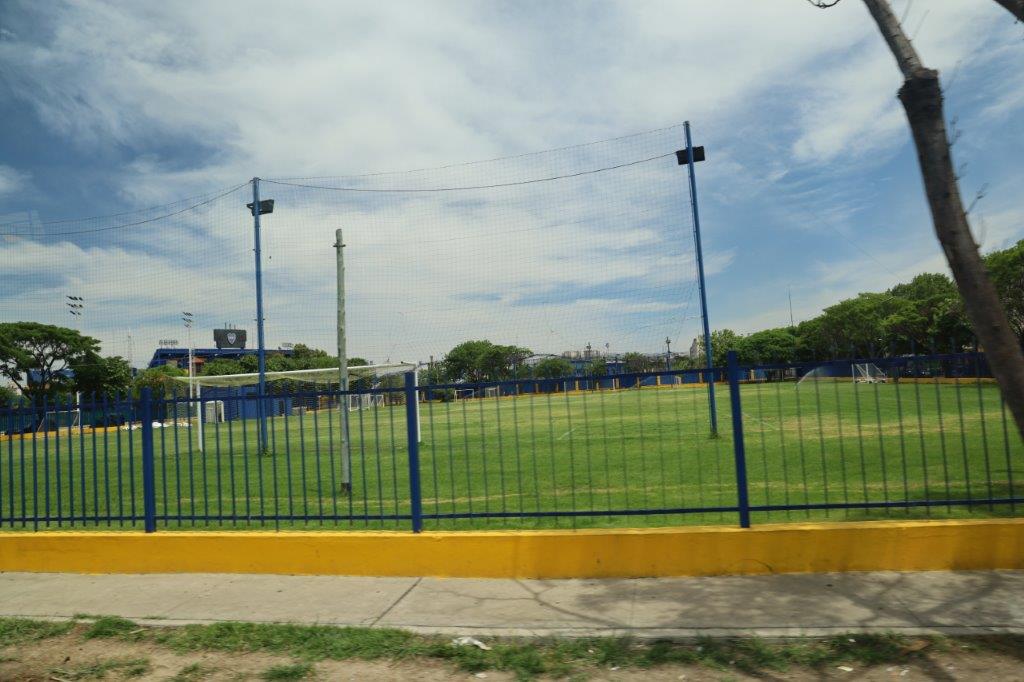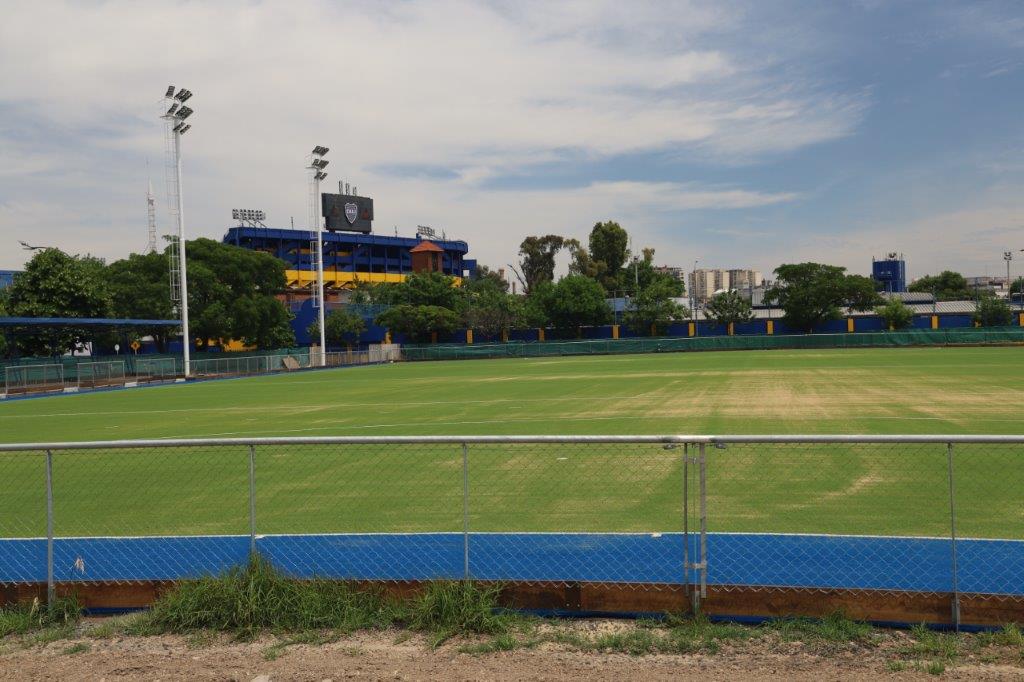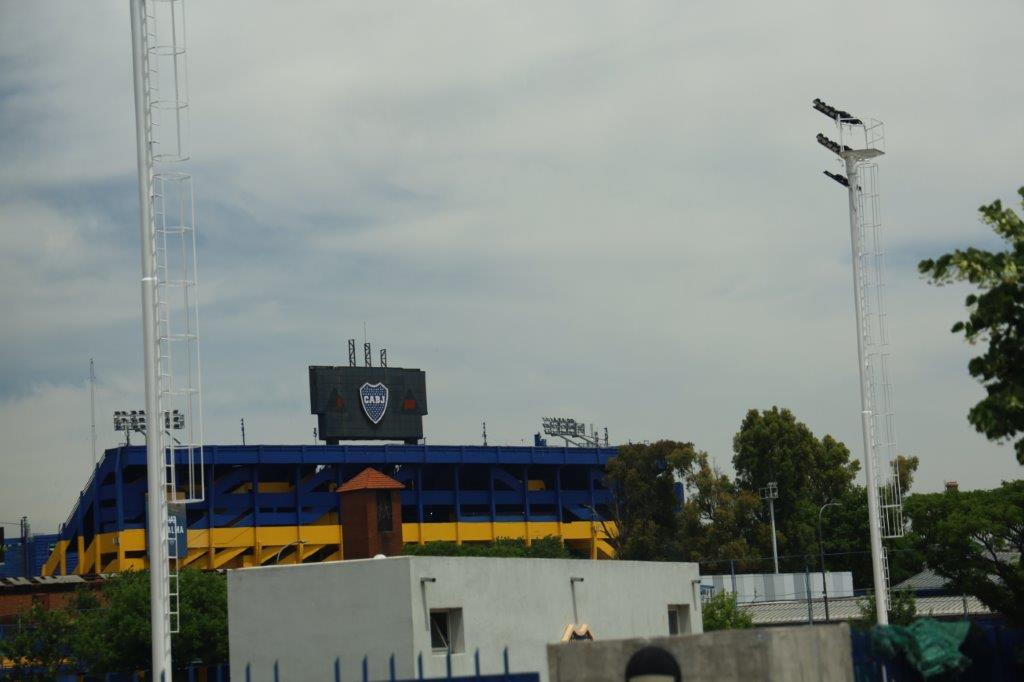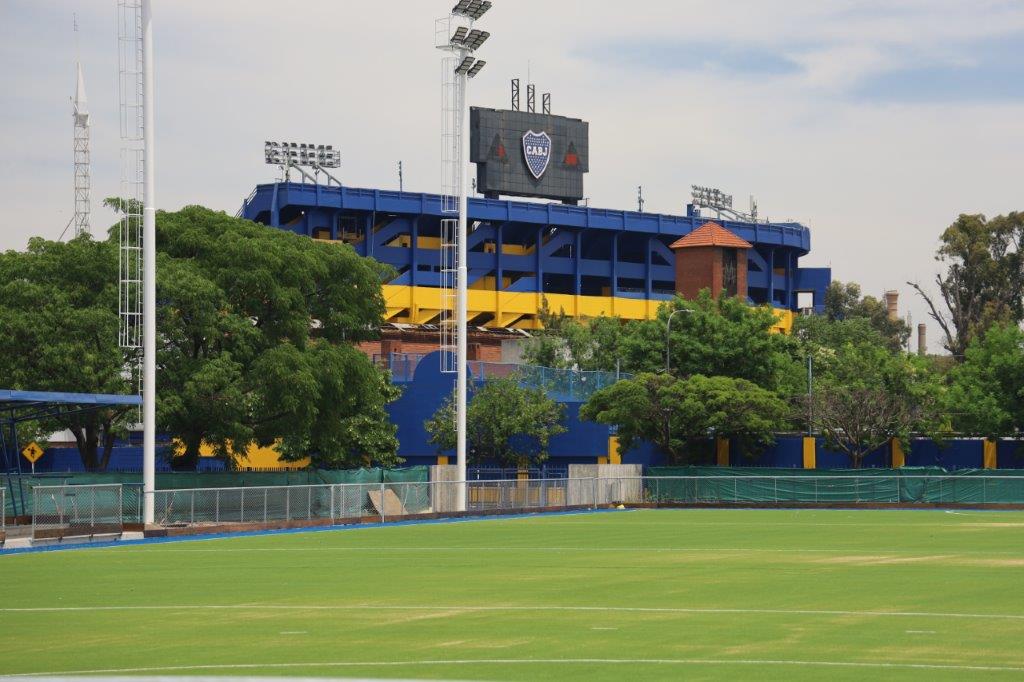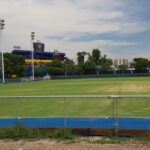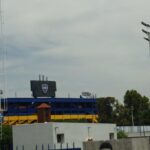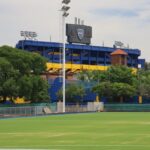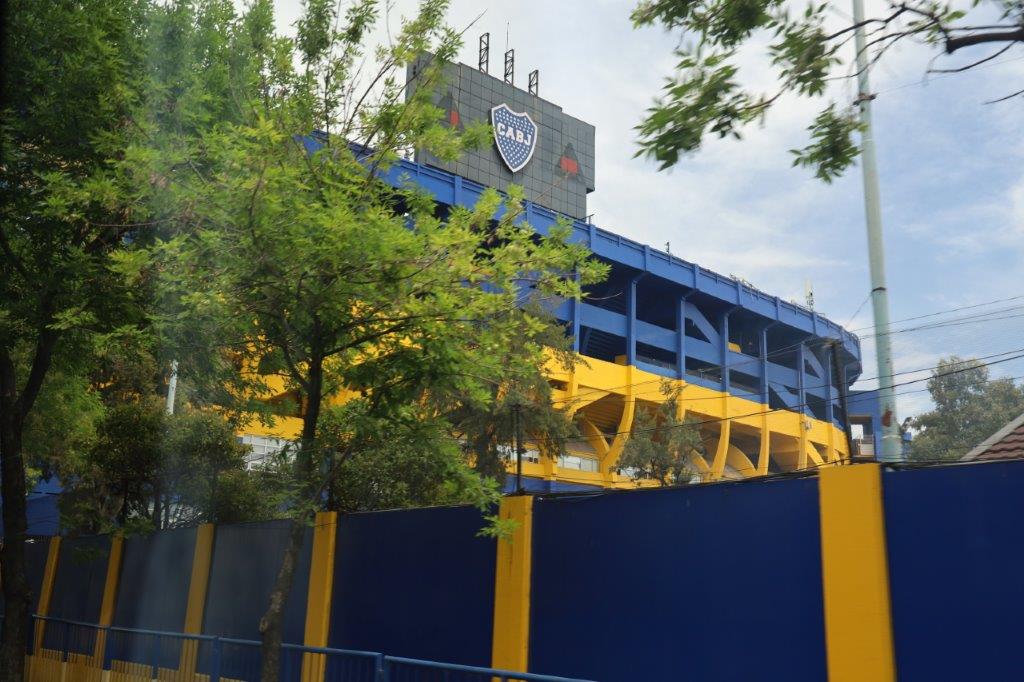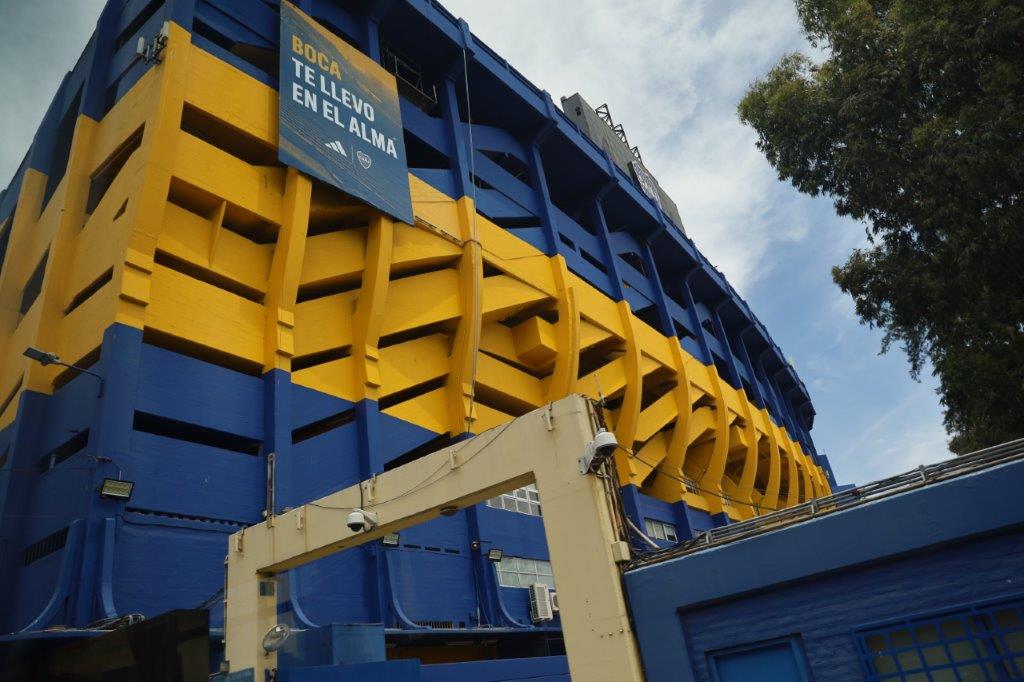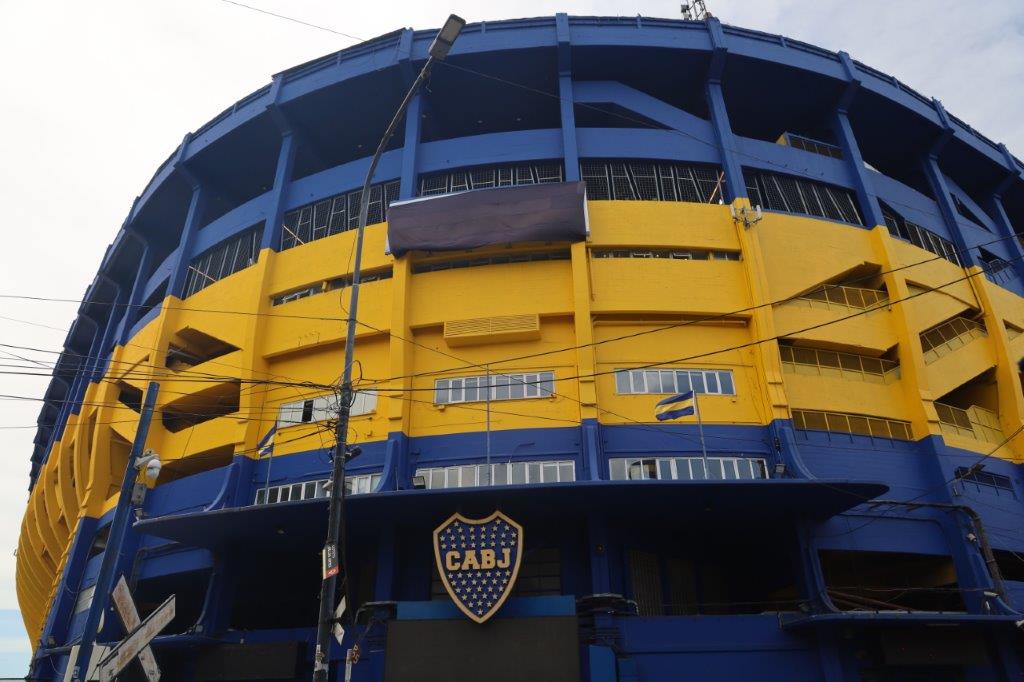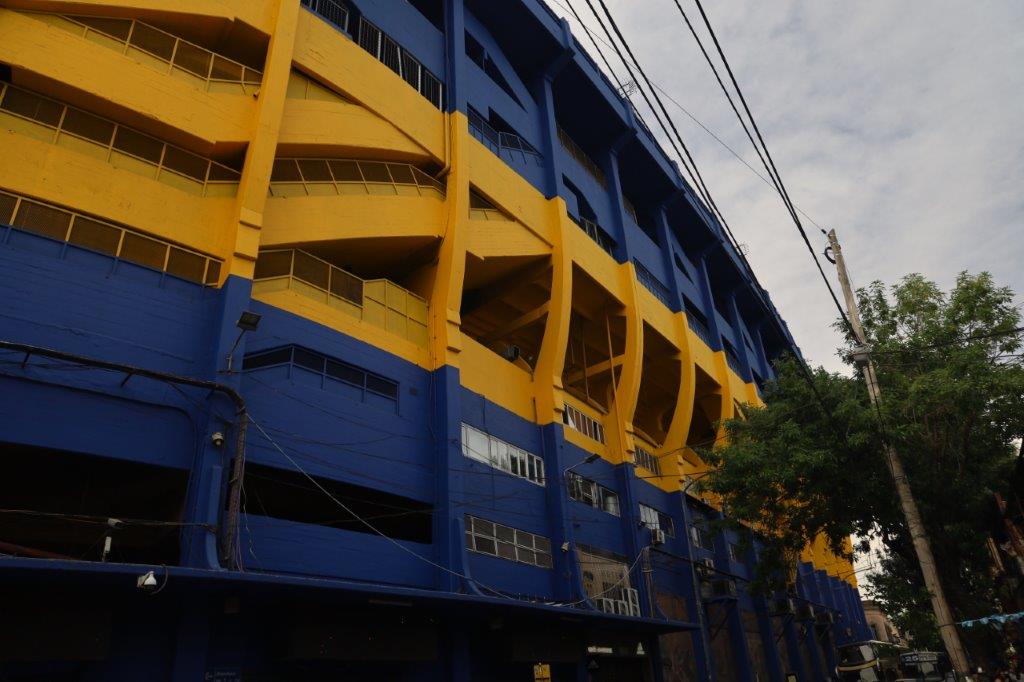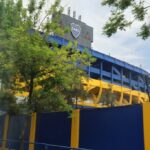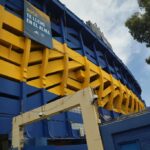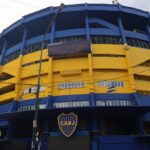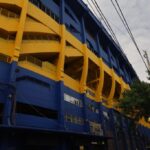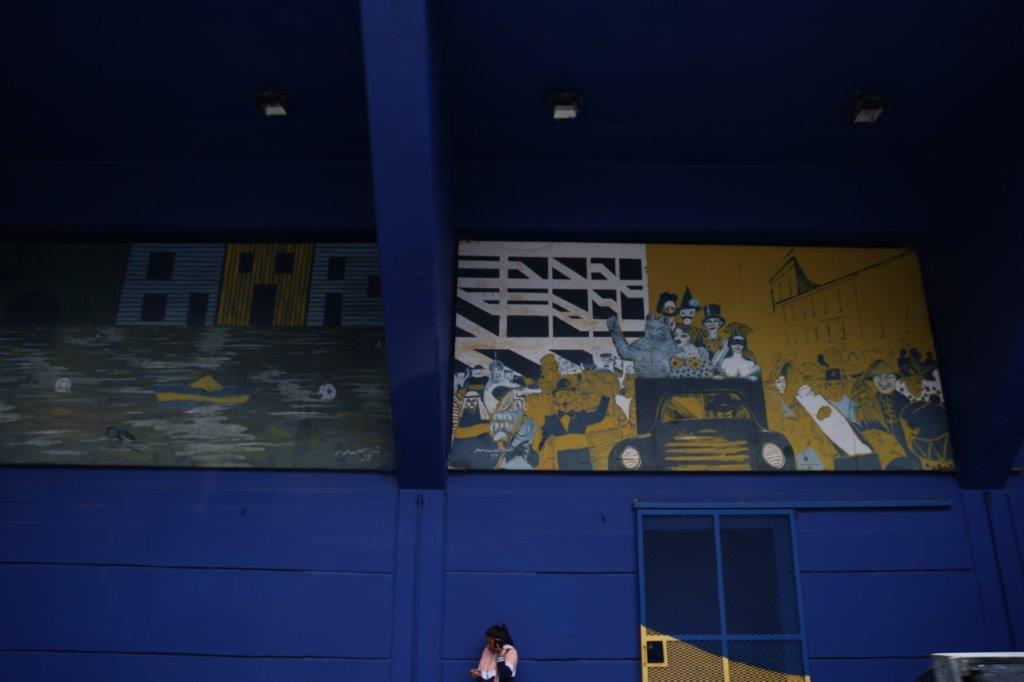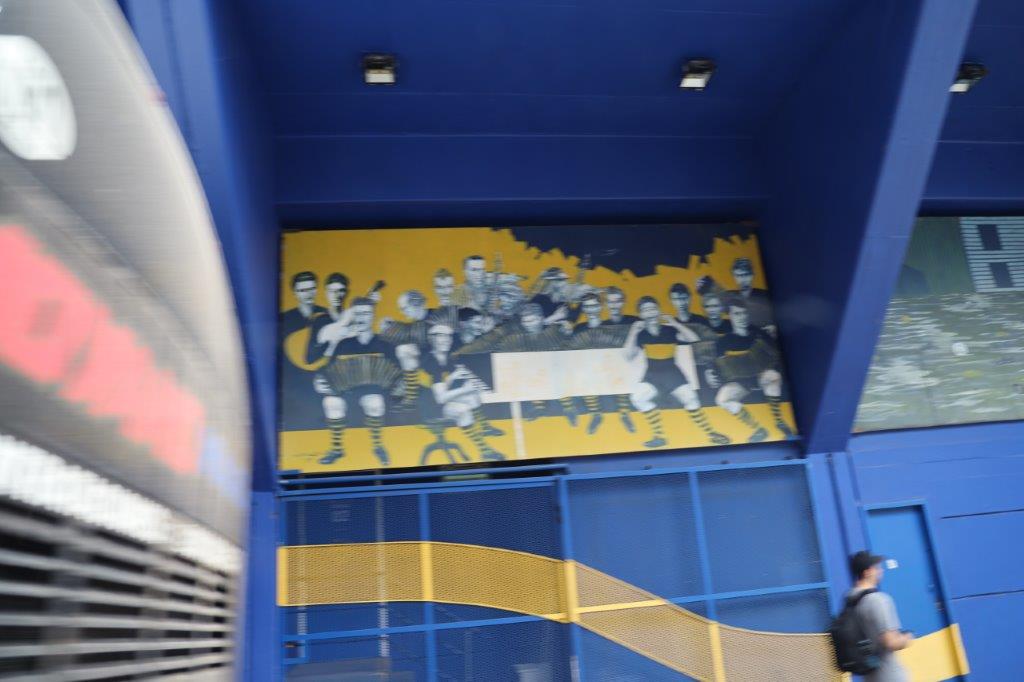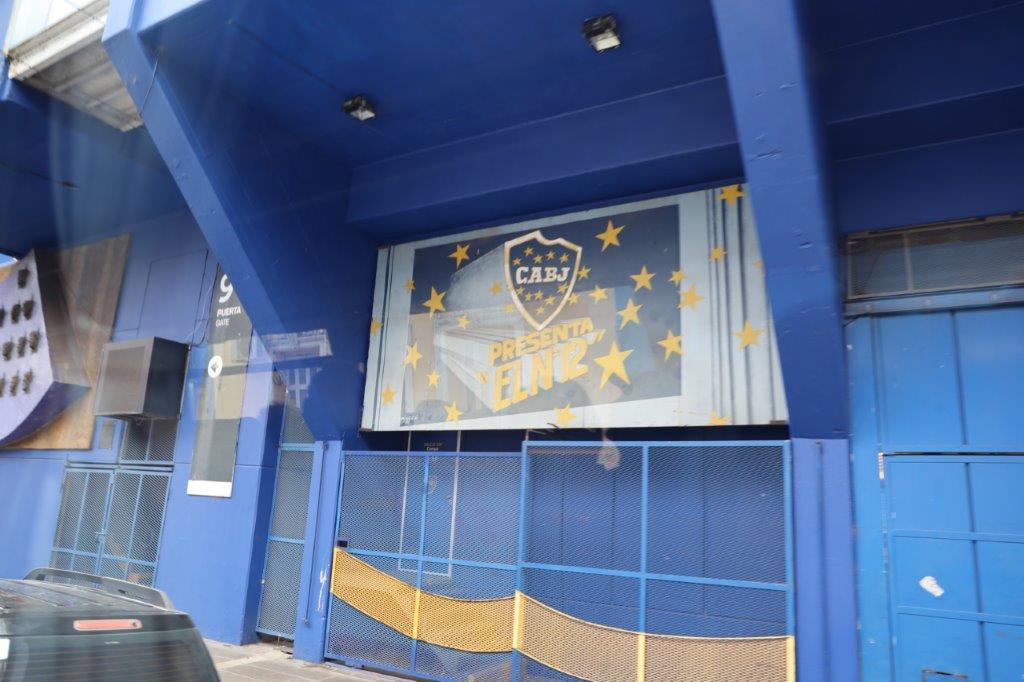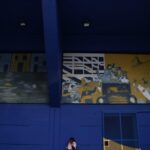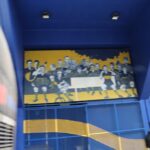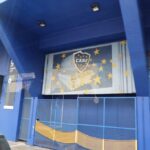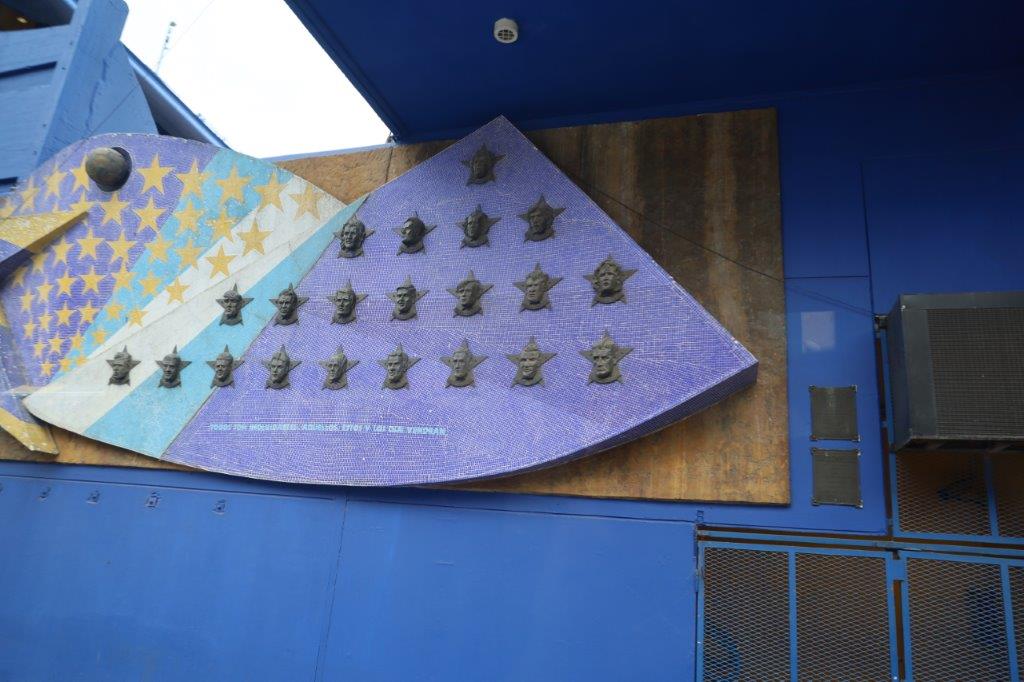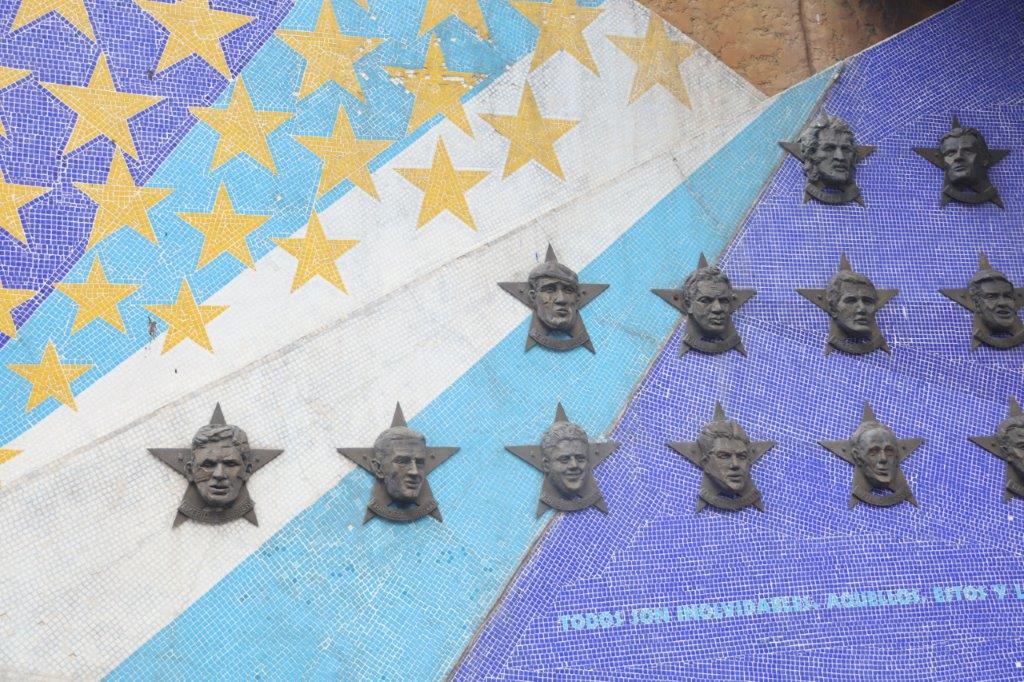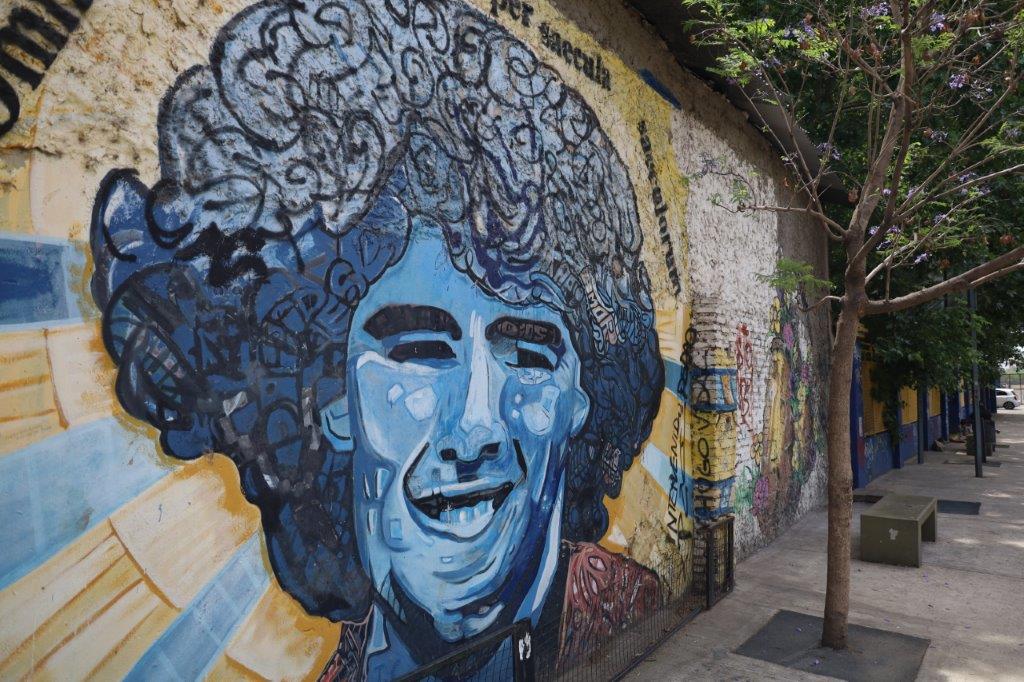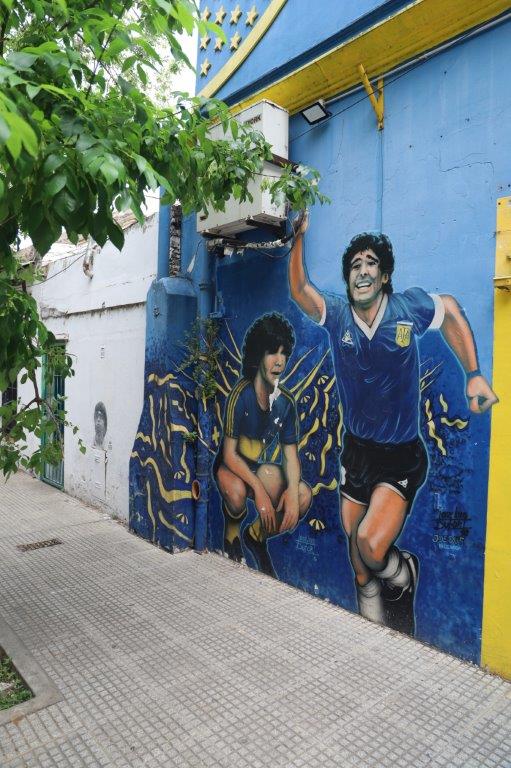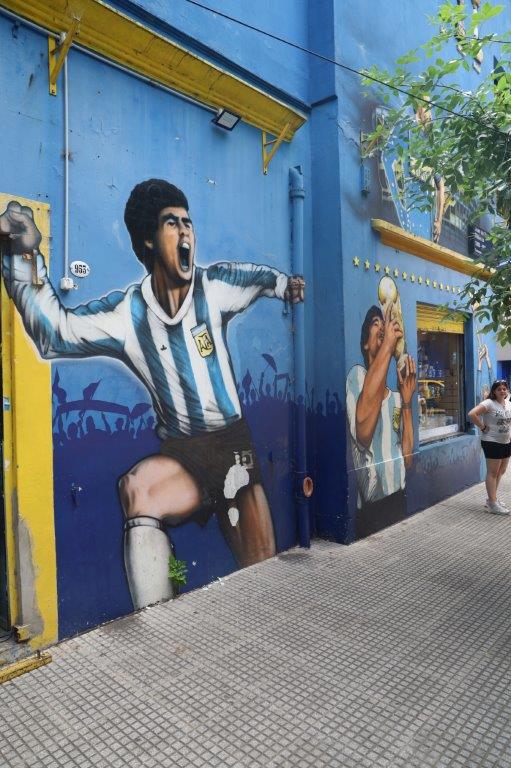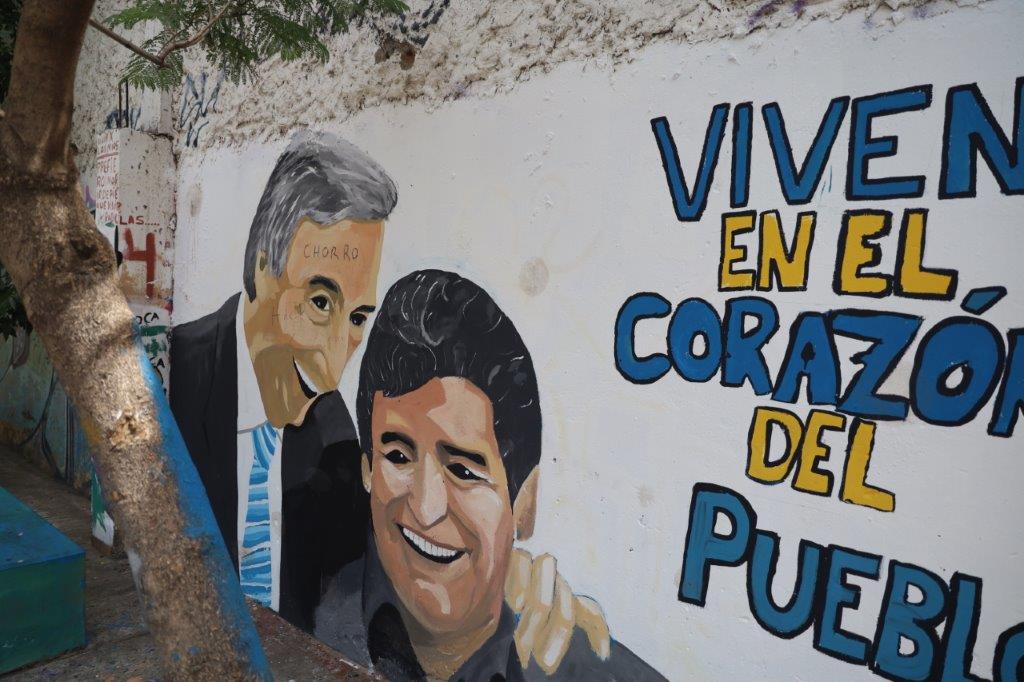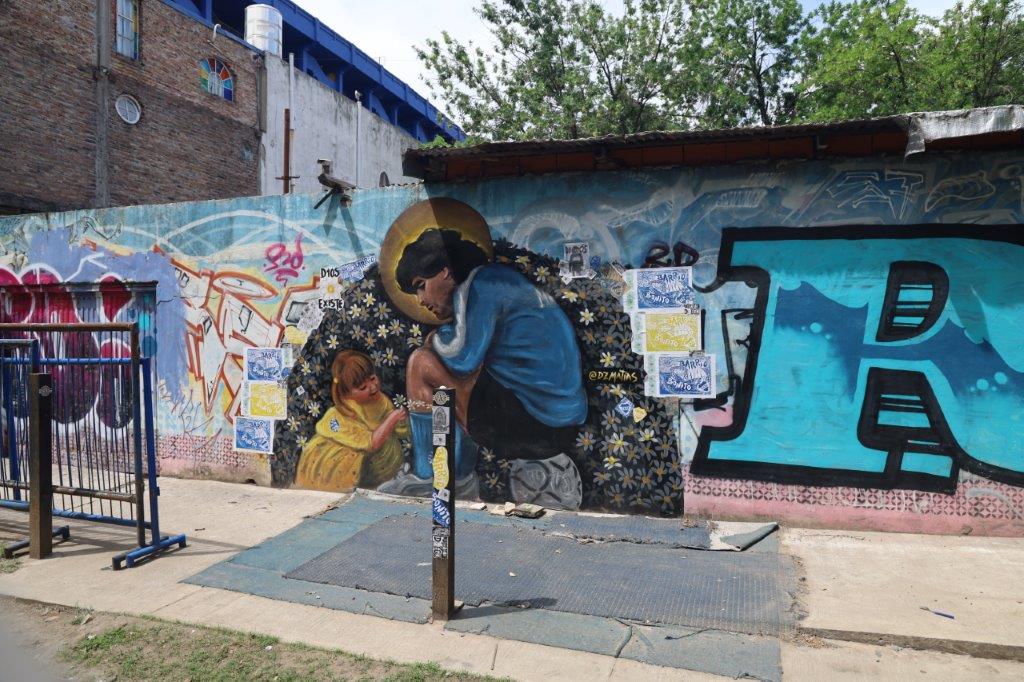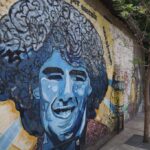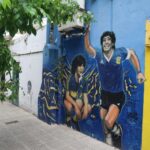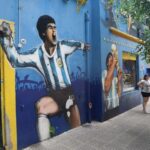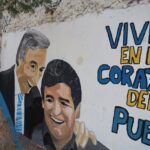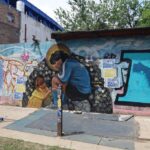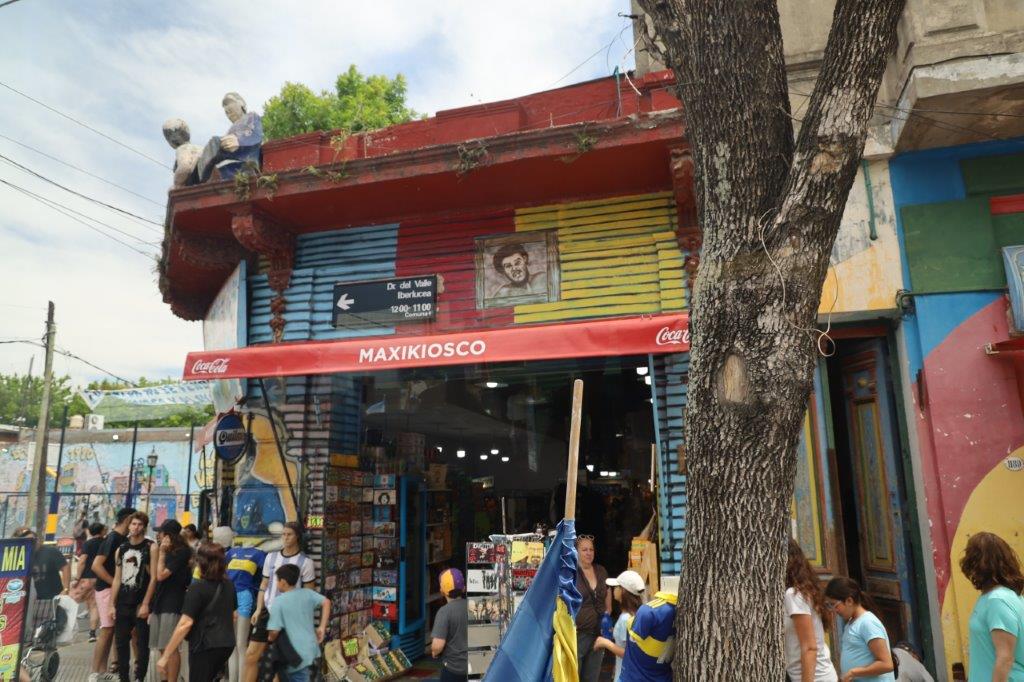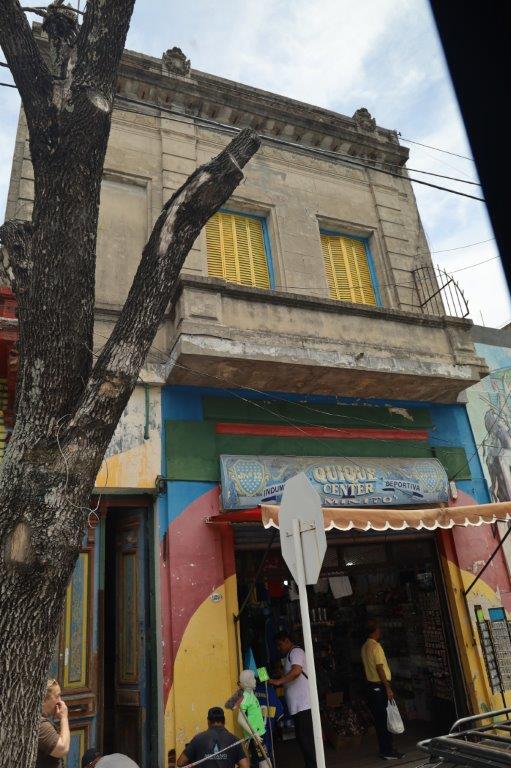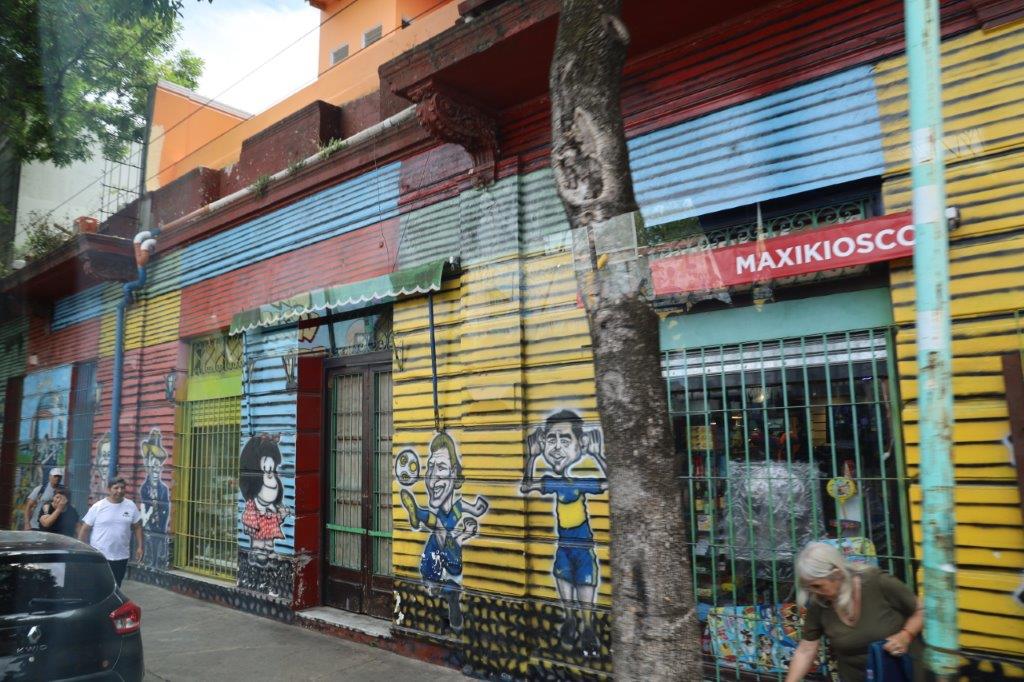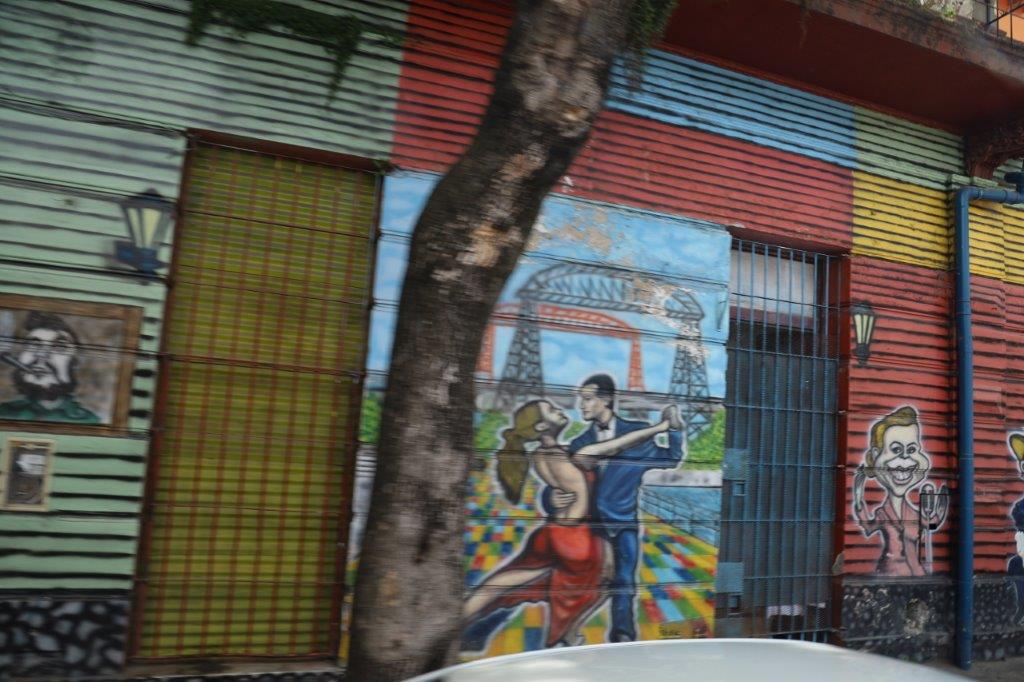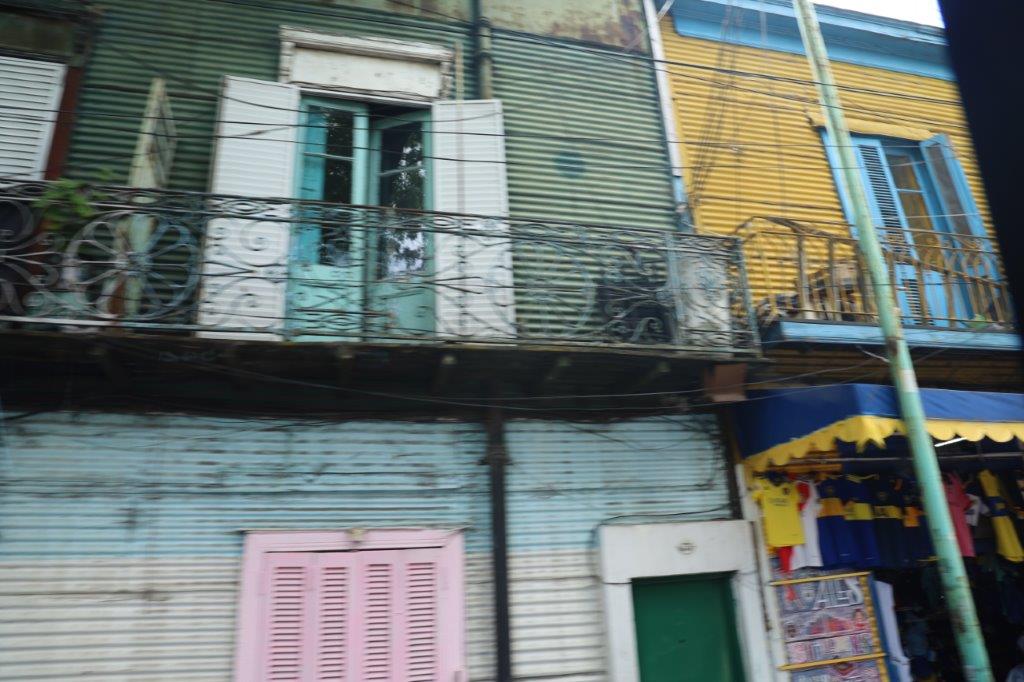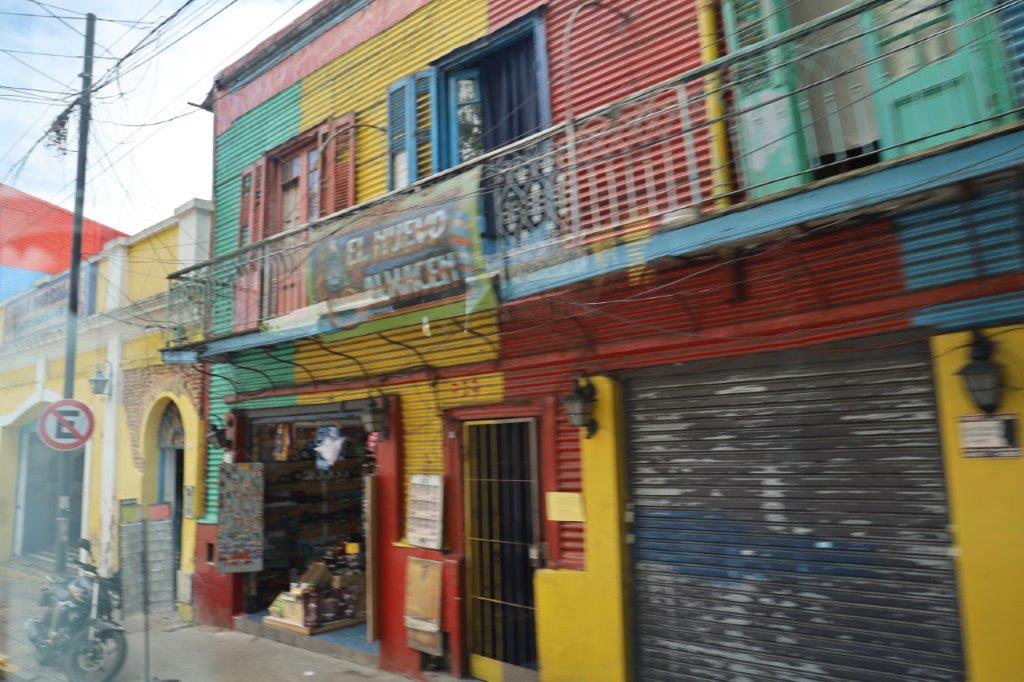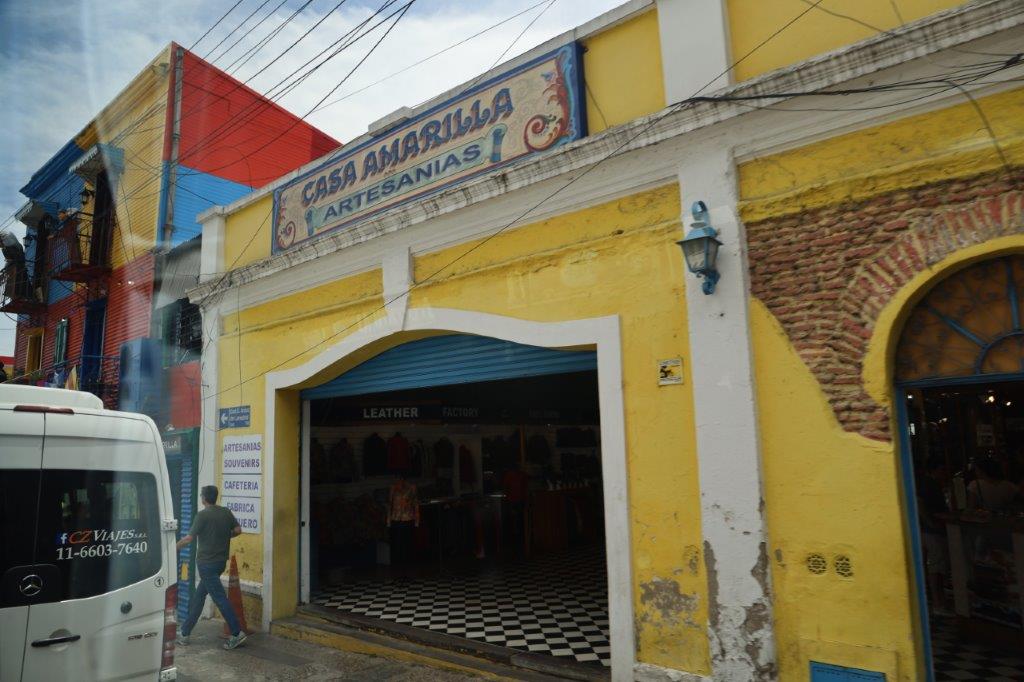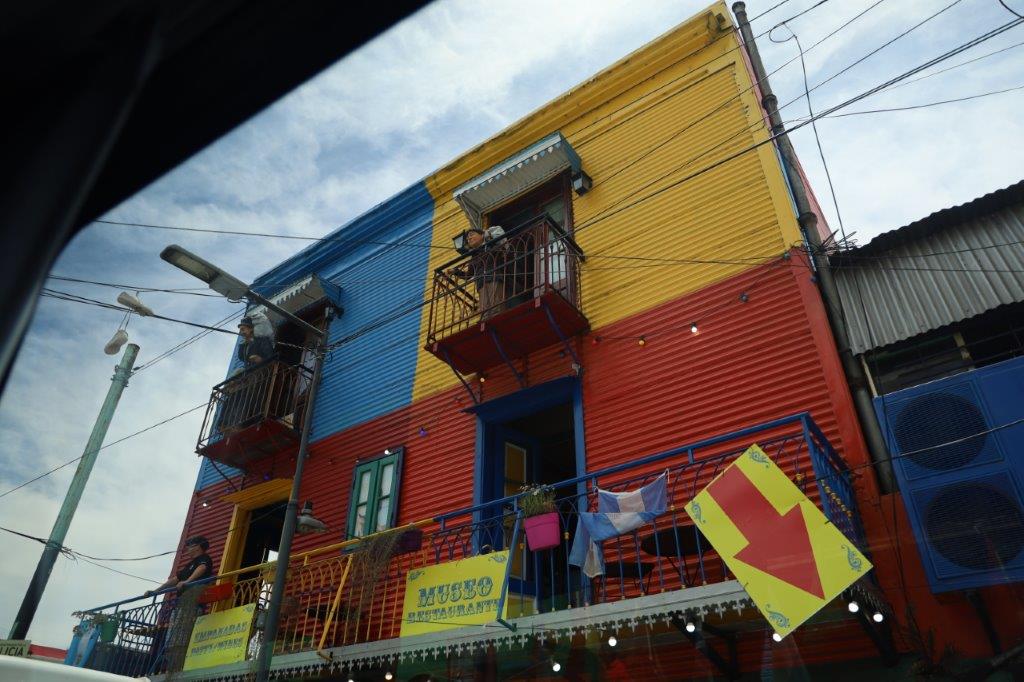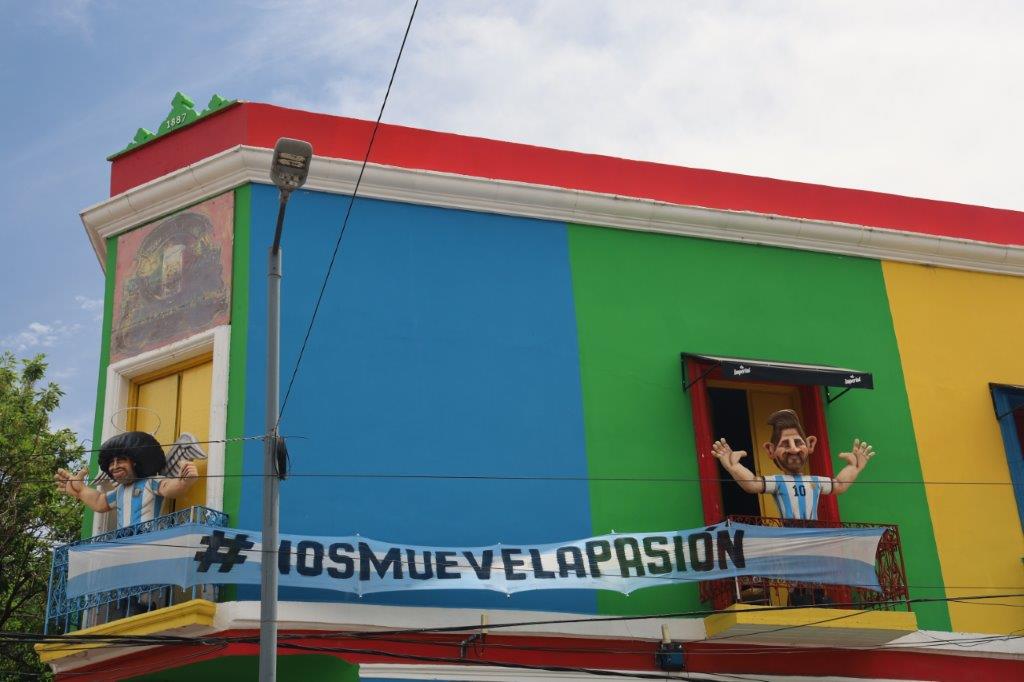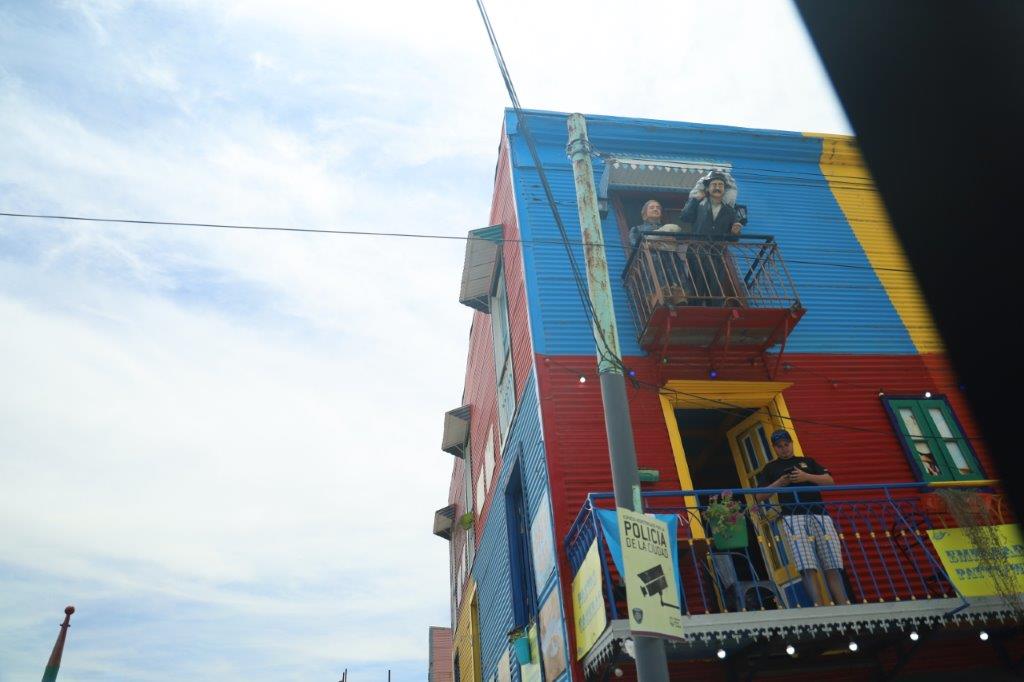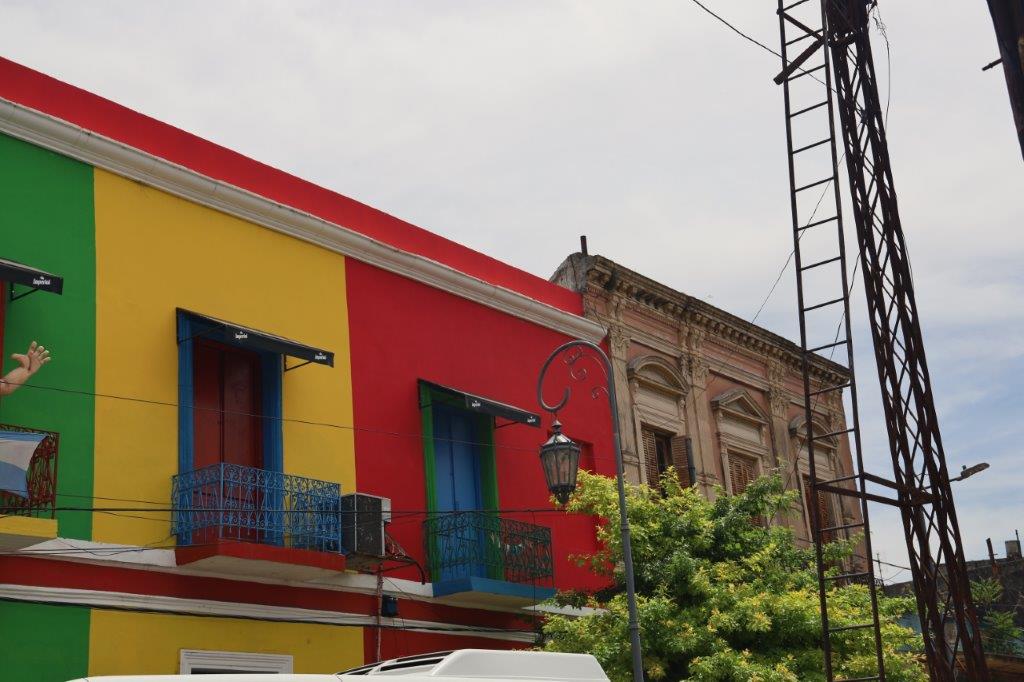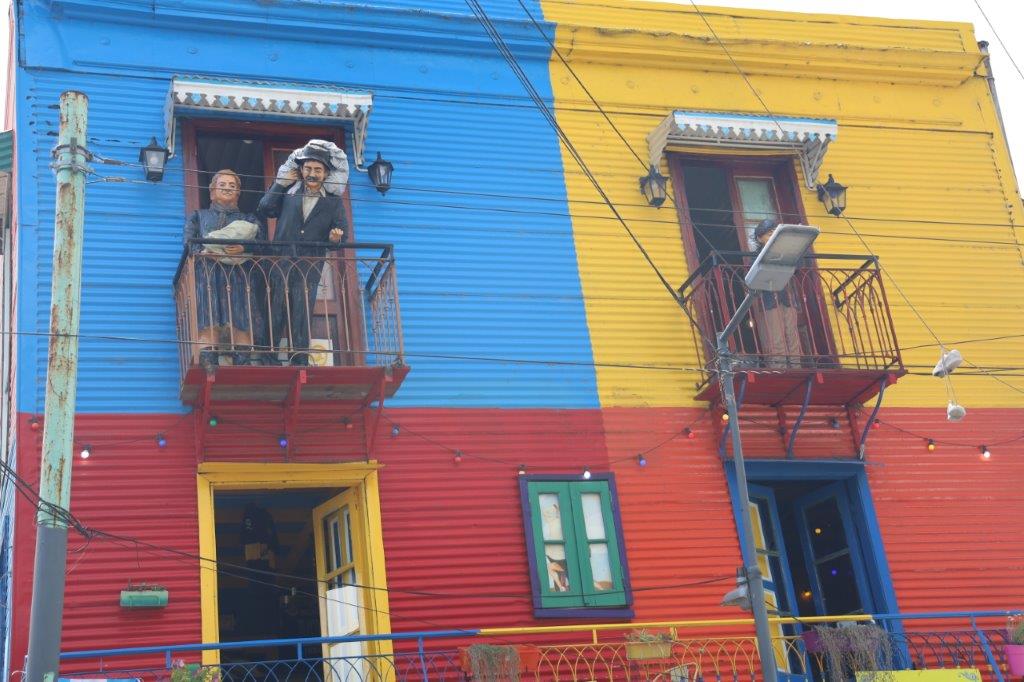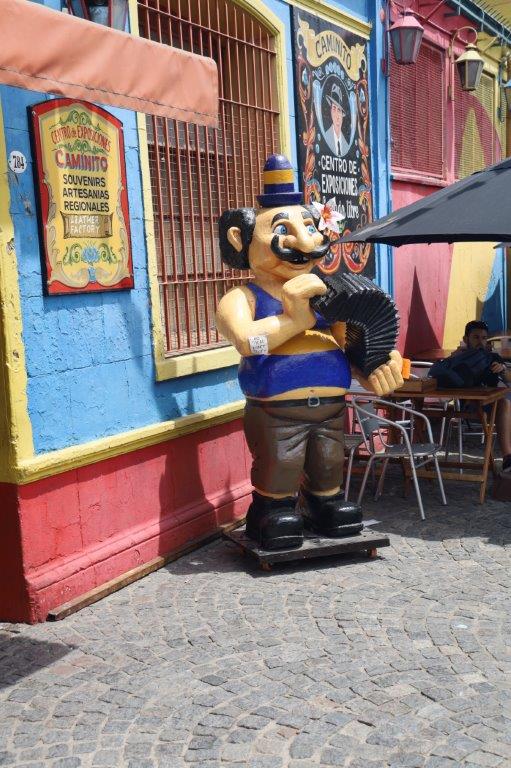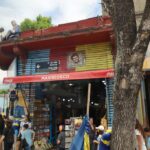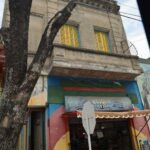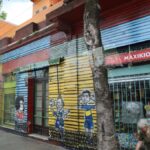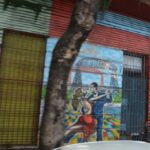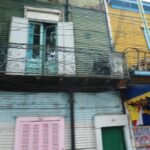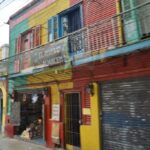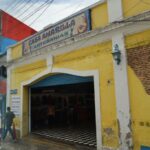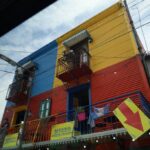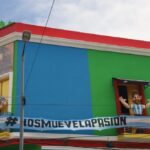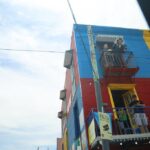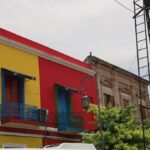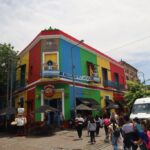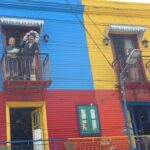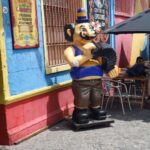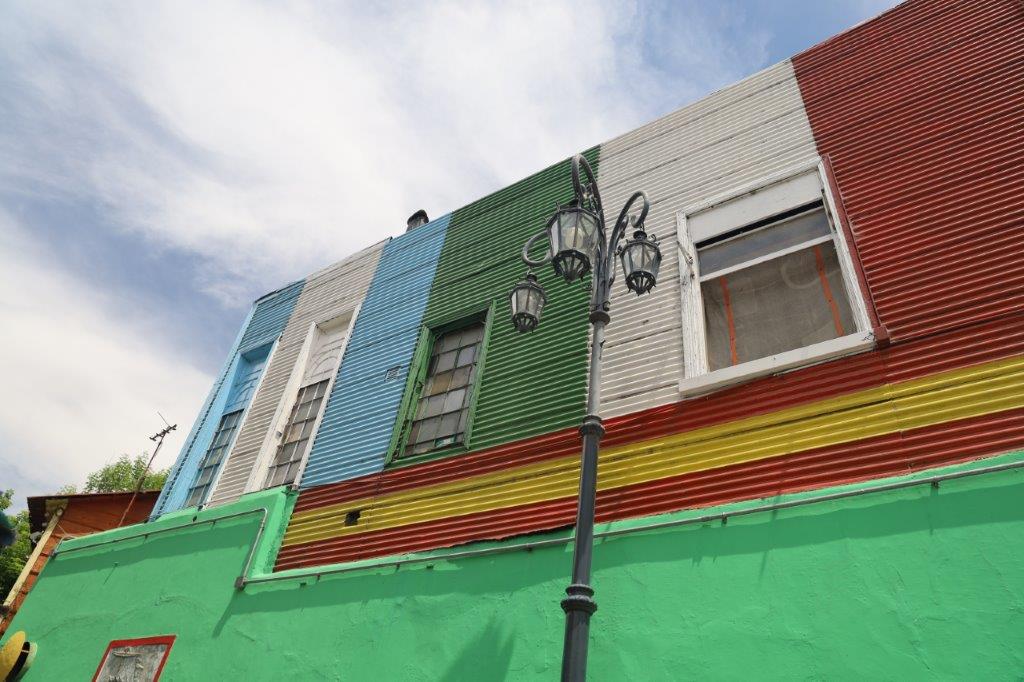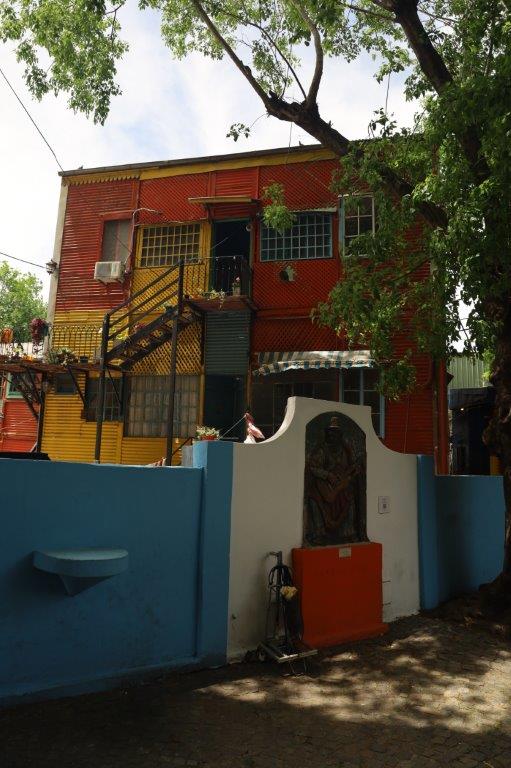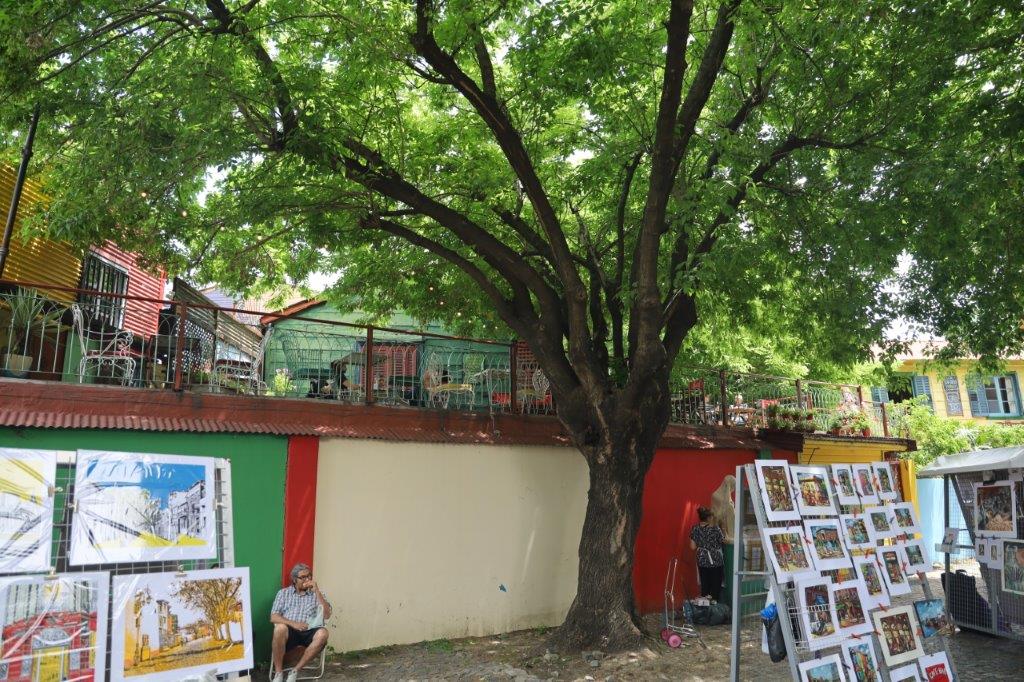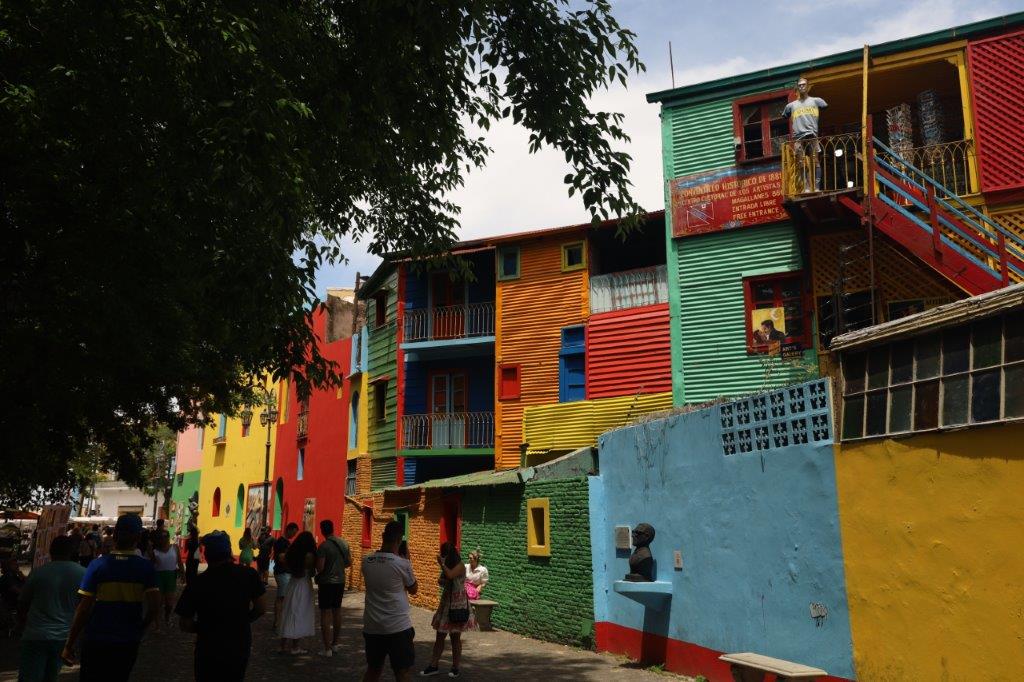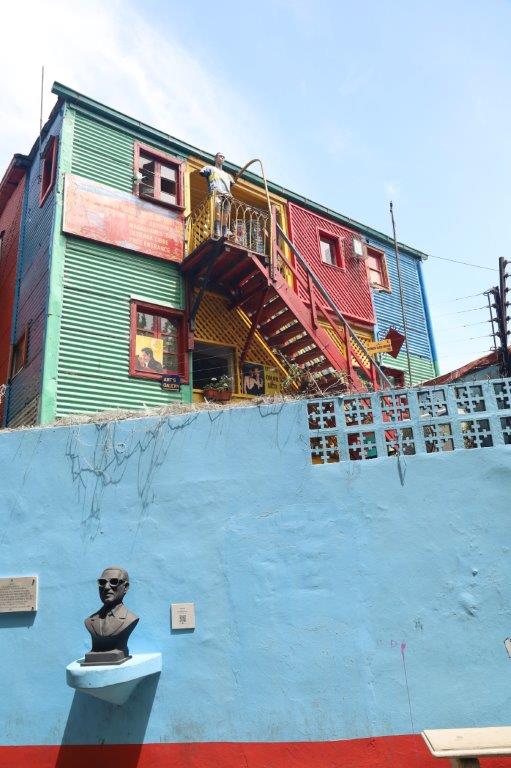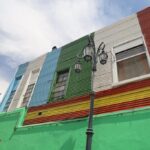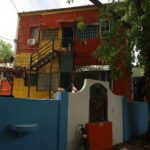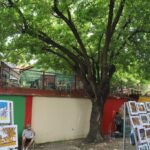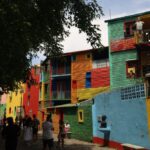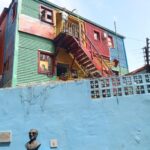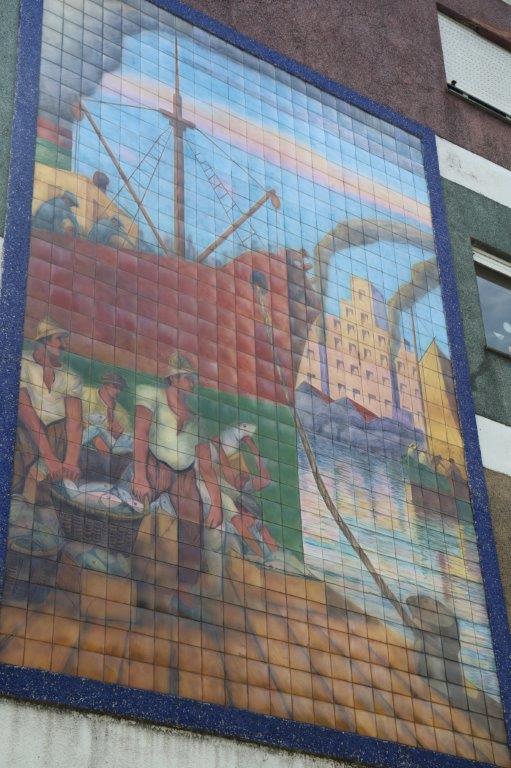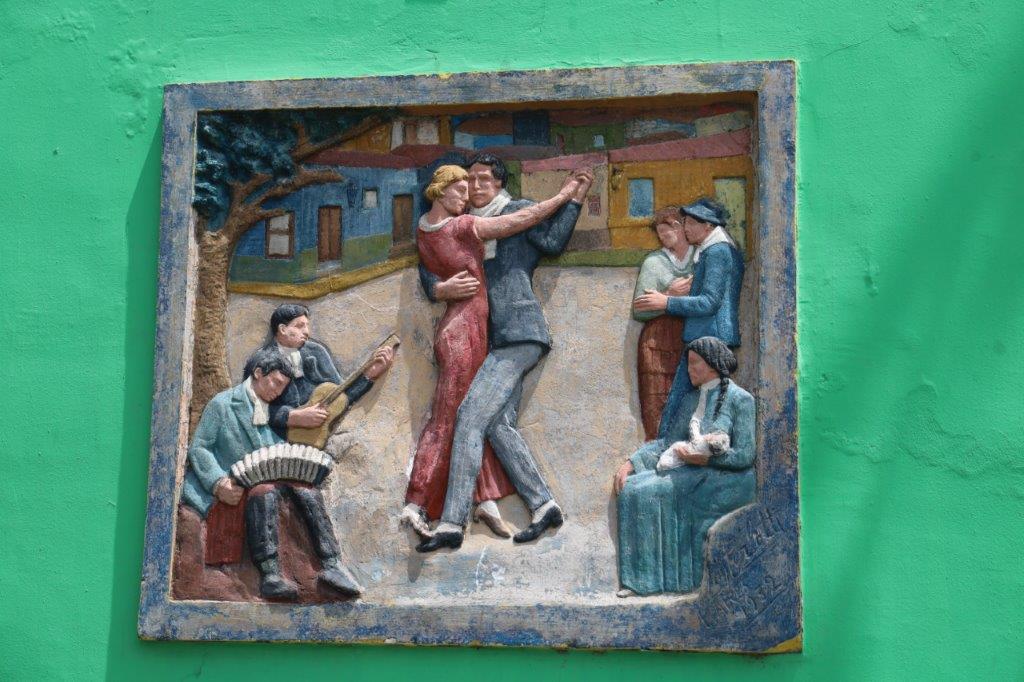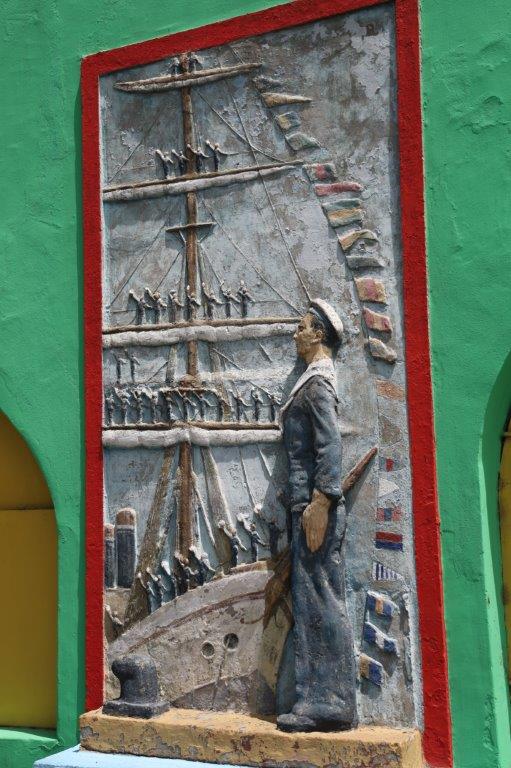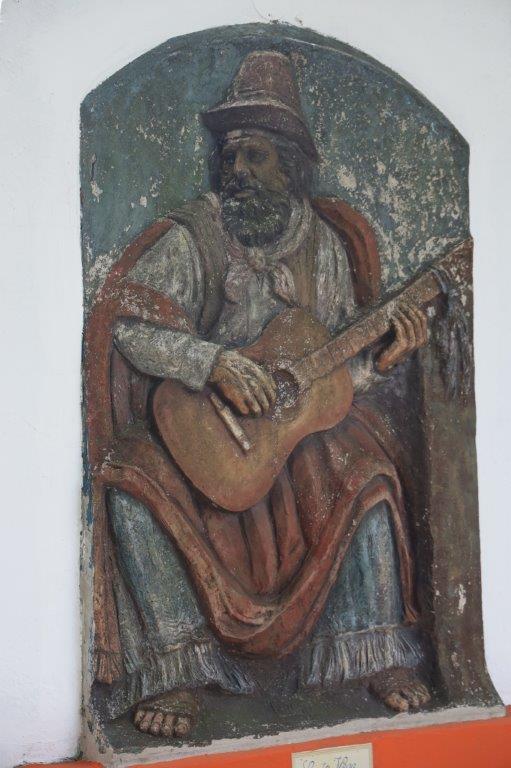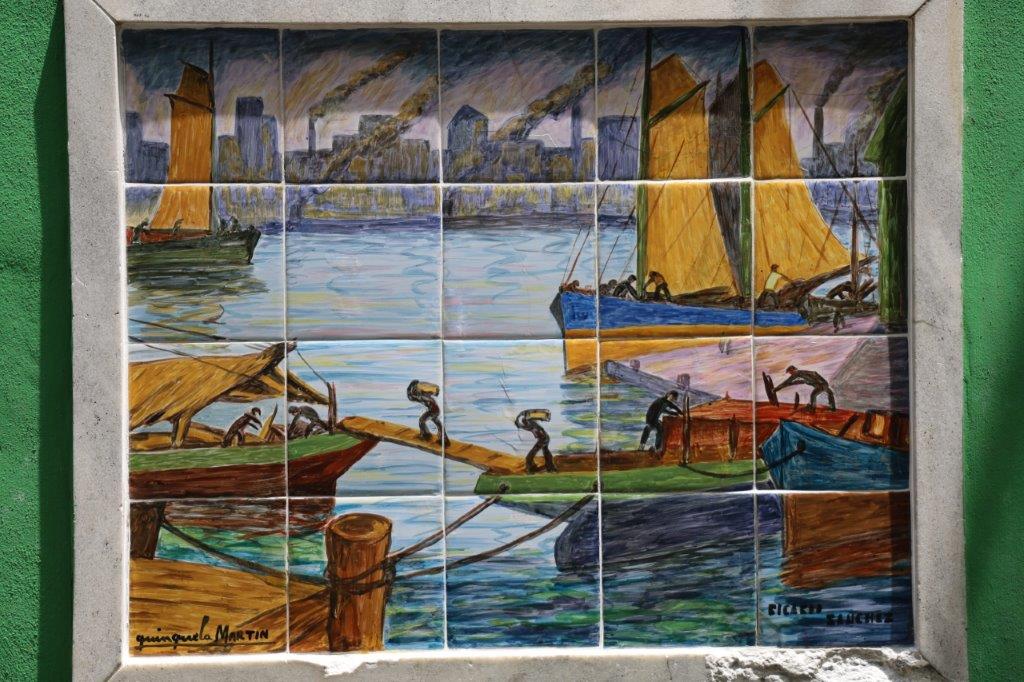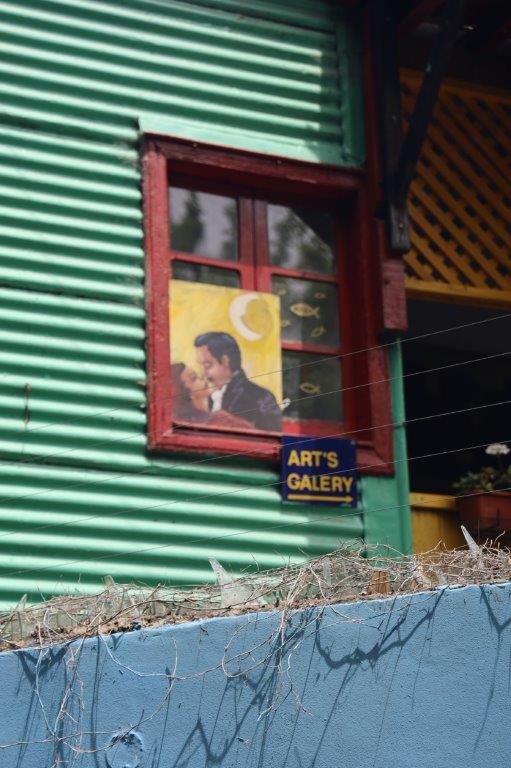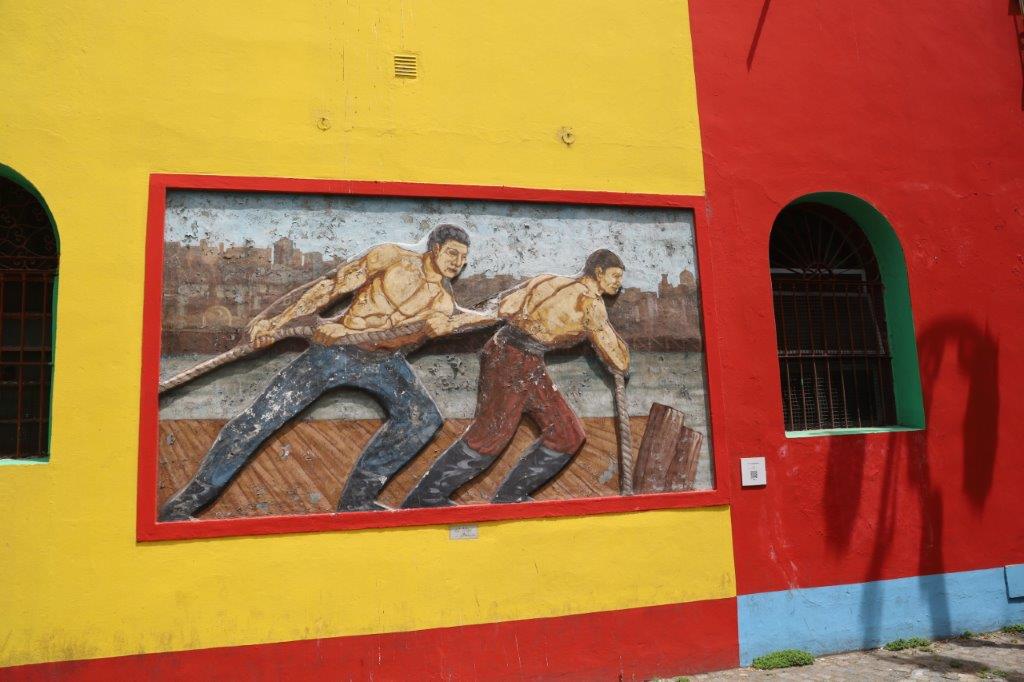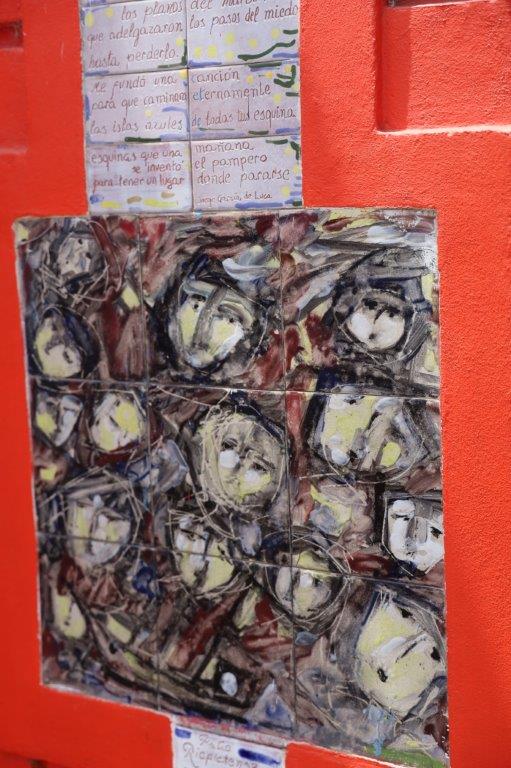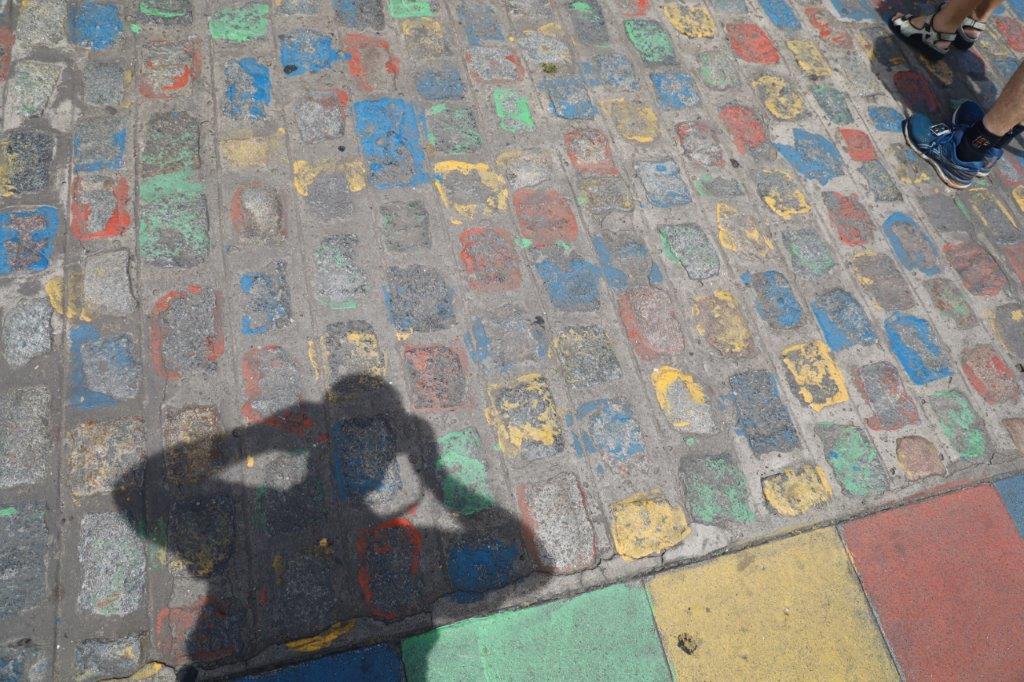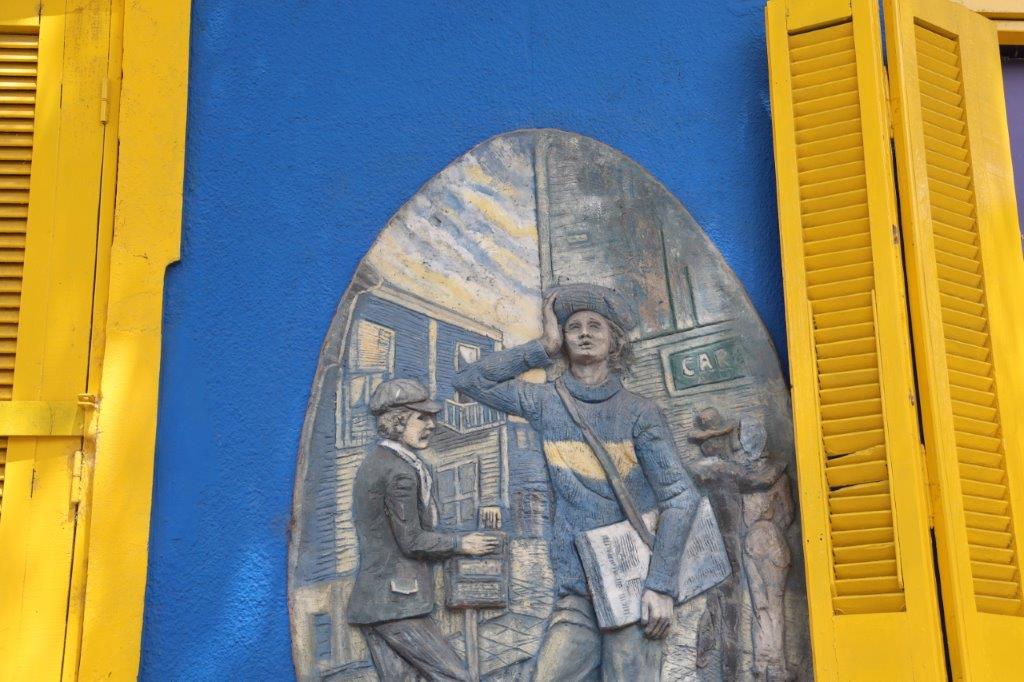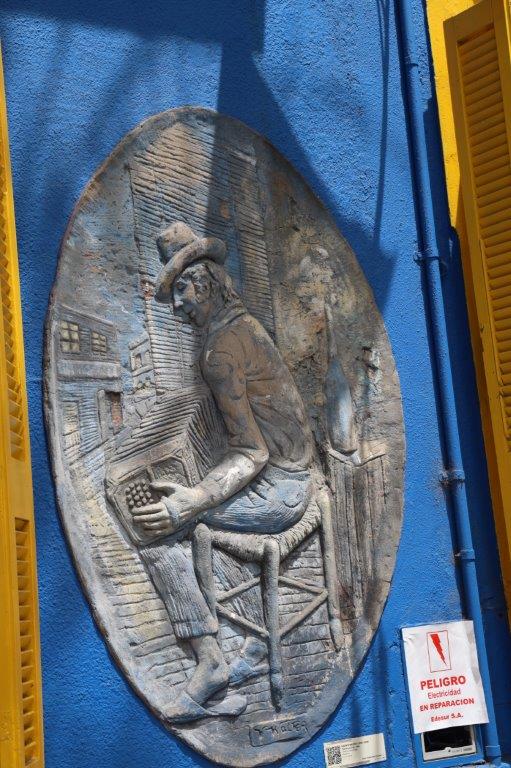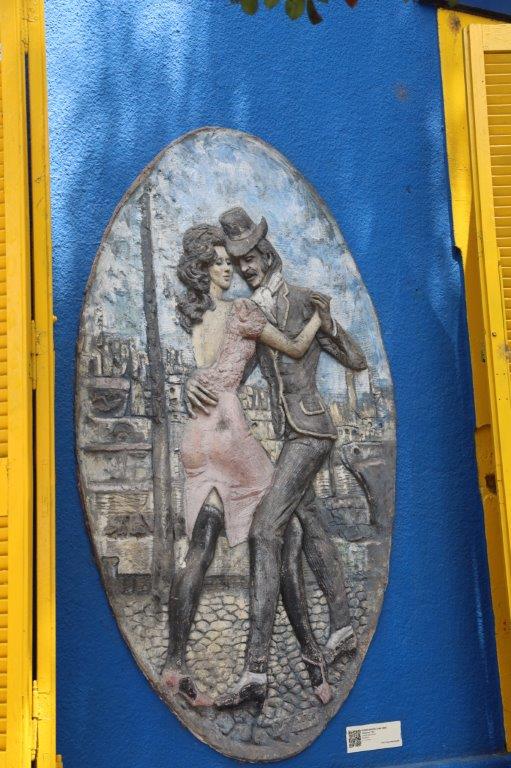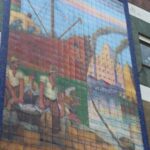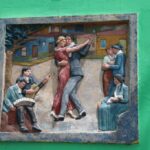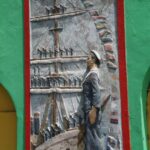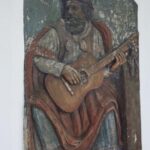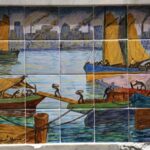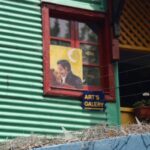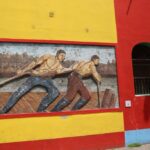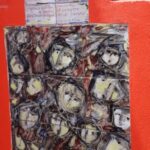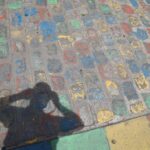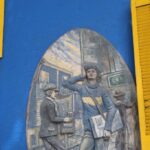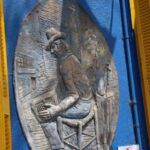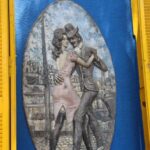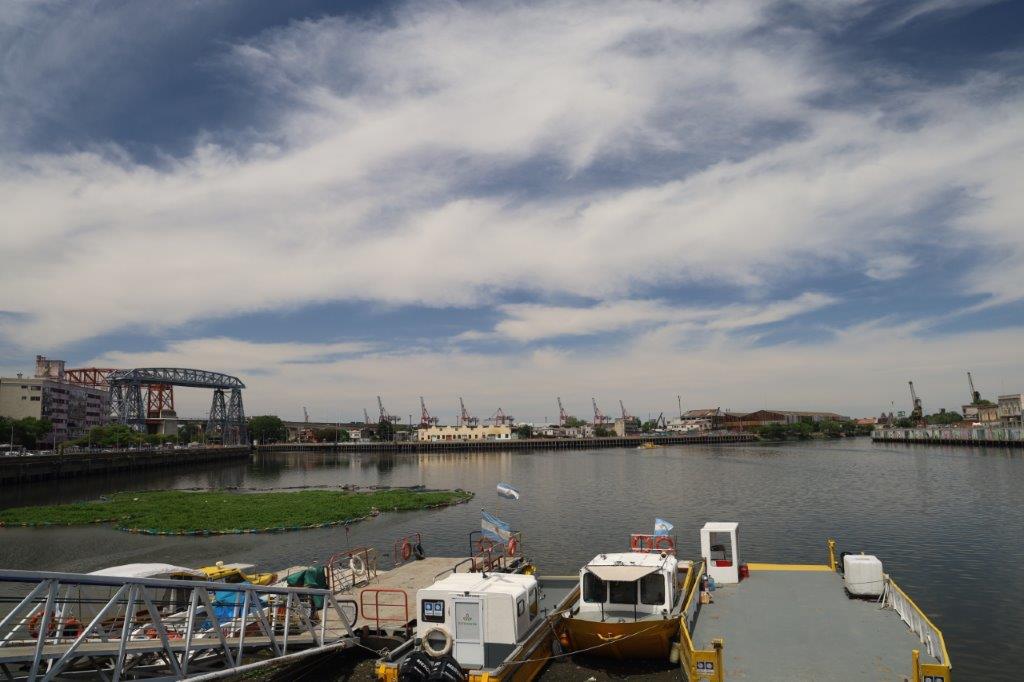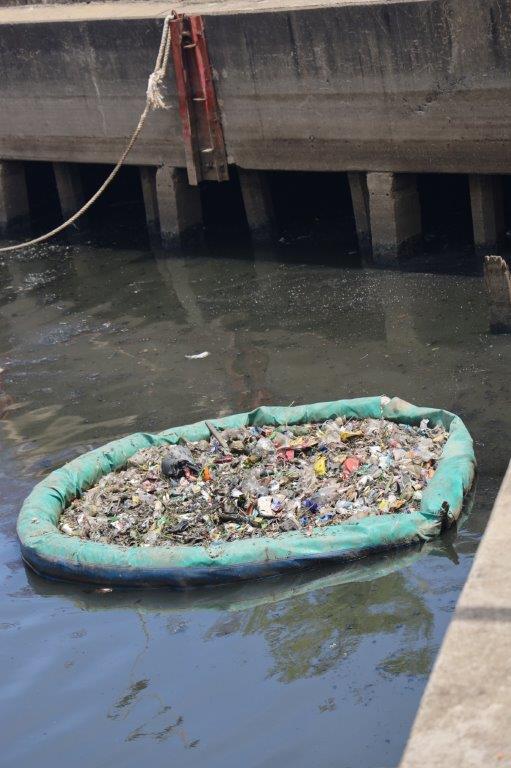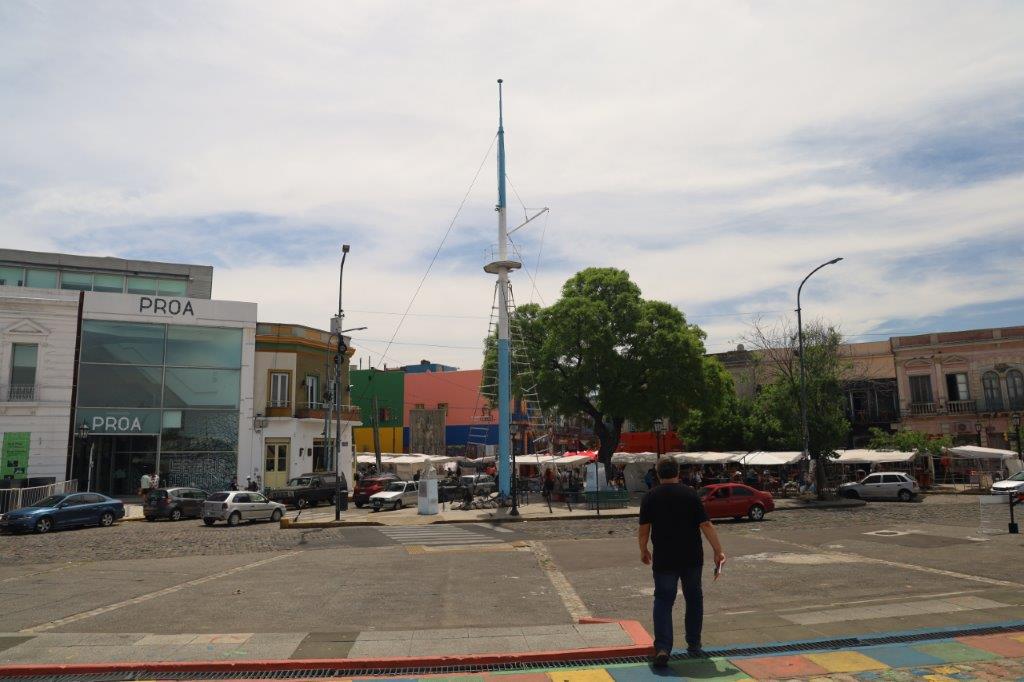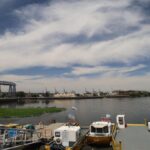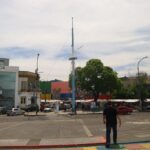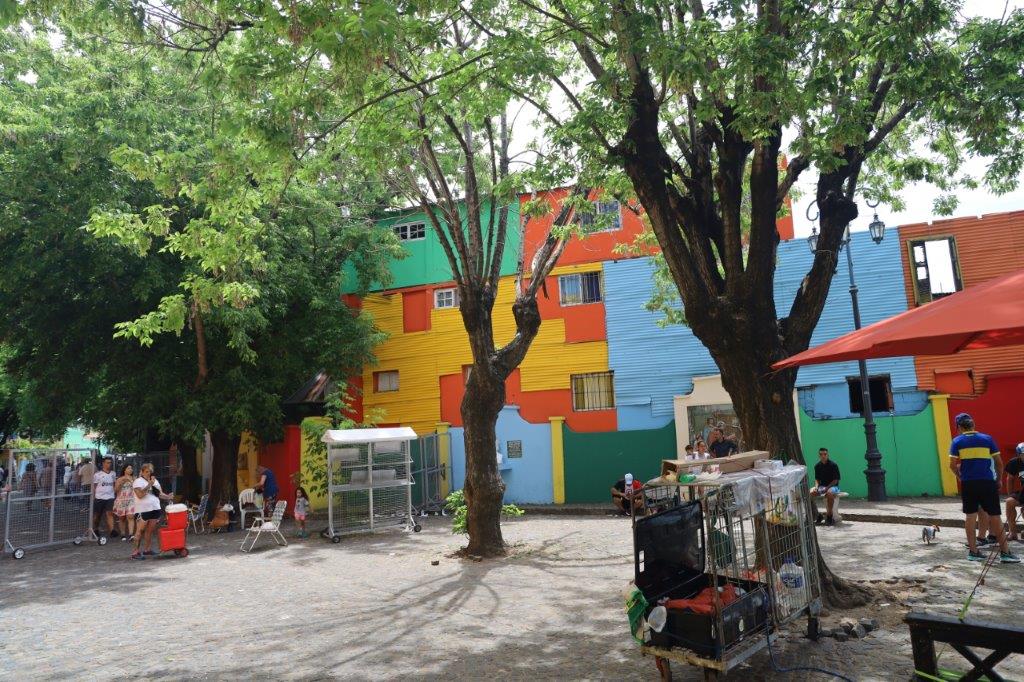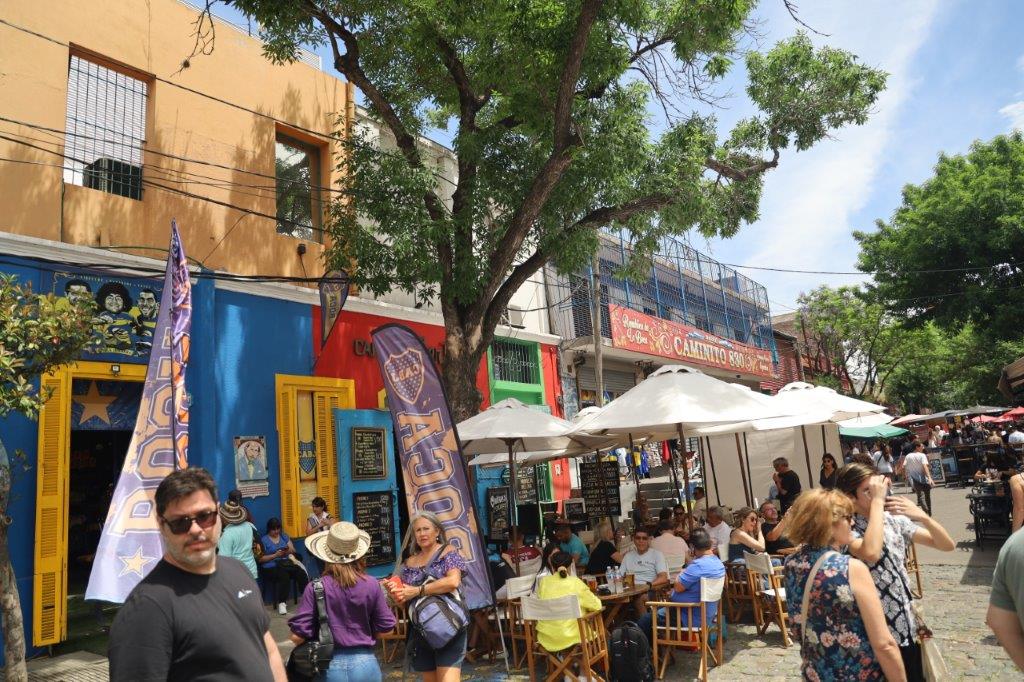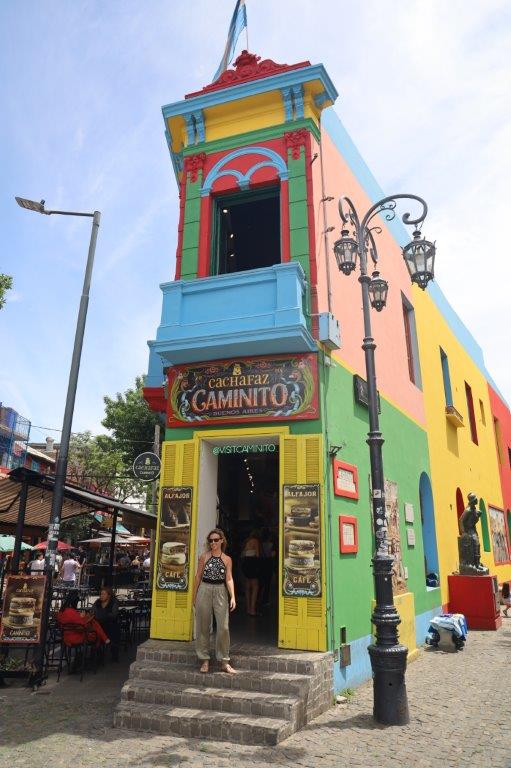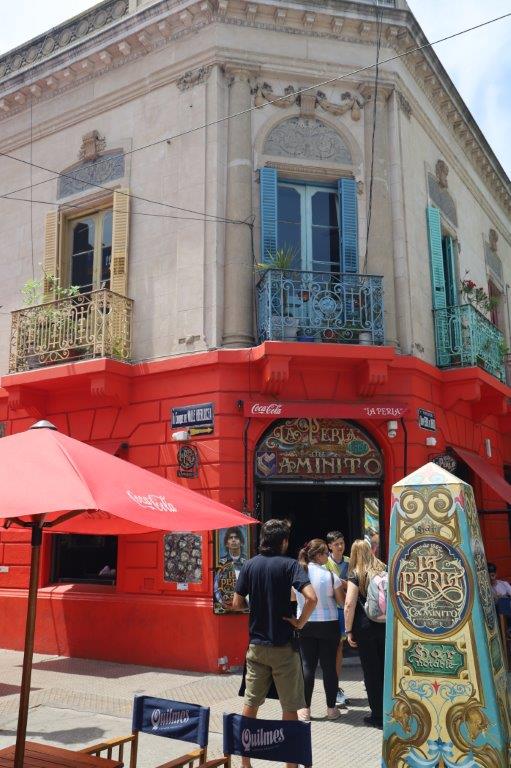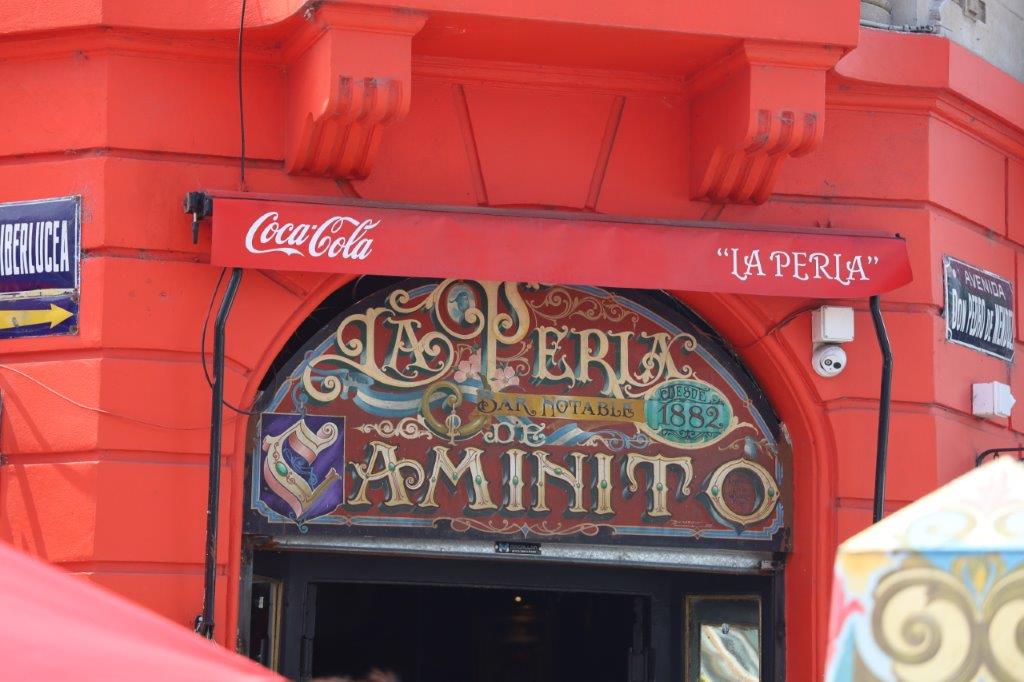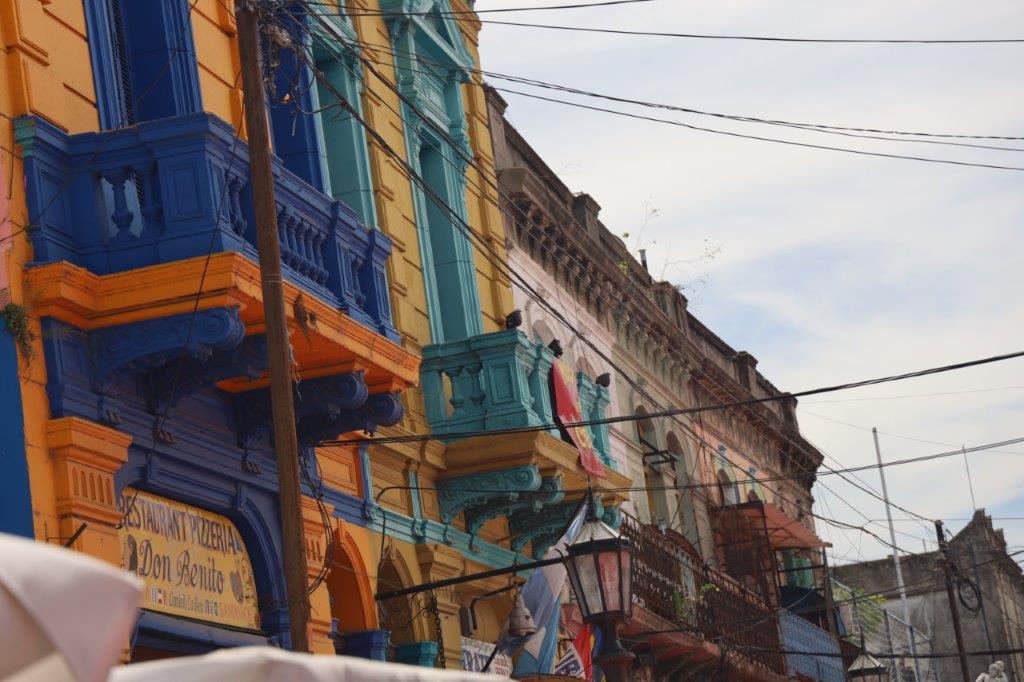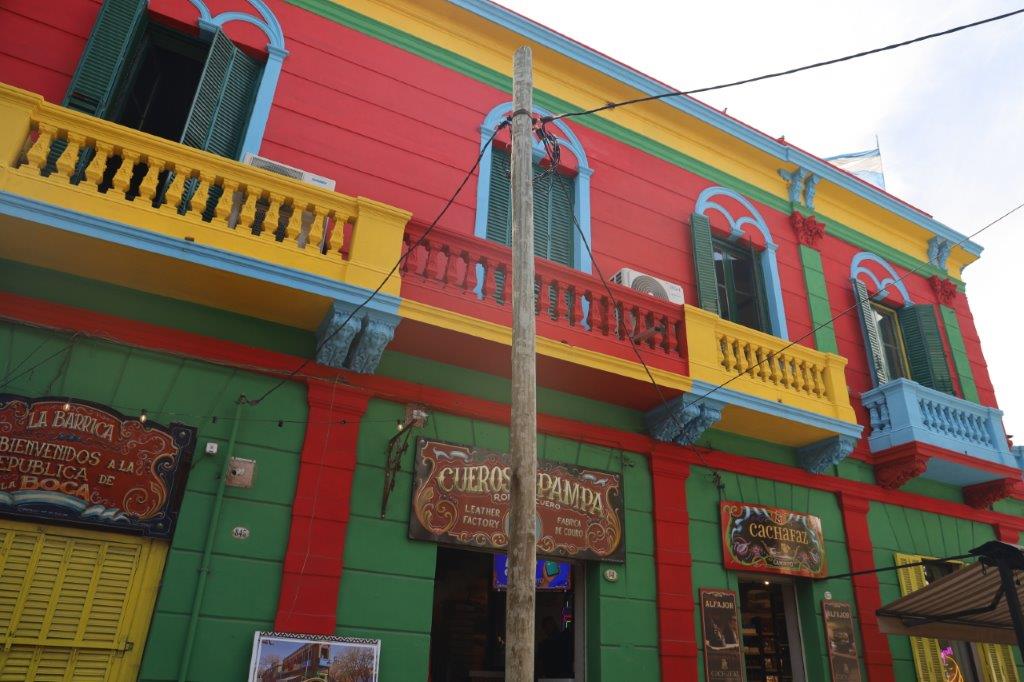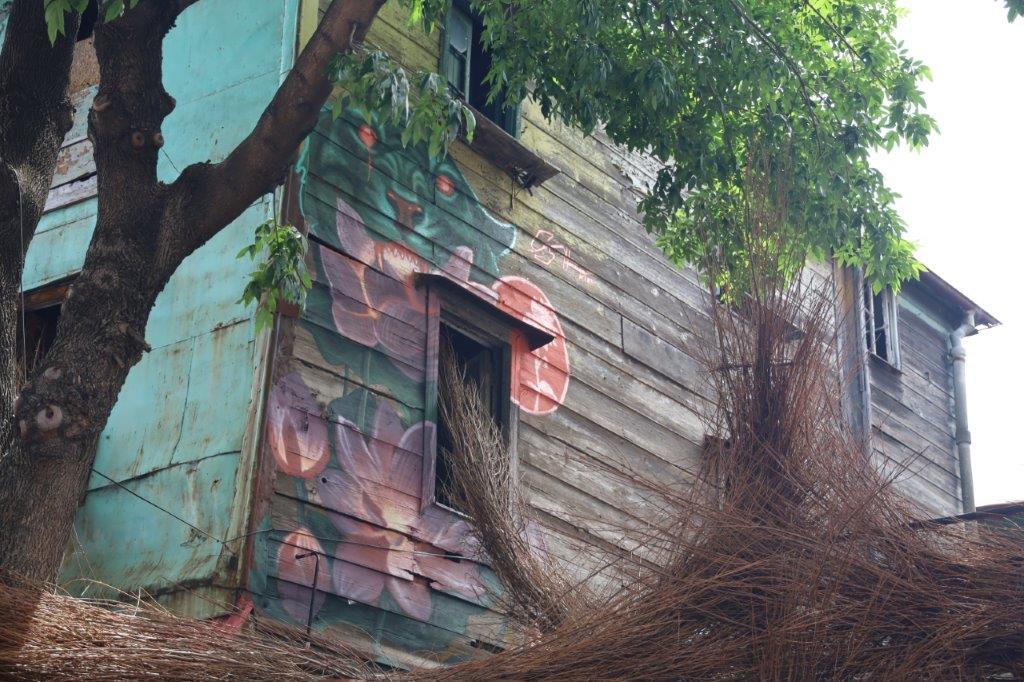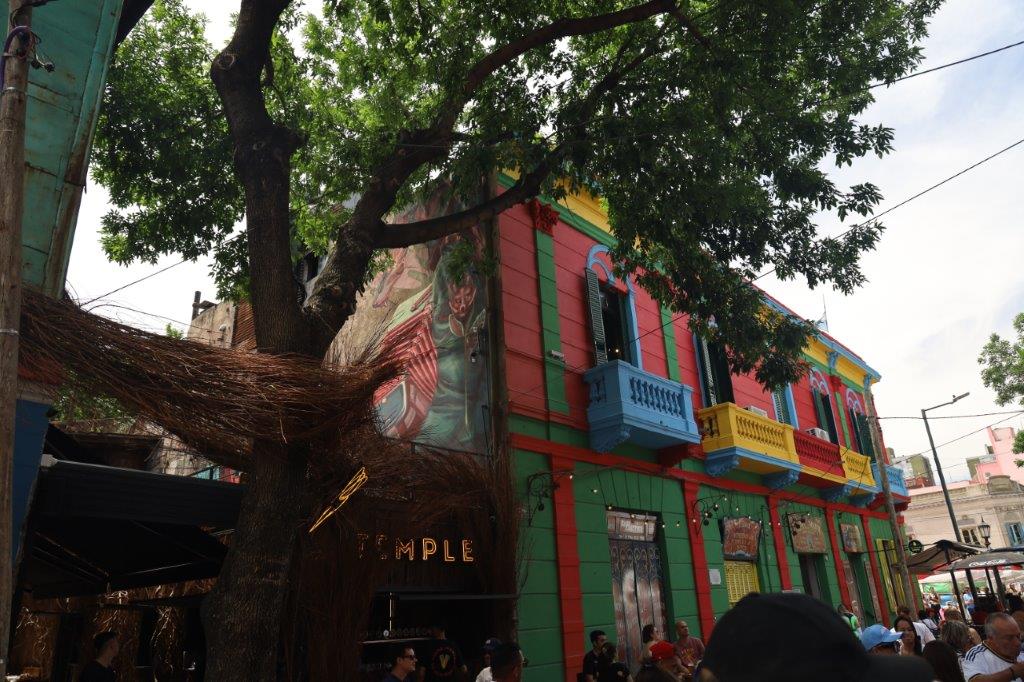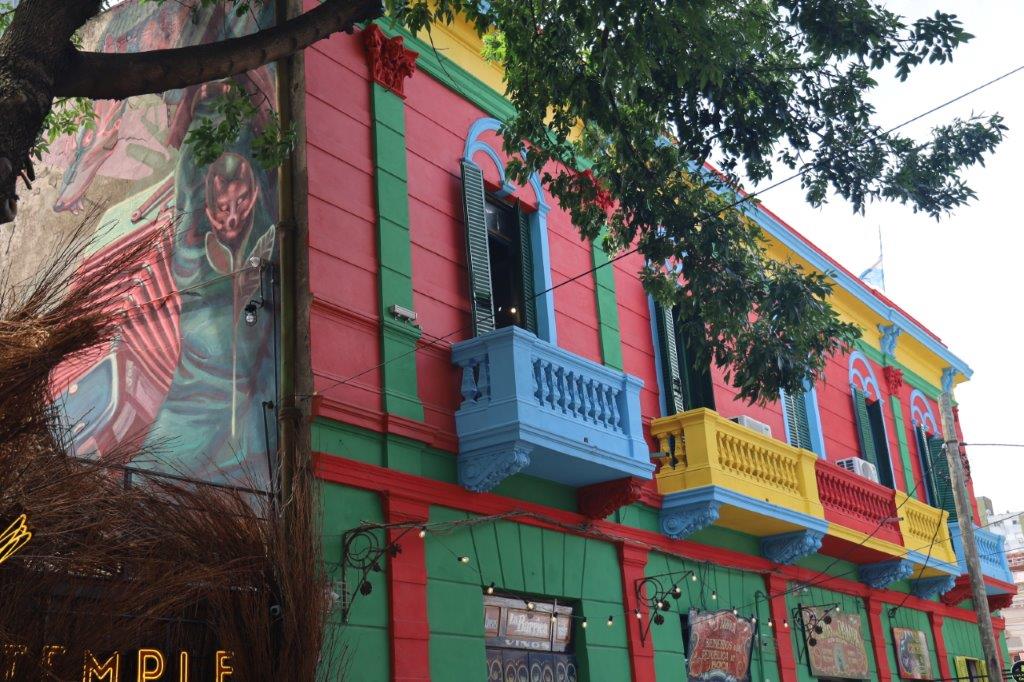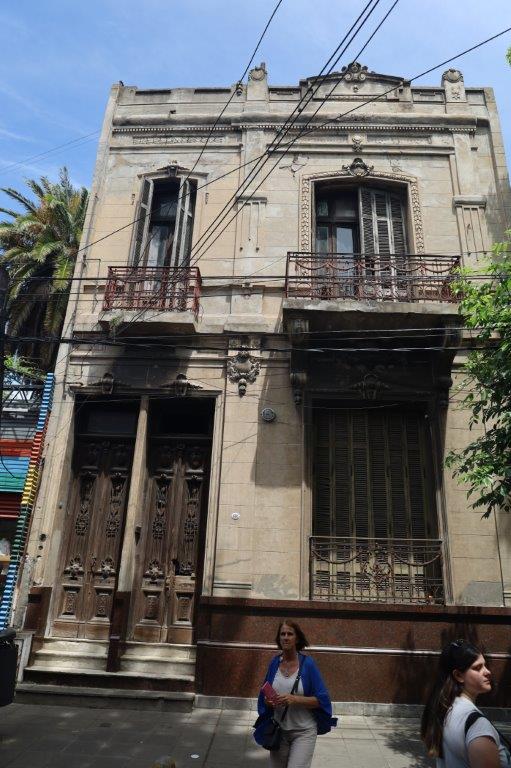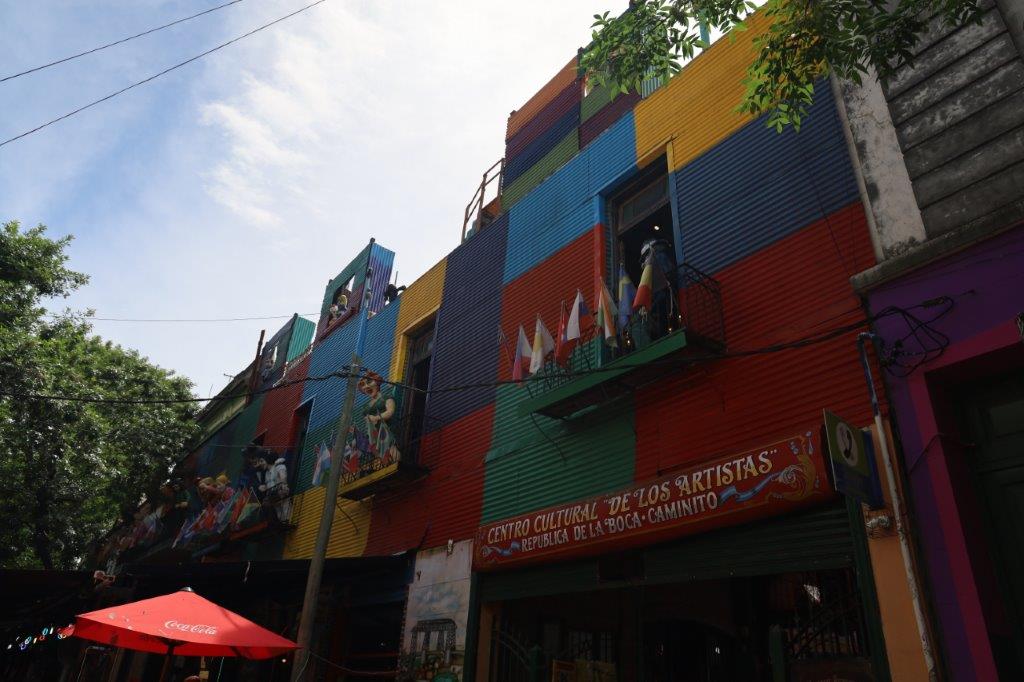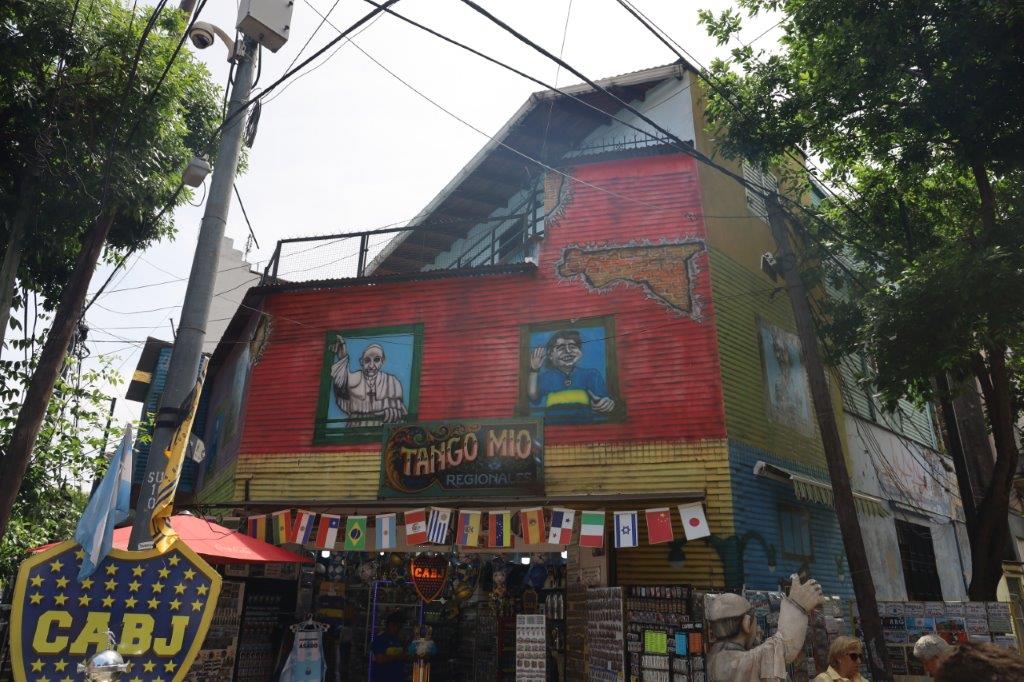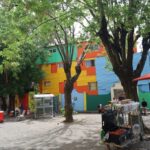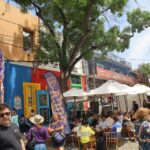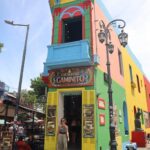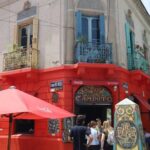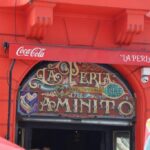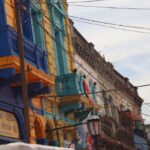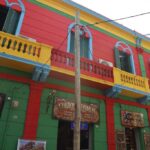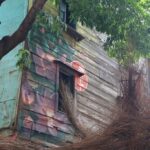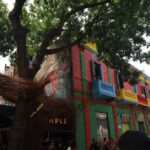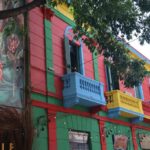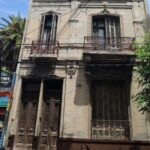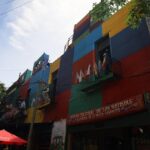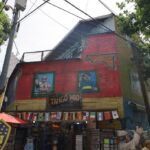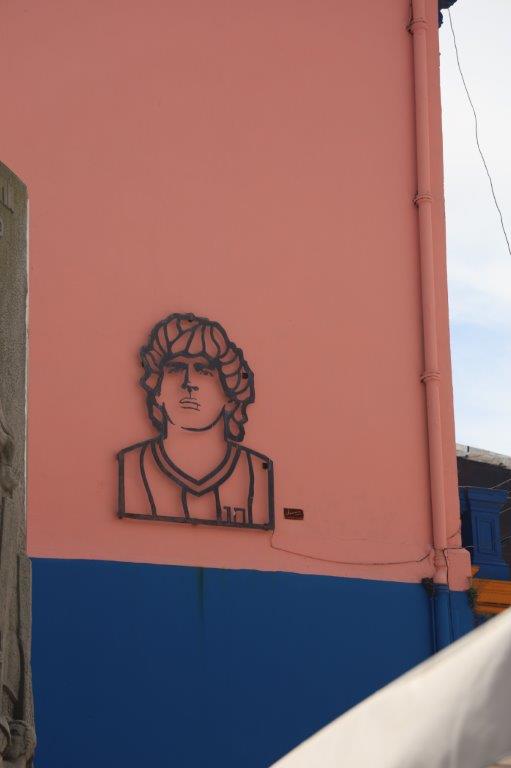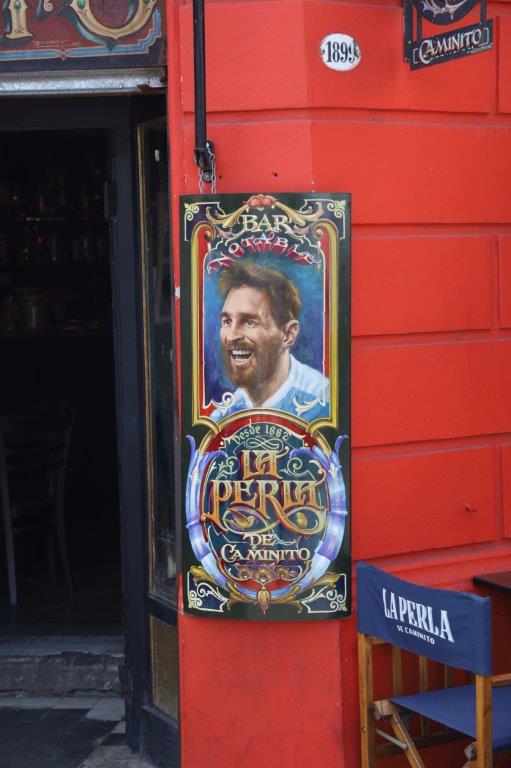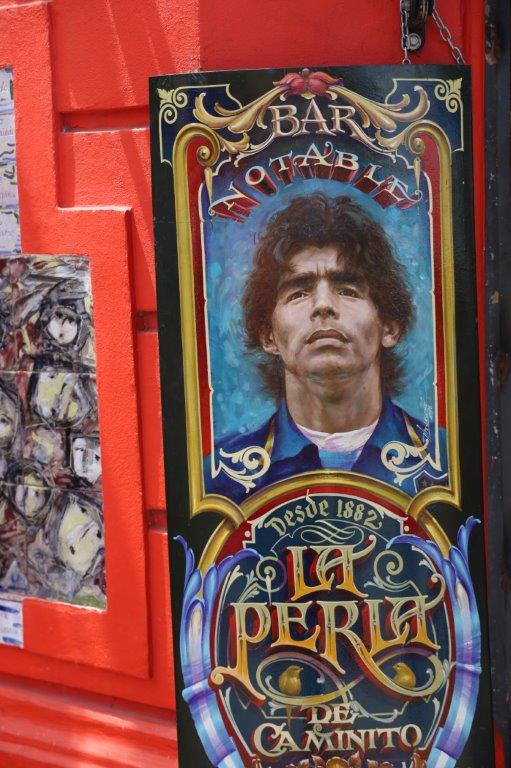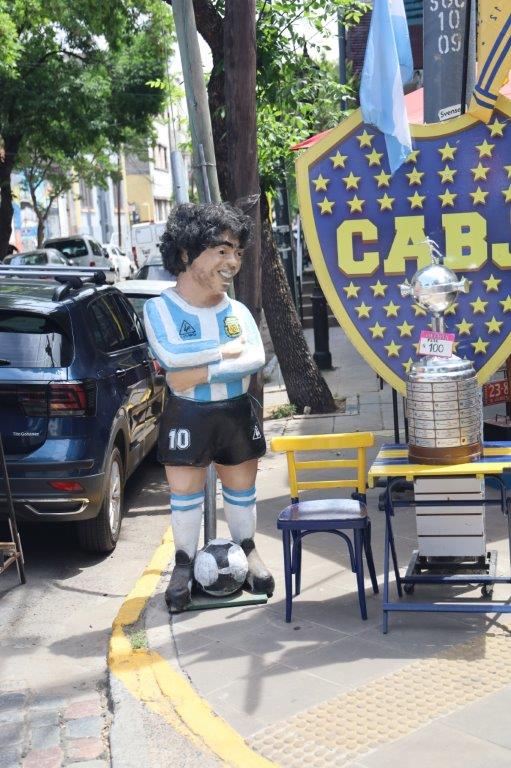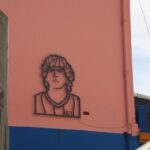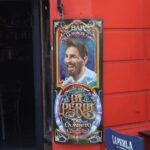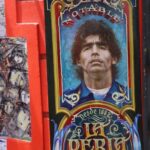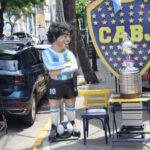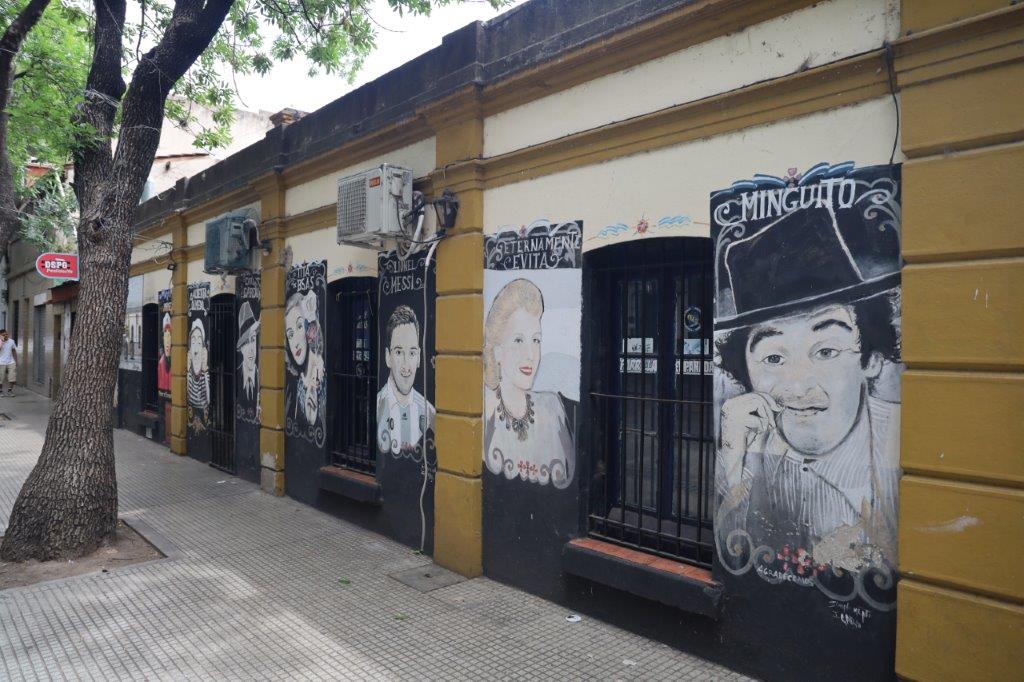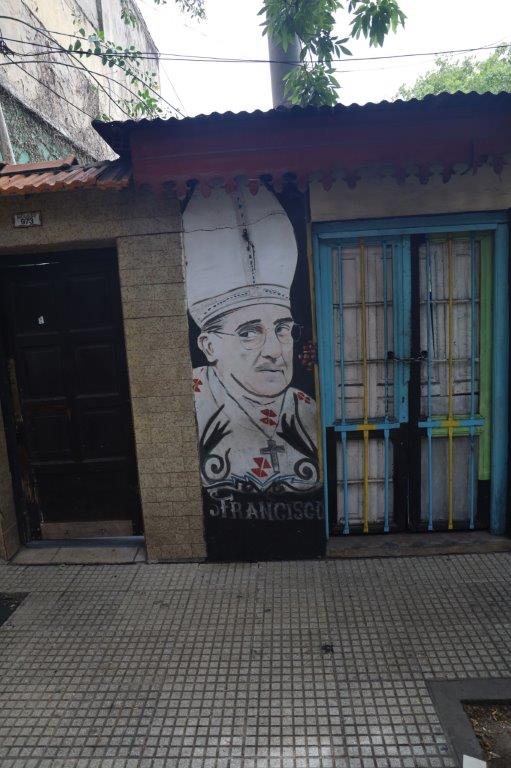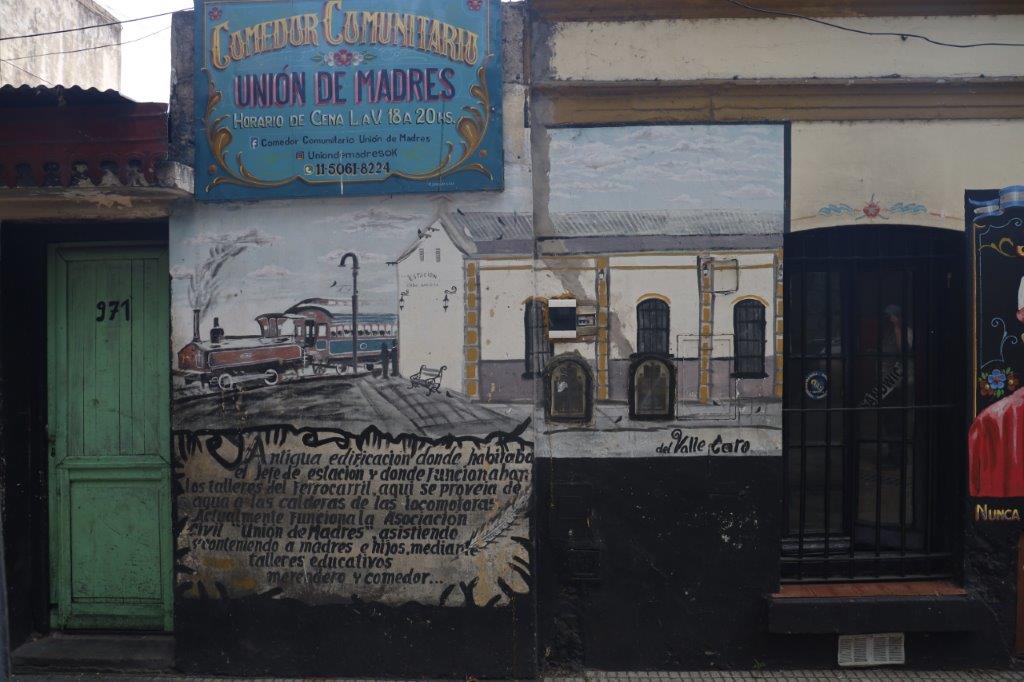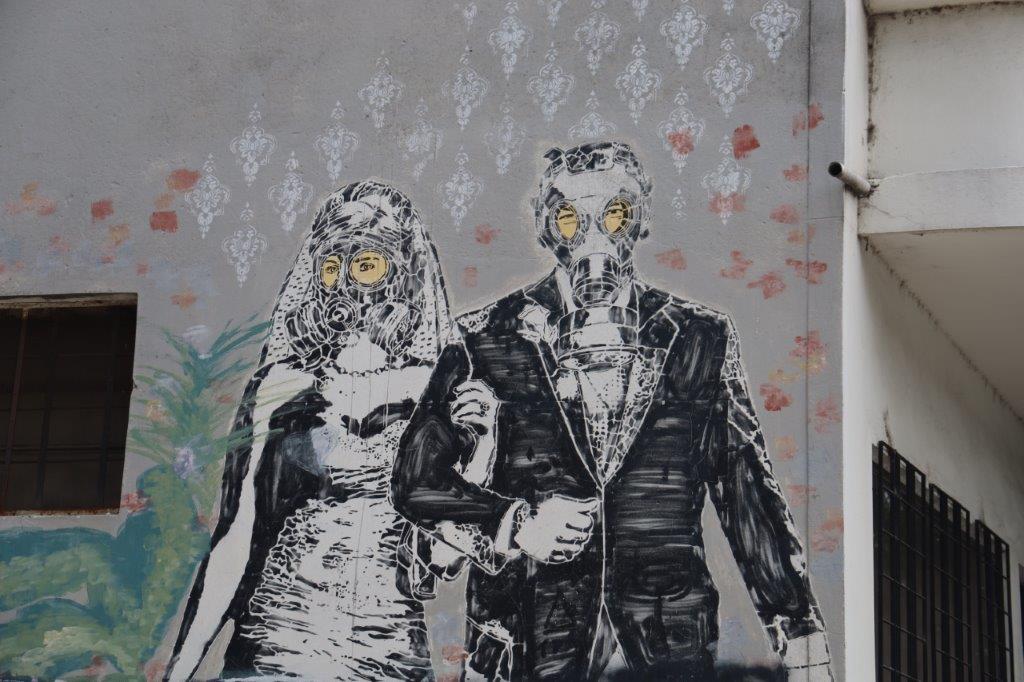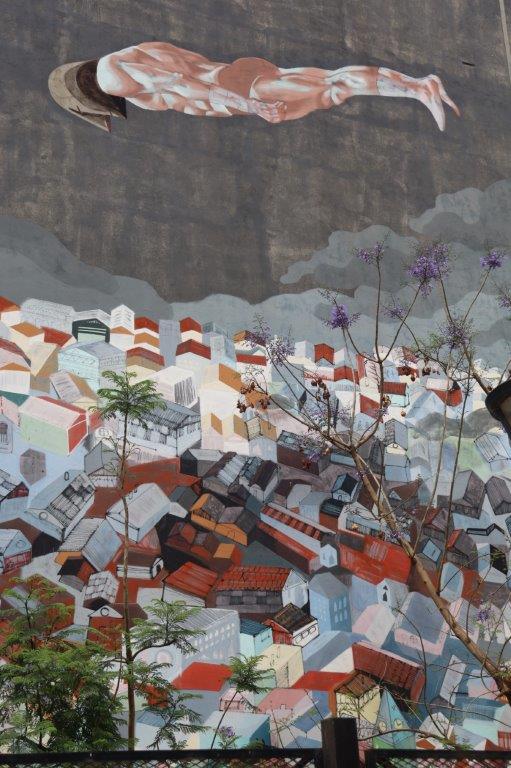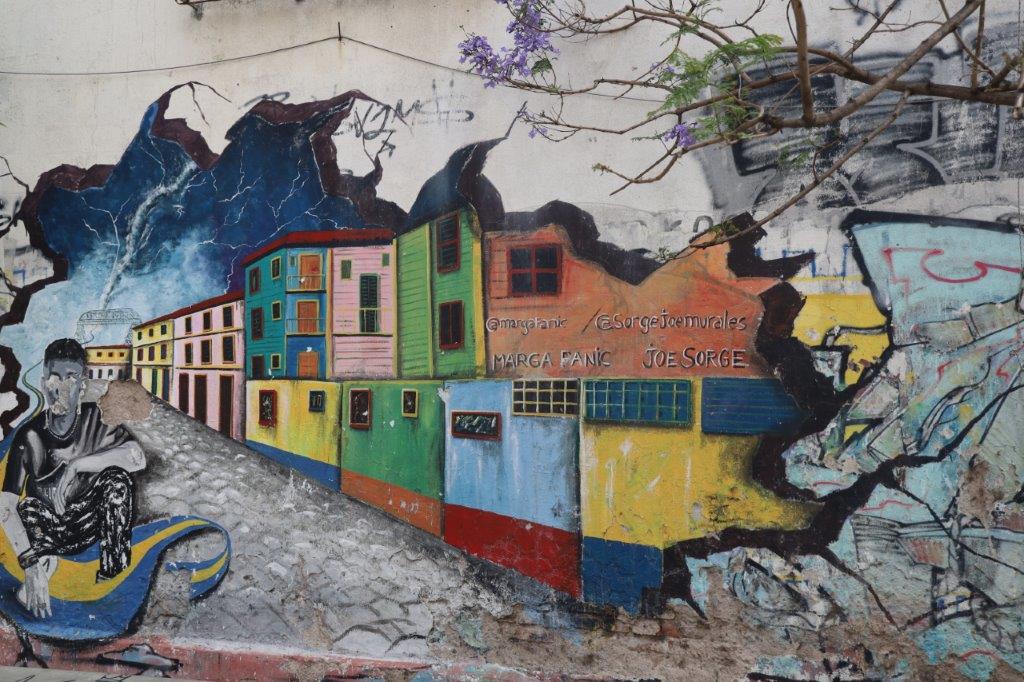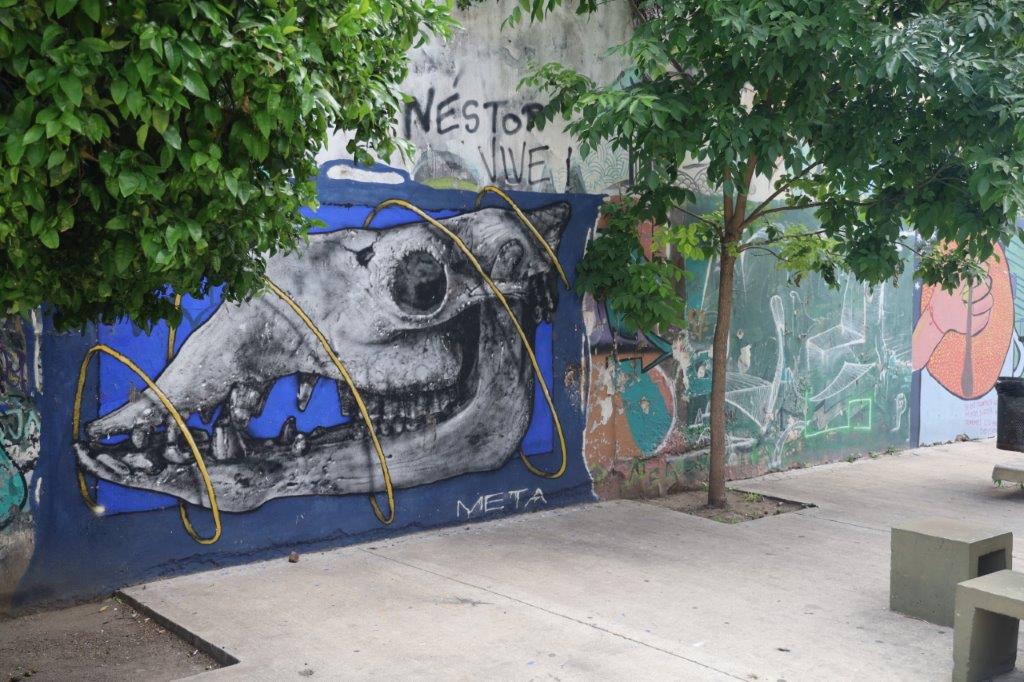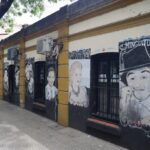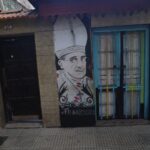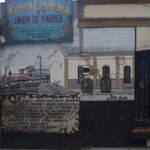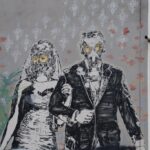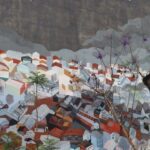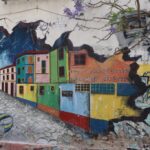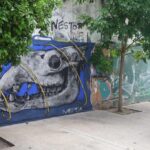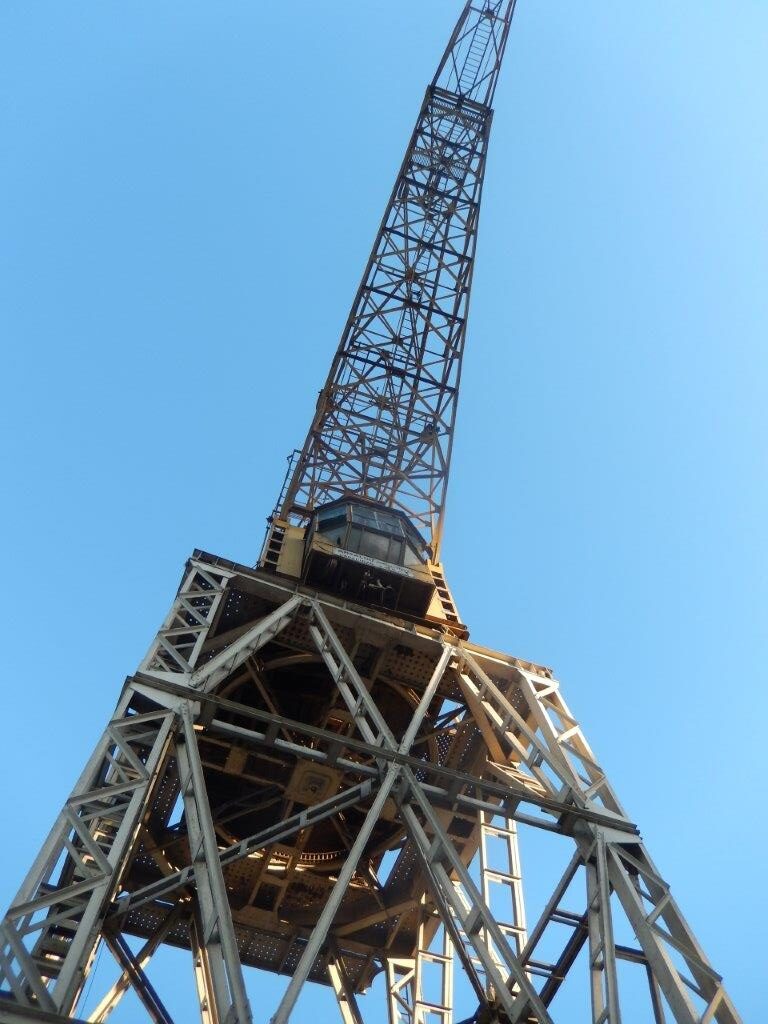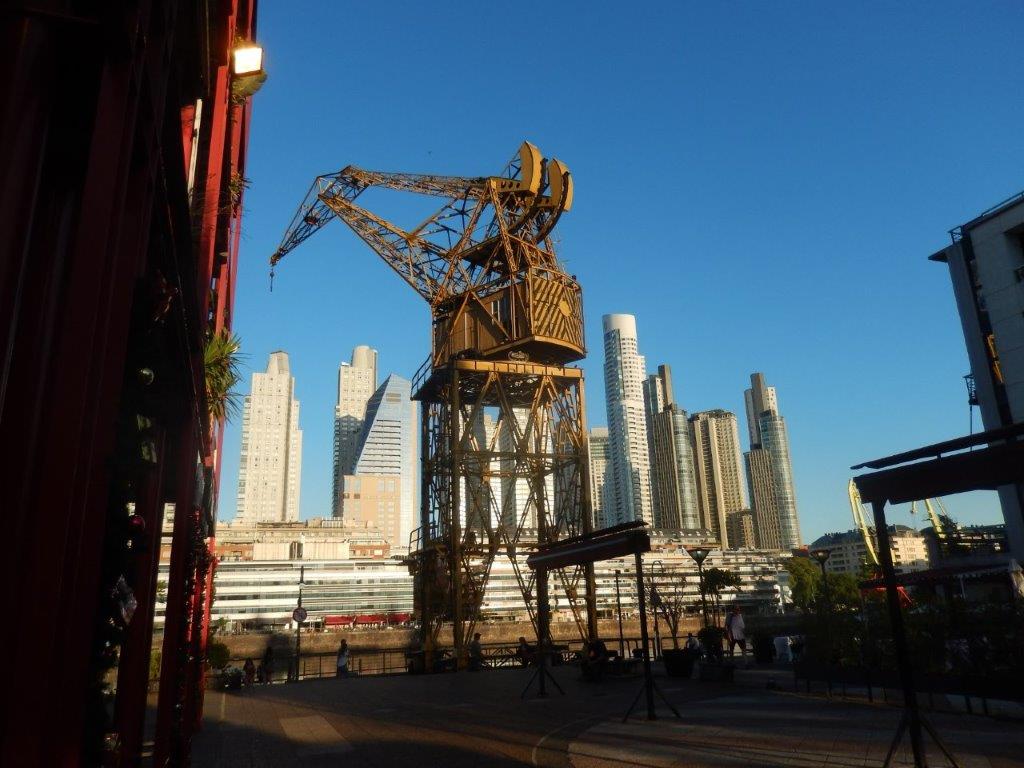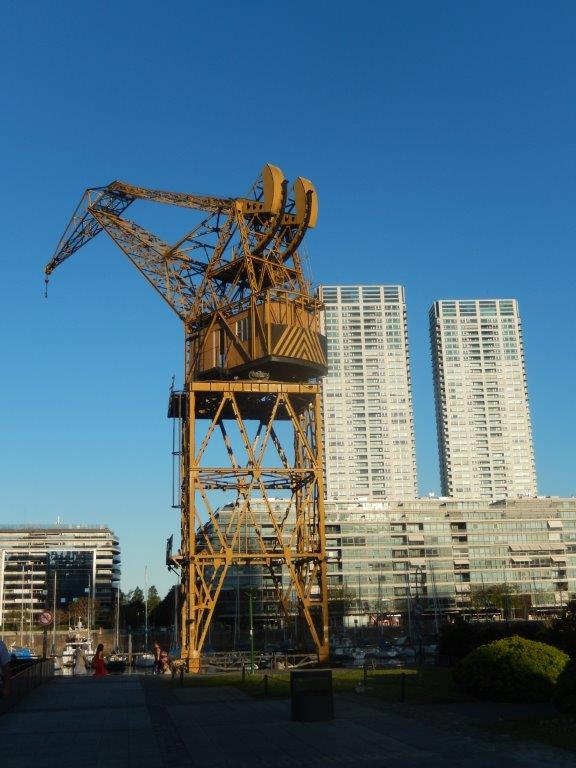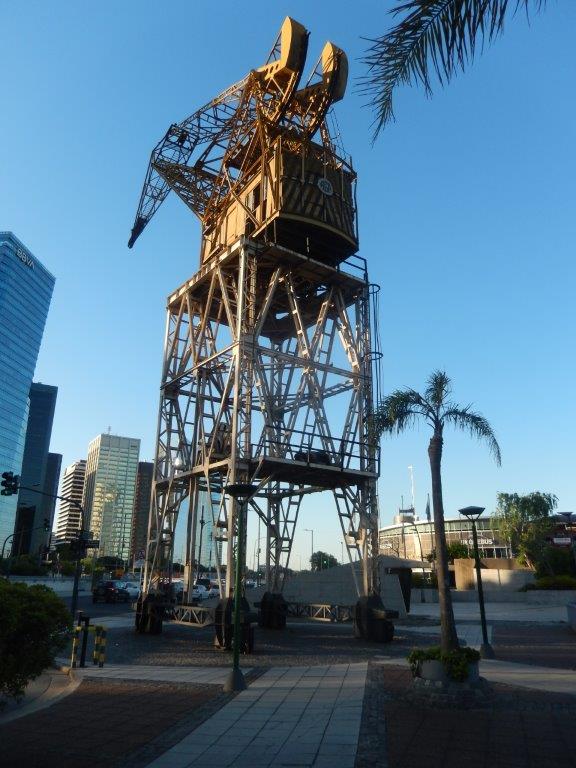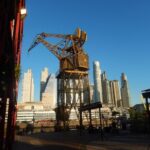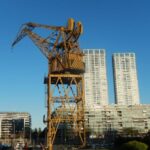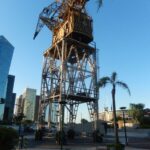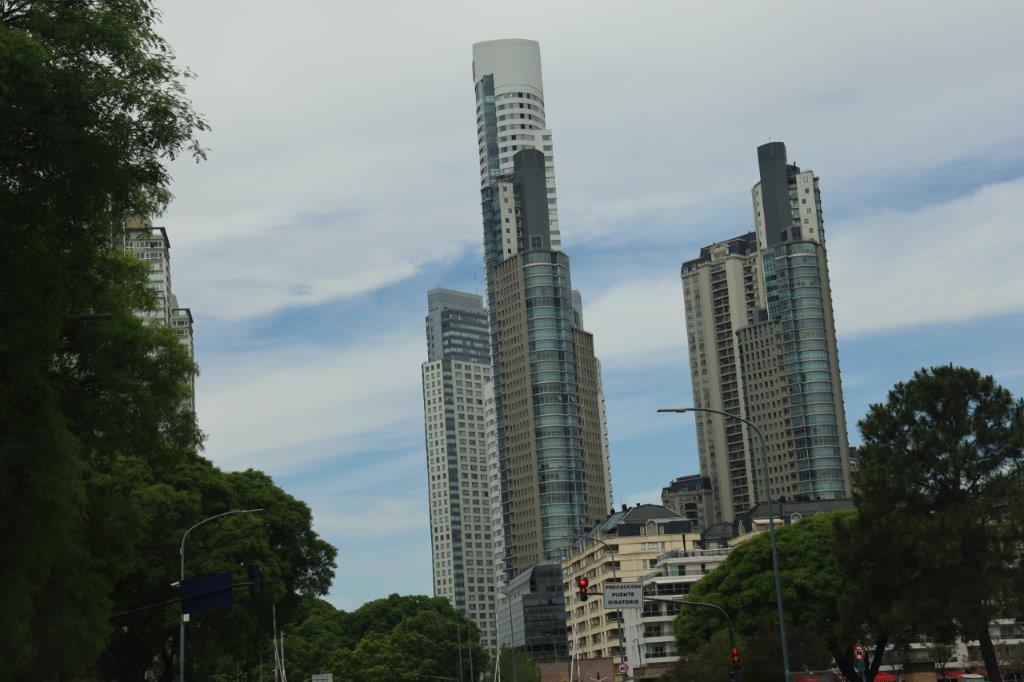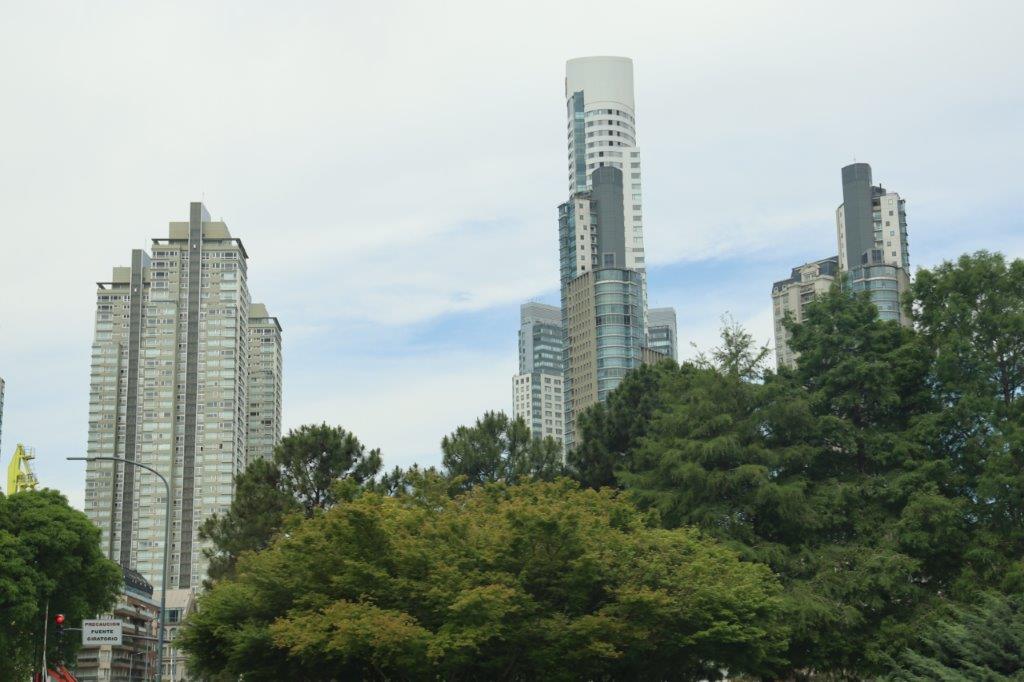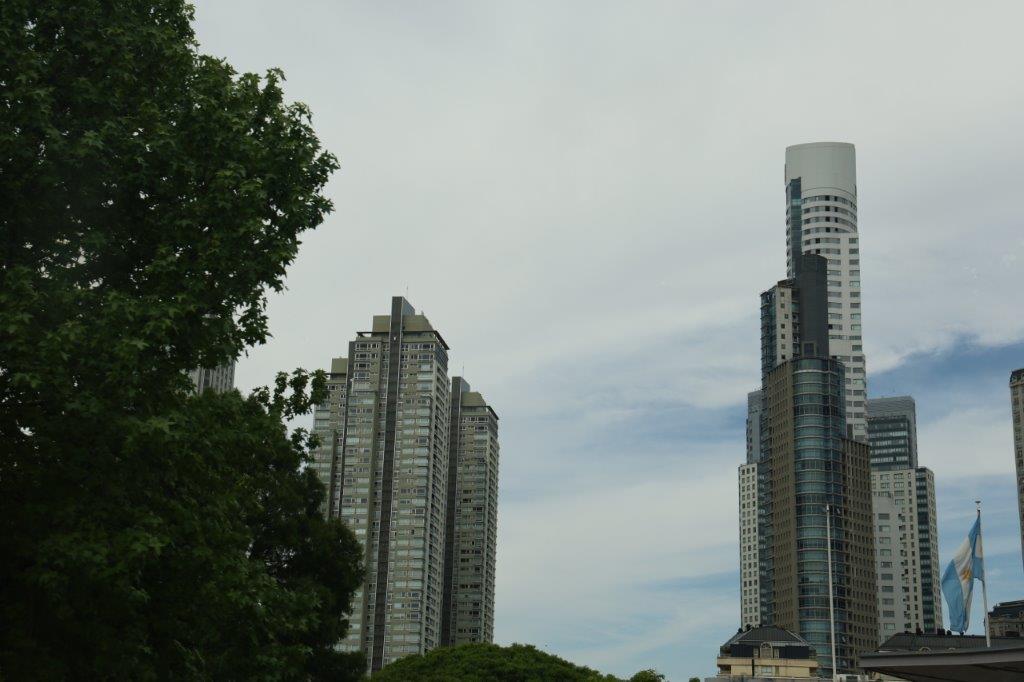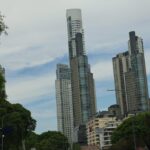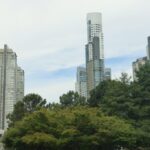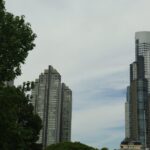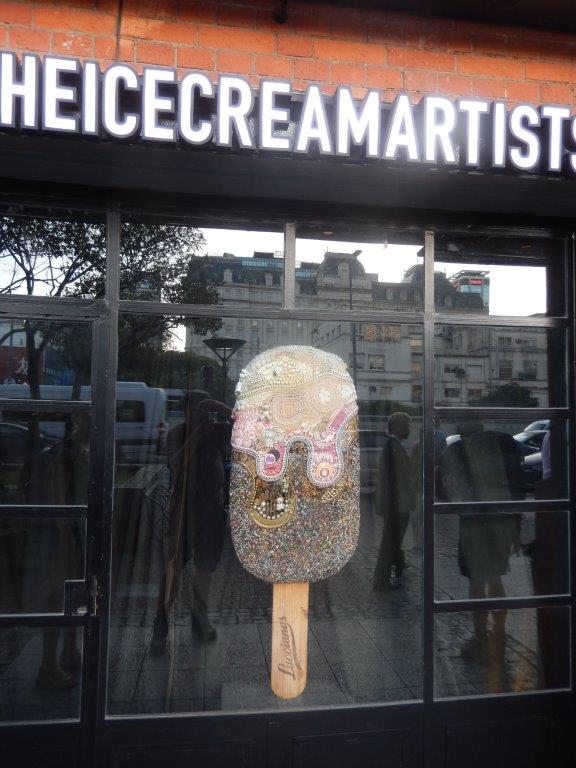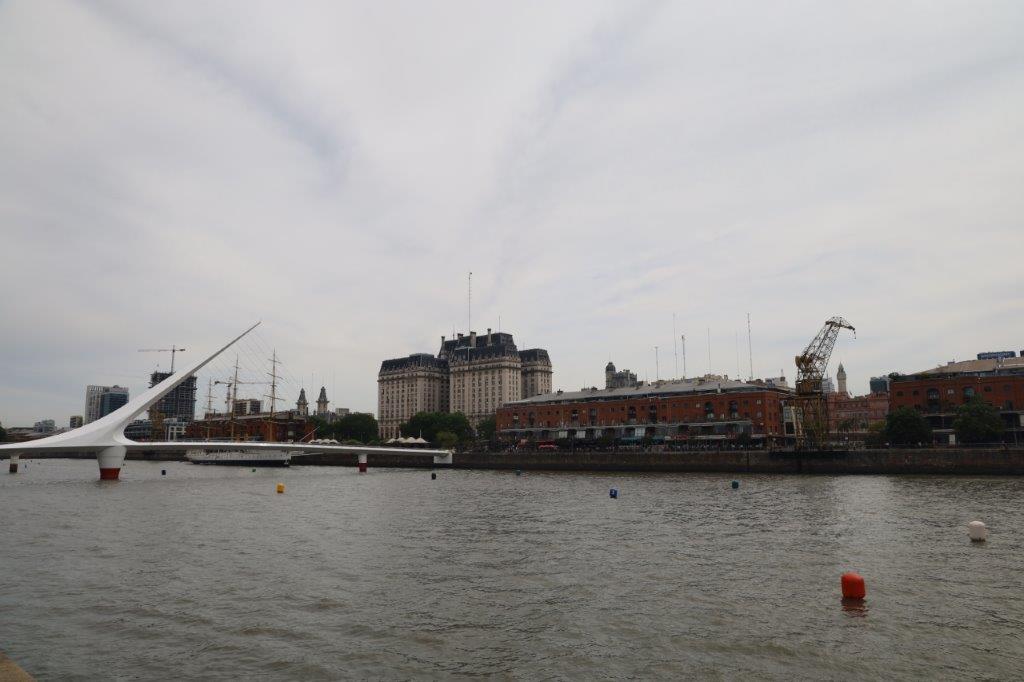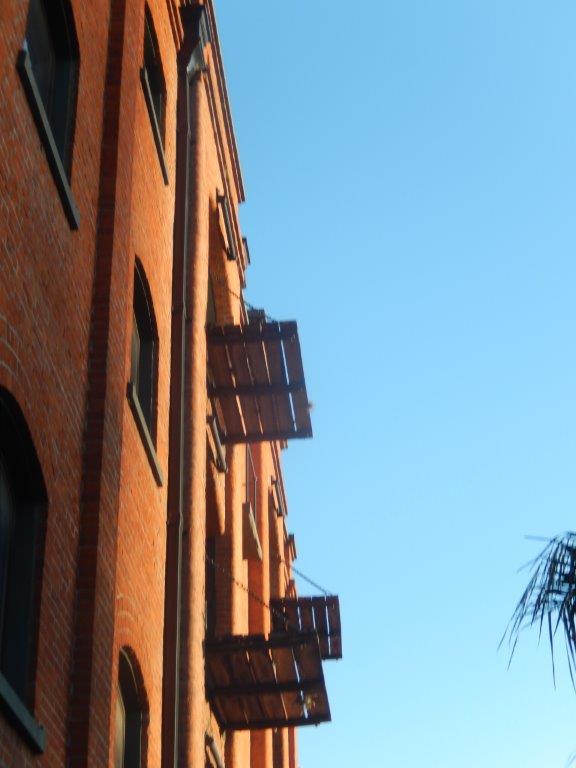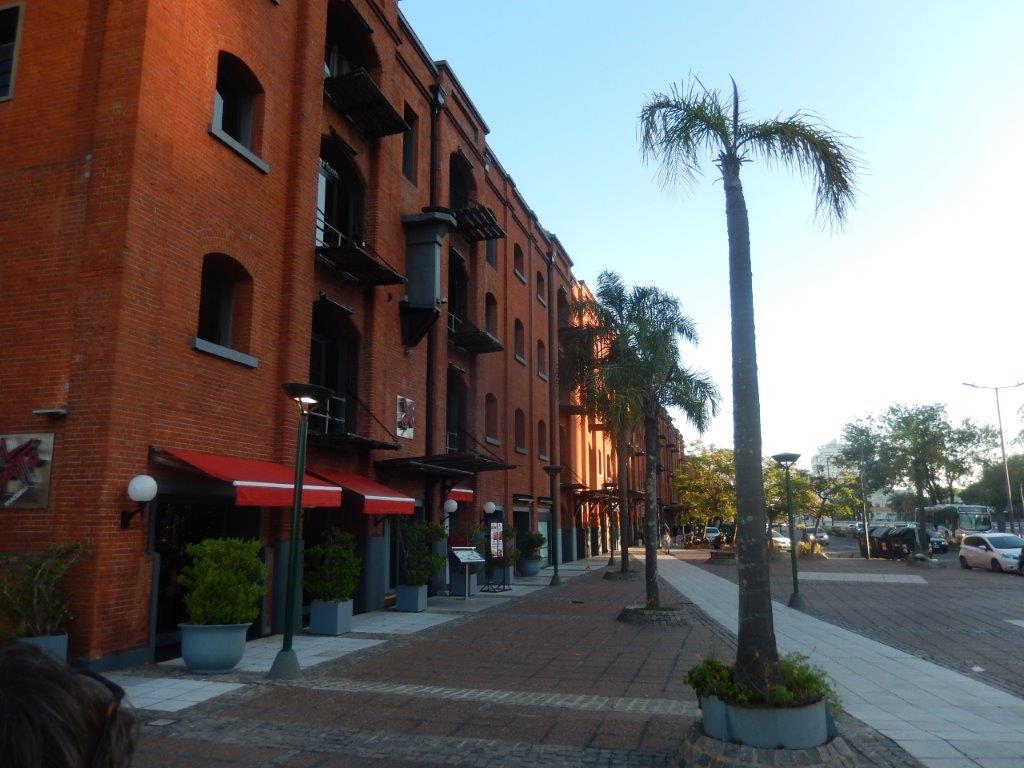2. Argentina: City trip through central Buenos Aires’ barrios and the history of Tango
Introduction to Buenos Aires
Buenos Aires is divided into several Barrio’s and this blogpost is like a restaurant menu full of barrio’s instead of dishes, from which The Wandelgek chose an exquisite selection of dishes to taste from😋:
- San Telmo
- Monserrat
- San Nicolas
- Retiro
- La Recoleta
- La Boca
- Puerto Madero
All of these have lots of historic and architectural beauty to offer, but have distinct character differences.
1. San Telmo
San Telmo (“Saint Pedro González Telmo”) is the oldest barrio (neighborhood) of Buenos Aires, Argentina. It is a well-preserved area of the Argentine metropolis and is characterized by its colonial buildings. Cafes, tango parlors and antique shops line the cobblestone streets, which are often filled with artists and dancers. A street named the “Illuminated Block” is where many of these important historical buildings can be found.
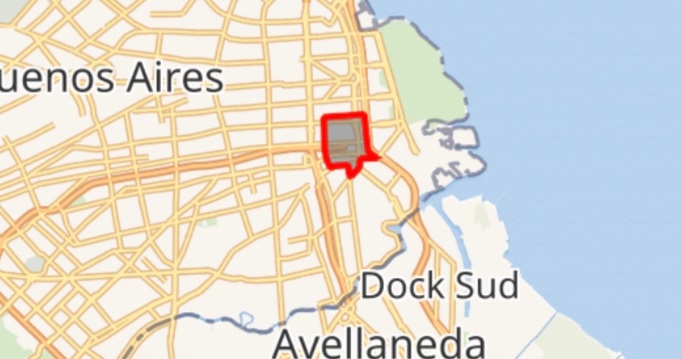
Barrio of San Telmo
San Telmo’s attractions include old churches (e.g. San Pedro Telmo), museums, food halls and stalls, antique stores and a semi-permanent antique fair (Feria de Antigüedades) in the main public square, Plaza Dorrego. Tango-related activities for both locals and tourists are in the area and this blog post starts and ends with Tango:
Tango part 1
But first: What is Tango? There is Tango as a dance and there’s Tango music which are often combined in Tango performances.
Tango dance
Tango is a partner dance and social dance that originated in the 1880s along the Río de la Plata, the natural border between Argentina and Uruguay. The tango was born in the impoverished port areas of these countries as the result of a combination of Rioplatense Candombe celebrations, Spanish-Cuban Habanera, and Argentine Milonga. The tango was frequently practiced in the brothels and bars of ports, where business owners employed bands to entertain their patrons. The tango then spread to the rest of the world. Many variations of this dance currently exist around the world.
At the Avenida Independencia in San Telmo is a beautiful mural which quite well explains the historic development of Tango…
History of Tango
Tango is a dance that has influences from African and European culture. Dances from the candombe ceremonies of former African enslaved people helped shape the modern day tango. The dance originated in lower-class districts of Buenos Aires and Montevideo. The music derived from the fusion of various forms of music from Europe. The words “tango” and “tambo” around the River Plate basin were initially used to refer to musical gatherings of slaves, with written records of colonial authorities attempting to ban such gatherings as early as 1789.
Initially, it was just one of the many dances, but it soon became popular throughout society, as theatres and street barrel organs spread it from the suburbs to the working-class slums, which were packed with hundreds of thousands of European immigrants.
When the tango began to spread internationally around 1900, cultural norms were generally conservative, and so tango dancing was widely regarded as extremely sexual and inappropriate for public display. This led to a phenomenon of culture shock. Additionally, the combination of African, Native American and European cultural influences in tango was new and unusual to most of the Western world.
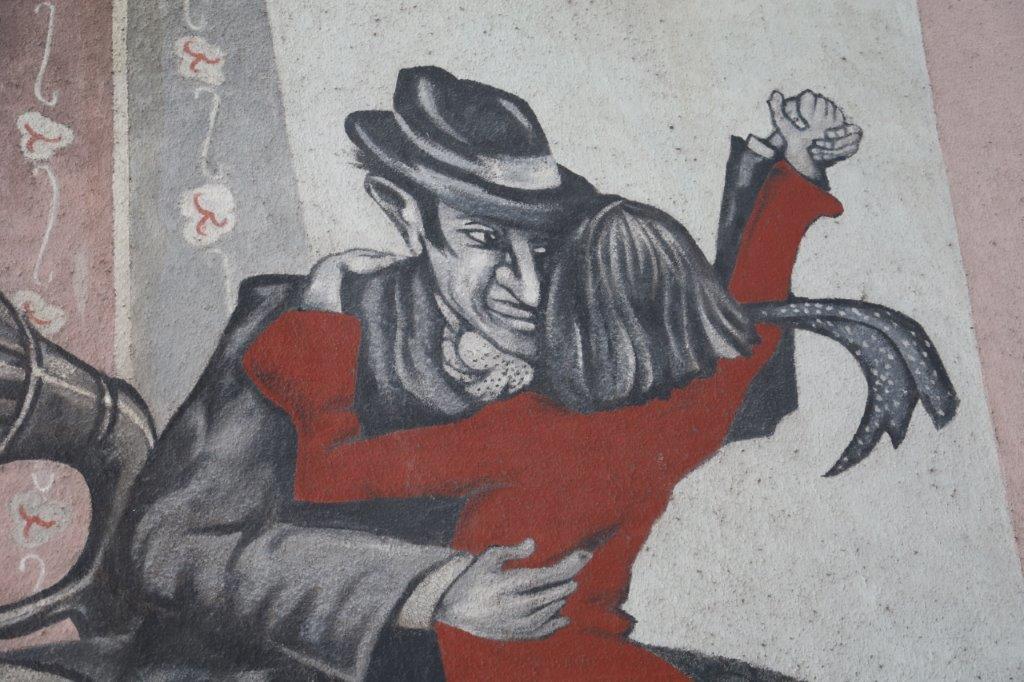 In the early years of the 20th century, dancers and orchestras from Buenos Aires travelled to Europe, and the first European tango craze took place in Paris, soon followed by London, Berlin, and other capitals. Tango historian Nardo Zalko, a native of Buenos Aires who lived most of his life in Paris, investigated the mutual fertilization between the two cities in his work, Paris – Buenos Aires, Un Siècle de Tango (“A Century of Tango”). Towards the end of 1913, it hit New York City as well as Finland. In the U.S., around 1911, the word “tango” was often applied to dances in a 24 or 44 rhythm such as the one-step. The term was fashionable and did not indicate that tango steps would be used in the dance, although they might be. Tango music was sometimes played but at a rather fast tempo. Instructors of the period would sometimes refer to this as a “North American tango”, versus the so-called “Argentine tango”. The tango was controversial because of its perceived sexual overtones and, by the end of 1913, the dance teachers who had introduced the dance to Paris were banished from the city. By 1914, more authentic tango stylings were soon developed, along with some variations like Albert Newman’s “Minuet” tango.
In the early years of the 20th century, dancers and orchestras from Buenos Aires travelled to Europe, and the first European tango craze took place in Paris, soon followed by London, Berlin, and other capitals. Tango historian Nardo Zalko, a native of Buenos Aires who lived most of his life in Paris, investigated the mutual fertilization between the two cities in his work, Paris – Buenos Aires, Un Siècle de Tango (“A Century of Tango”). Towards the end of 1913, it hit New York City as well as Finland. In the U.S., around 1911, the word “tango” was often applied to dances in a 24 or 44 rhythm such as the one-step. The term was fashionable and did not indicate that tango steps would be used in the dance, although they might be. Tango music was sometimes played but at a rather fast tempo. Instructors of the period would sometimes refer to this as a “North American tango”, versus the so-called “Argentine tango”. The tango was controversial because of its perceived sexual overtones and, by the end of 1913, the dance teachers who had introduced the dance to Paris were banished from the city. By 1914, more authentic tango stylings were soon developed, along with some variations like Albert Newman’s “Minuet” tango.
In Argentina, the onset in 1929 of the Great Depression, and restrictions introduced after the overthrow of the Hipólito Yrigoyen government in 1930, caused a temporary decline in tango’s popularity. Its fortunes were reversed later in the 1930s, and tango again became widely fashionable and a matter of national pride under the first Perón government, which in turn had a major effect on Argentinian culture overall.
Tango declined again in the late 1950s, as a result of economic depression and the banning of public gatherings by the military dictatorships; male-only tango practice—the custom at the time—was considered “public gathering”. That, indirectly, boosted the popularity of rock and roll because, unlike tango, it did not require such gatherings. However, in the late 1980s the tango again experienced a resurgence in Argentina, partly due to the endeavors of Osvaldo Peredo.
In 2009, the tango was added to the UNESCO Intangible Cultural Heritage Lists.
Tango music
Tango is a style of music in 24 or 44 time that originated among European and African immigrant populations of Argentina and Uruguay (collectively, the “Rioplatenses”). It is traditionally played on a solo guitar, guitar duo, or an ensemble, known as the orquesta típica, which includes at least two violins, flute, piano, double bass, and at least two bandoneóns. Sometimes guitars and a clarinet join the ensemble. Tango may be purely instrumental or may include a vocalist. Tango music and dance have become popular throughout the world.
Astor Piazzolla
There was however a decline in interest for Tango in the 1950’s. Specificly young people were more interested in other types of music than the old, strict Tango music. This all changed when Astor Piazzolla began experimenting with those strict rules and with instrumentation. His succesful efforts not only renewed the way Tango music was created, but also revived interest in Tango by the youngest genersations. In the Netherlands we were reminded of his genius when Argentinian Prinses Maxima Zorreguita married our Prins Alexander on the 2nd of february 2002 and both became King and Queen of The Netherlands. At the wedding, Dutch bandoleon player Carel Kraayenhof played Astor Piazzolla’s composition Adios Nonino (Goodbye father), which was of course a reference to Maxima’s father, Jorge Horacio Zorreguieta Stefanini (28 January 1928 – 8 August 2017), who was an Argentine politician who served as Secretary of Agriculture in the regime of General Jorge Rafael Videla. This was quite a hot pickle in dutch conversations and politics, but this tango and Maxima’s tear changed dutch public opinion on whether she was to be held responsible for her father’s deeds. Her father was not allowed to be present at her wedding.
It was also filmed and cut brilliantly in a dramatic and really effective way, which was also credit to the emotional effect on viewers.
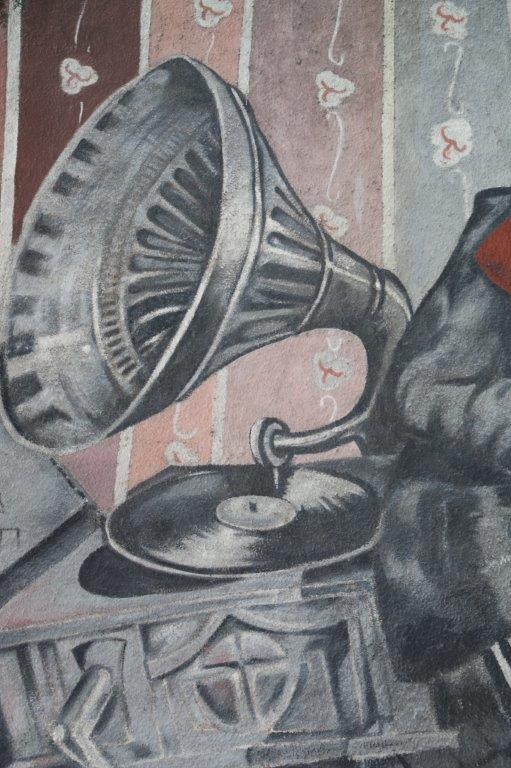 The Wandelgek had already learned about the beautiful music of Astor Piazzola before, when he saw an Italian produced movie series named: La meglio gioventu, which was an impressive overview of Italian post World War II history. In this movie another tango by Astor Piazzolla was used in its sountrack and the tango Oblivion and the series as well had a profound impact on how young people looked at the world.
The Wandelgek had already learned about the beautiful music of Astor Piazzola before, when he saw an Italian produced movie series named: La meglio gioventu, which was an impressive overview of Italian post World War II history. In this movie another tango by Astor Piazzolla was used in its sountrack and the tango Oblivion and the series as well had a profound impact on how young people looked at the world.
Oblivion is in my opinion far better than Adios nonino, because of its hauntingly beautiful melody. The song has been described as “haunting” and “atmospheric,” and is considered to be one of Piazzolla’s most popular tangos. I also love the fact that an Argentine Tango was used in this Italian production, because I learned, during these travels, that Italian and Argentine latino cultures have much in common.
Edmundo Rivero
In front of this awesome mural was a statue of famous Tango singer:
Leonel Edmundo Rivero (June 8, 1911 – January 18, 1986) was an Argentine tango singer, composer, and impresario.
Rivero was born in the southern Buenos Aires suburb of Valentín Alsina.
El Viejo Almacén
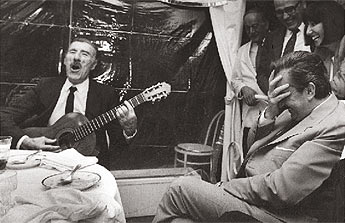
Edmundo Rivero (singing with his guitar) and then president of Argentina, Raúl Alfonsín, during a tribute to Carlos Gardel at the presidential residence of Olivos, Buenos Aires. The meeting was held in December 1984.
By the late 1960s, tango had become mostly “for export”, since musicians and audiences were aging and making little progress from the orchestral format of the 1940s and 1950s. many tango fans rejected the music of Ástor Piazzolla and his followers, but Rivero himself admired Piazzolla, and recorded his creations on more than one occasion. Even major artists had trouble finding venues to play.
Fearing for tango’s viability, in 1969 Rivero opened El Viejo Almacén (“The old store”), a tango club in the San Telmo district. His hospitality was enjoyed by many visitors to Buenos Aires, who went to Rivero’s club to savor the tango music and dance in its full intensity. Among the recurring visitors were Joan Manuel Serrat and Camilo José Cela.
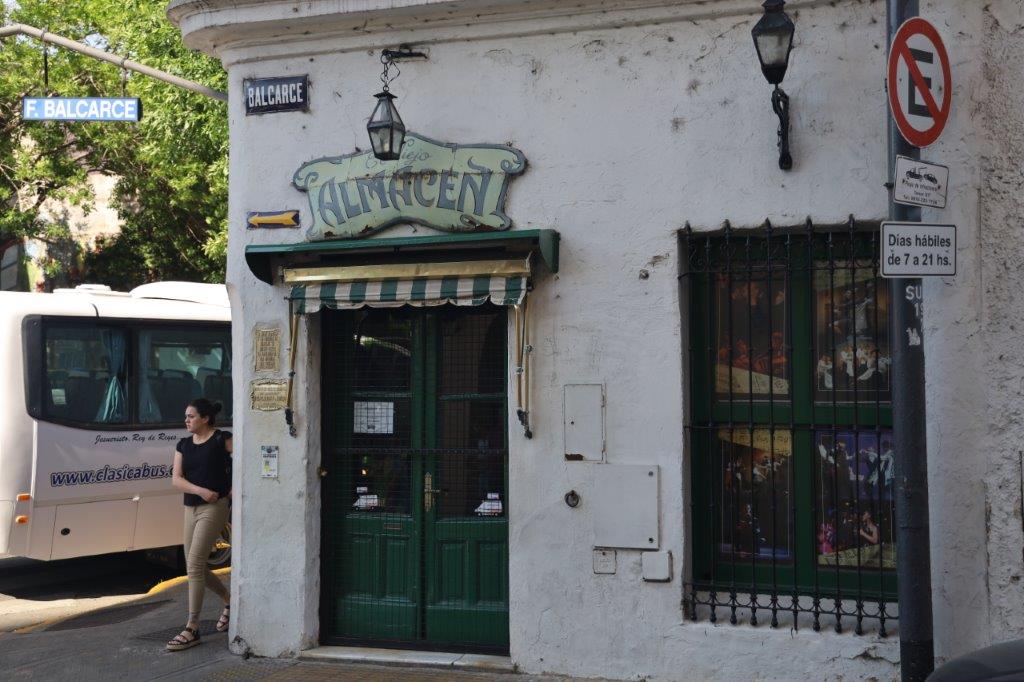 Rivero’s place was a venue for tango, where musicians knew they would be respected and paid on time. Famed tango lyricist Horacio Ferrer wrote a milonga about the almacén for which Rivero later composed the music, and took to calling Rivero by his forgotten first name, Leonel, a gesture that many friends would imitate.
Rivero’s place was a venue for tango, where musicians knew they would be respected and paid on time. Famed tango lyricist Horacio Ferrer wrote a milonga about the almacén for which Rivero later composed the music, and took to calling Rivero by his forgotten first name, Leonel, a gesture that many friends would imitate.
Rivero was an icon in Japanese tango circles. He toured Japan in 1968, and got to know many Japanese musicians and dancers. Rivero composed “Arigato Japón” and “A lo Megata” (honoring Tsunayoshi “Tsunami” Megata, one of the top tango dancers of his age). Japanese tourists were a constant presence in Rivero’s place.
Rivero hosted a TV show in the early seventies, which featured artists from the club (such as Beba Bidart), as well as lively dialog sprinkled with lunfardo. Some of his 1960s and 1970s reunions with Troilo and Grela were televised. In 1980, Rivero took part in Osvaldo Pugliese’s 75th birthday concert. In his later years, he delegated the day-to-day operation of the club to his son Edmundo (“Muni”).
Rivero was hospitalized in late 1985, and died from heart failure on January 18, 1986, in Buenos Aires.
In February 2011 it was reported that many artifacts germane to Rivero’s legacy were stolen from a warehouse in Ramos Mejía, showing how much value these artifacts still have.
Monumento Canto al Trabajo
Also on the Avenida Independencia at thePlazoleta Coronel Manuel de Olazábalis, a bronze statue named Monumento Canto al Trabajo (Song of Labor Monument).
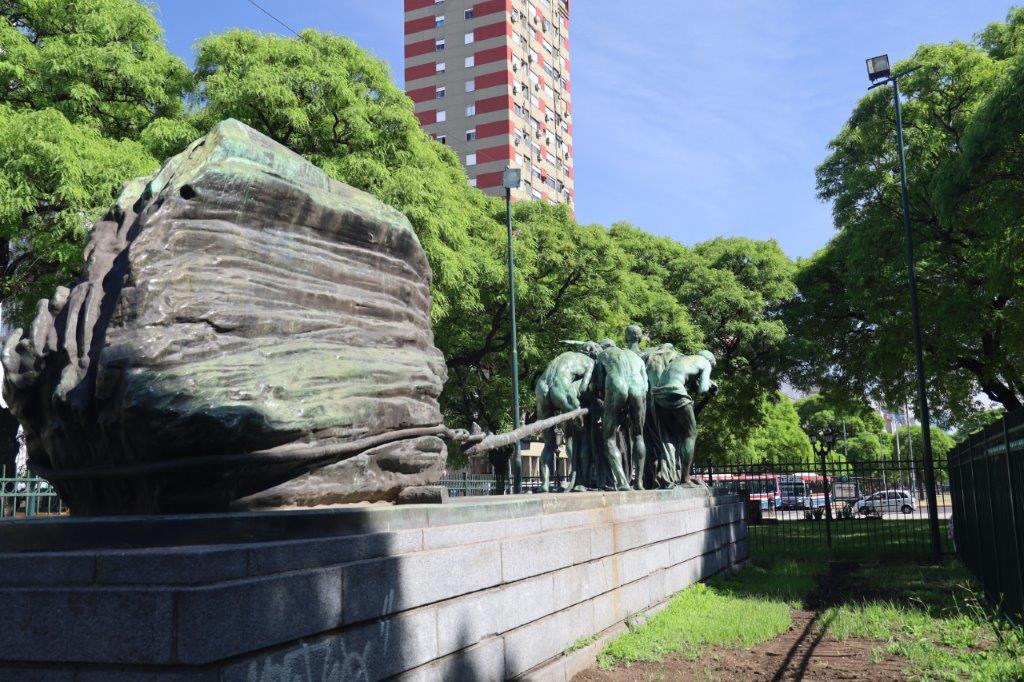 It shows people, pulling at a rope attached to a rock. Well The Wandelgek was at the start of his vacation and that’s why he was walking around this statue looking and photographing it instead of pulling that rope myself ;-).
It shows people, pulling at a rope attached to a rock. Well The Wandelgek was at the start of his vacation and that’s why he was walking around this statue looking and photographing it instead of pulling that rope myself ;-).
From San Telmo The Wandelgek drove to the next barrio:
2. Monserrat
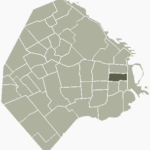
Barrio of Monserrat
Monserrat or Montserrat is a neighbourhood in the east of the Buenos Aires CBD. The district features some of the most important public buildings in Buenos Aires, including city hall, the city legislature, Casa Rosada, the Colegio Nacional de Buenos Aires and the Libertador Building (Ministry of Defense), among others.
Avenida de Mayo runs through the Monserrat district, connecting Plaza de Mayo and the Plaza de los Dos Congresos (Congressional Plaza).
A block, or two, south of the Plaza de Mayo, the older section of Monserrat begins. This is Buenos Aires’ oldest neighborhood and even today, very little of the cityscape there is less than a hundred years old (except along Belgrano Avenue), thereby making a nearly seamless transition to the likewise historic San Telmo district, to the south.
Plaza del Congreso
If you follow the Avenida de Mayo from the Plaza de Mayo, crossing the Avenida de 9 Julio and keep following it to its end, you are in Balvanera and you reached the Plaza del Congreso.
Congressional Plaza is a public park facing the Argentine Congress in Buenos Aires. The plaza is part of a 3 hectare (7.5 acre) open space comprising three adjoining plazas to the east of the Congress building.
The Kilometre Zero for all Argentine National Highways is marked on a milestone at the Plaza.
The plaza actually is a merger of three plazas:
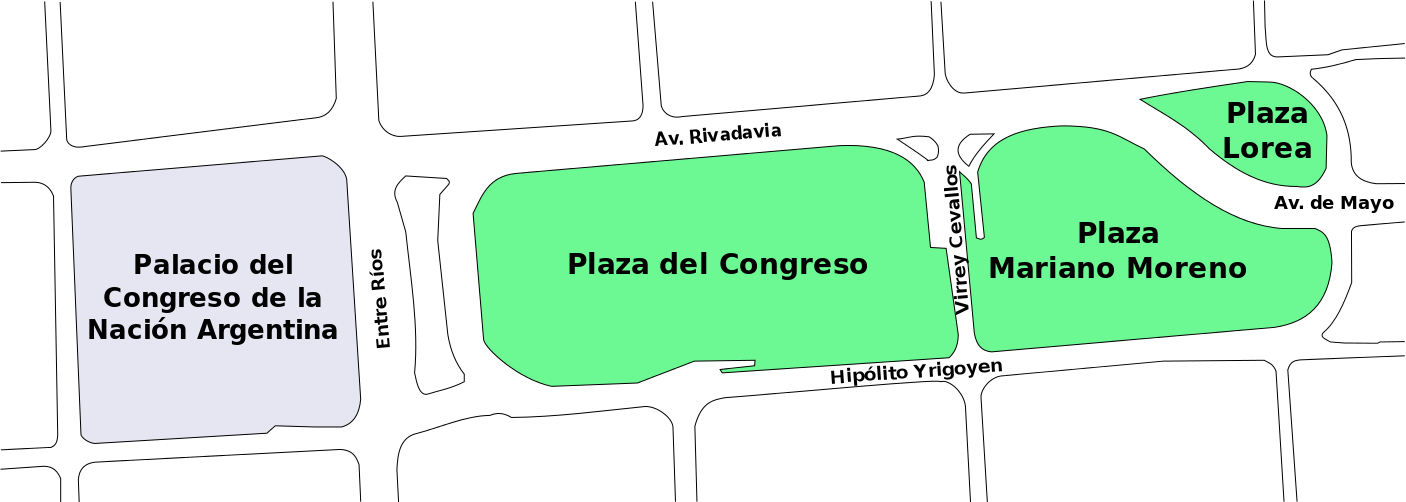
Palacio del Congreso
The Palace of the Argentine National Congress is a monumental building, seat of the Argentine National Congress, located in the city of Buenos Aires. It is located in the barrio of Balvanera at its limit with Monserrat, an area informally known as the Congreso neighbourhood.
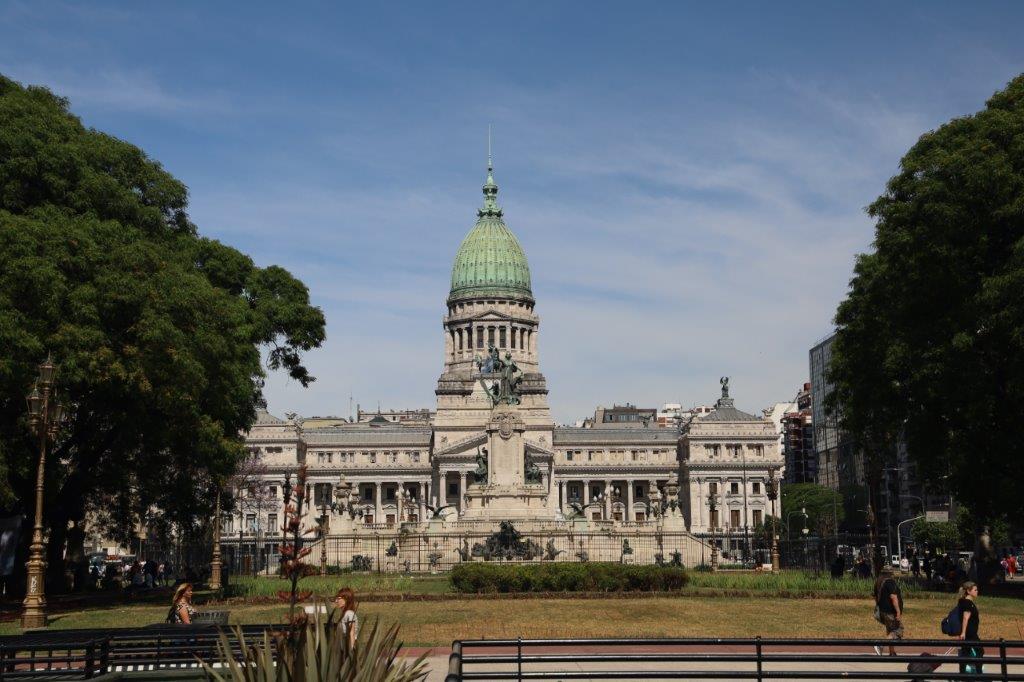 Constructed between 1898 and 1906, the palace is a National Historic Landmark.
Constructed between 1898 and 1906, the palace is a National Historic Landmark.
The palace is in Neoclassical style, largely made of white marble with elaborately furnished interiors, especially in the Lost Steps Hall and the Blue Room. It is crowned by a bronze-plated dome 80 metres (260 ft) in height, weighing 3,000 tonnes (3,000 long tons; 3,300 short tons), weathered to green color. This cupola is supported over a 10 metres (33 ft) deep inverted dome foundation. The dome is lit during Argentina’s national holidays and other special occasions.
The main entrance, called the Entrada de Honor (“Honor Entrance”), is exclusively used for ceremonial purposes.
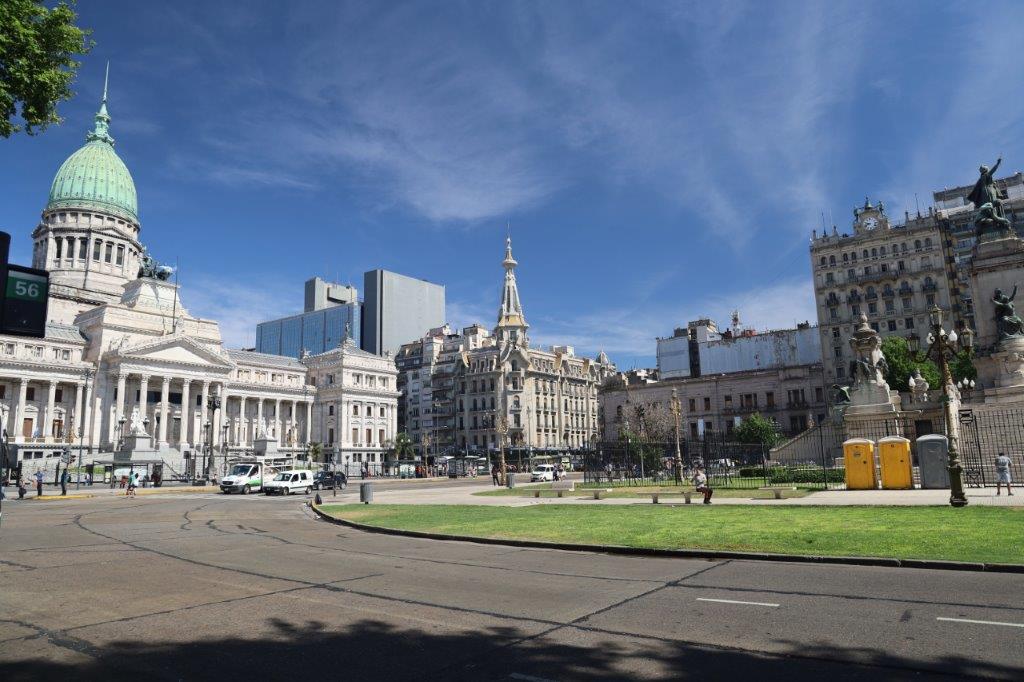 On top of the entrance is the 8 metres (26 ft) high quadriga sculpture, by Victor de Pol. It is made of bronze and weighs 20 tonnes (20 long tons; 22 short tons). A symbol of the Argentine Republic, it follows the typical depiction of Roman Empire generals making a declaration of Victory but in this case it is driven by the symbolic Liberty holding the reins of the horses.
On top of the entrance is the 8 metres (26 ft) high quadriga sculpture, by Victor de Pol. It is made of bronze and weighs 20 tonnes (20 long tons; 22 short tons). A symbol of the Argentine Republic, it follows the typical depiction of Roman Empire generals making a declaration of Victory but in this case it is driven by the symbolic Liberty holding the reins of the horses.
Another large collection of statues has a text written on its central pillar, which states: “La Nacion Argentina a la Asamblea de 1813 y al Congreso de 1816″.
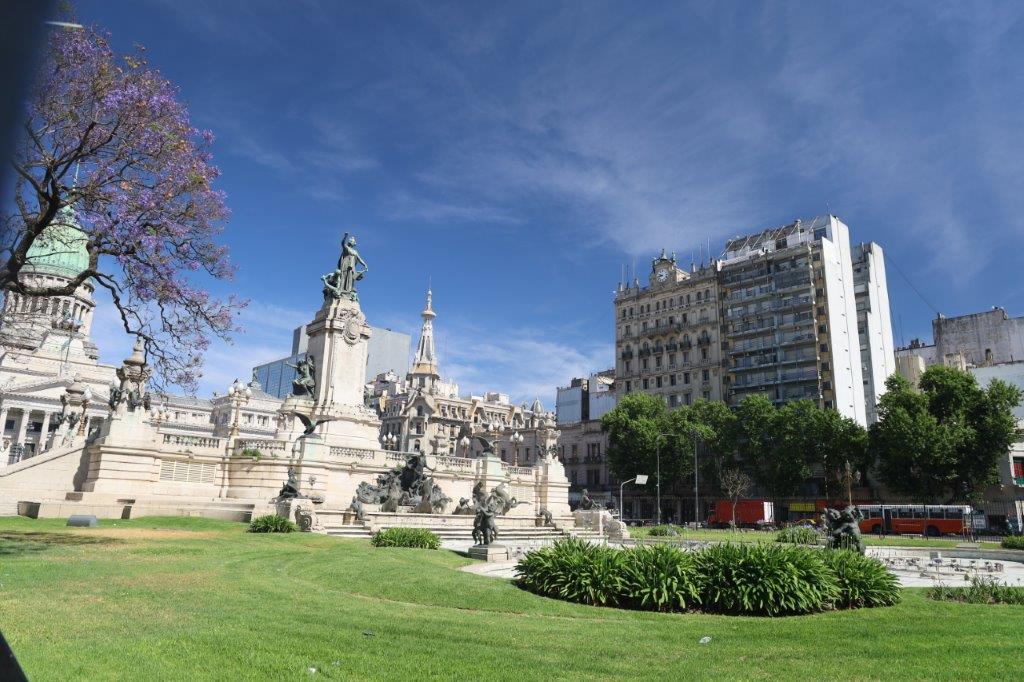 The palace used to have a barber shop in the basement but it was demolished.
The palace used to have a barber shop in the basement but it was demolished.
The Thinker
In the pictures below, behind the Kilometer zero milestone, is an original bronze statues of The Thinker, created by Auguste Rodin.
The third of only eight original casts made by Auguste Rodin, commissioned by Museums Director Eduardo Schiaffino for the city in 1907, he and Rodin had envisaged its placement on a pedestal on the grand steps in front of Congress – a plan which never materialized.
Headquarters of the Mothers of the Plaza de Mayo
The headquarters of the Mothers of the Plaza de Mayo can be found on the edge of the square as well at the blue sign with the white diaper
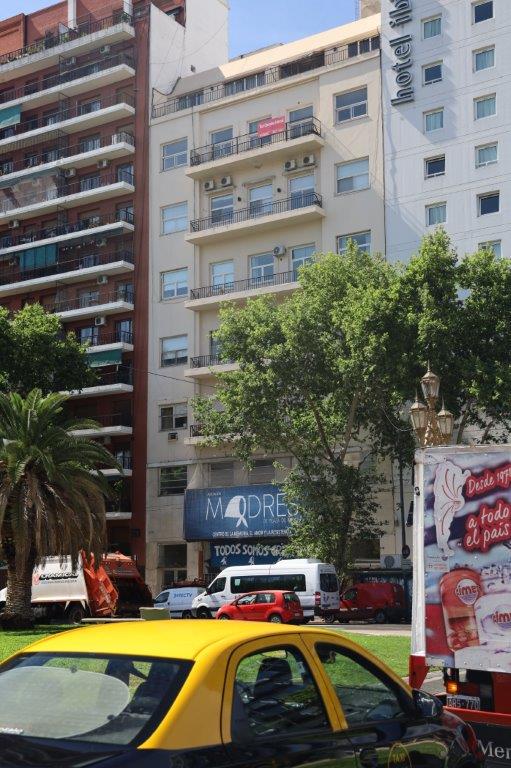 After a last view over the buildings surrounding the plaza, …
After a last view over the buildings surrounding the plaza, …
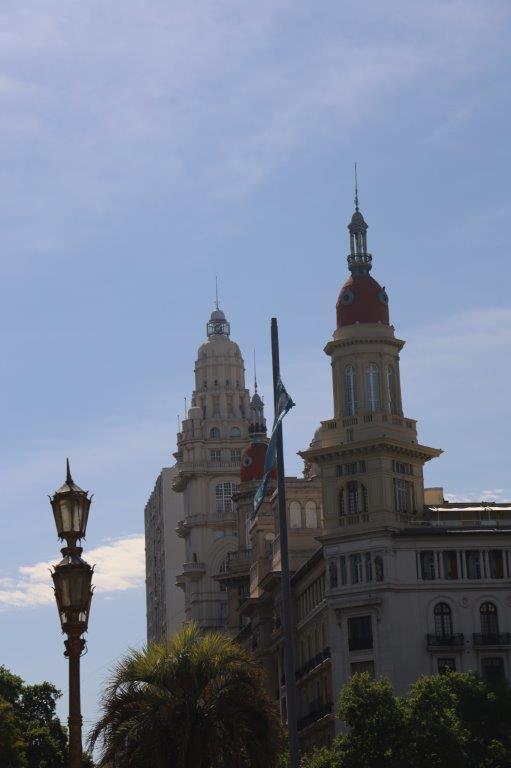 … The Wandelgek moved on to the San Nicolas barrio.
… The Wandelgek moved on to the San Nicolas barrio.
3. San Nicolas
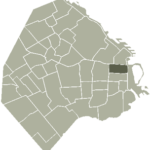
Barrio of San Nicolas
San Nicolás is one of the neighbourhoods of Buenos Aires, Argentina, sharing most of the city and national government Neighborhood of Buenos Aires with neighboring Montserrat and home to much of the financial sector. It’s referred usually as El Centro (“The Centre”), and the part east of the 9 de Julio Avenue is known as Microcentro.
The limits of the neighbourhood are the Córdoba, Callao, Rivadavia, La Rábida Norte and Eduardo Madero Avenues. The district is home to 33,305 inhabitants.
San Nicolás acquired its approximate, present layout when, in 1936, five city blocks were demolished (including numerous historical landmarks, such as the Mercado del Plata and the San Nicolás Parish) for the first stage of the Ninth of July Avenue.
Metropolitan Cathedral
The Buenos Aires Metropolitan Cathedral is the main Catholic church in Buenos Aires, Argentina. It is located in the city center, overlooking Plaza de Mayo, on the corner of San Martín and Rivadavia streets, in the San Nicolás neighbourhood.
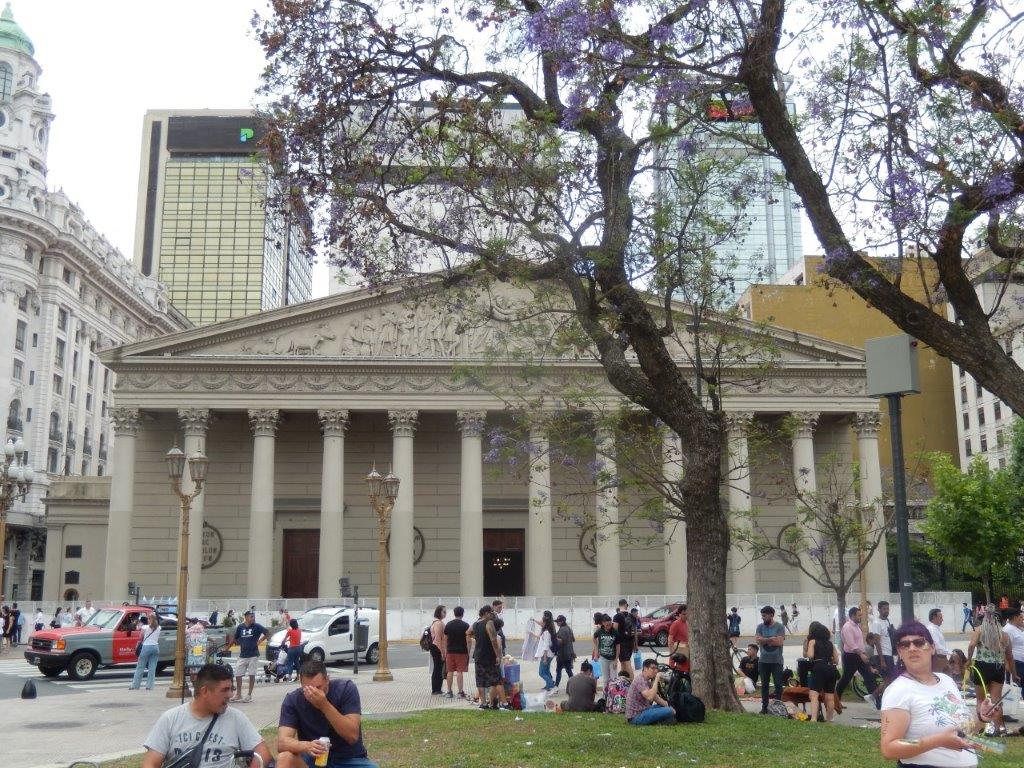 Avenida Diagonal Norte
Avenida Diagonal Norte
Avenida Roque Sáenz Peña, better known as Diagonal Norte (North Diagonal, the counterpart to Diagonal Sur), is an important avenue in the San Nicolás neighborhood of Buenos Aires, Argentina. It is oriented south-east/north-west, diagonally bisecting the city blocks (manzanas) which give the city centre a checkerboard plan. It is named after President Roque Sáenz Peña, who held power from 1910 to 1914 and passed the law which established universal suffrage, secret ballot and an electoral register.
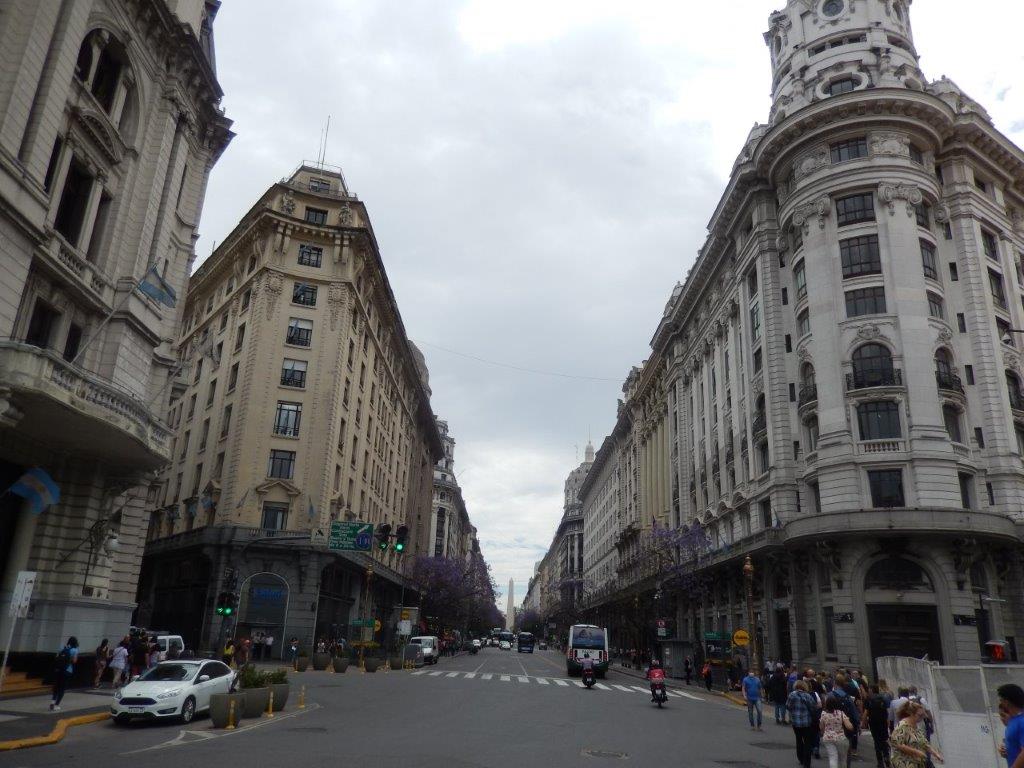 It connects the Plaza de Mayo, where the Buenos Aires Metropolitan Cathedral is located, with the Obelisco de Buenos Aires.
It connects the Plaza de Mayo, where the Buenos Aires Metropolitan Cathedral is located, with the Obelisco de Buenos Aires.
Obelisco de Buenos Aires
The 71.5 meters high Obelisco de Buenos Aires (Obelisk of Buenos Aires) is a national historic monument and icon of Buenos Aires. Located in the Plaza de la República in the intersection of avenues Corrientes and 9 de Julio, it was erected in 1936 to commemorate the quadricentennial of the first foundation of the city.
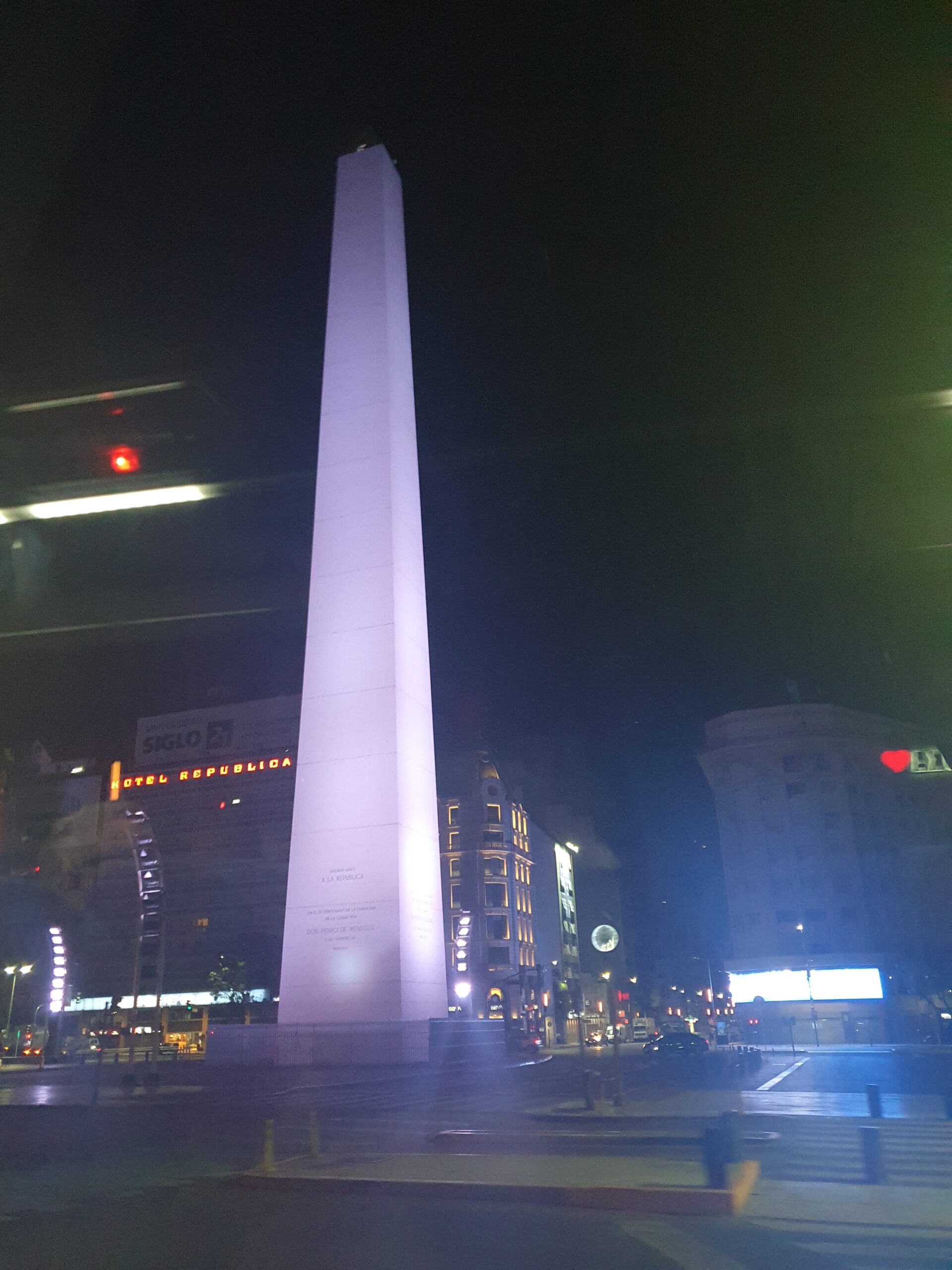
Festivities like e.g. the winning of the 2023 football worldcup draw celebrating crowds to this location.
Plaza Lavalle
Plaza Lavalle or Lavalle Square is one of the main squares in the city of Buenos Aires, the capital of Argentina.
Located in the San Nicolás neighborhood, except for its northern edge, which is part of the Retiro neighborhood, the square is in the shape of an elongated rectangle with a south-north axis. It is surrounded by Calle Lavalle (south), Avenida Córdoba (north), Calle Talcahuano (west) and Calle Libertad (east).
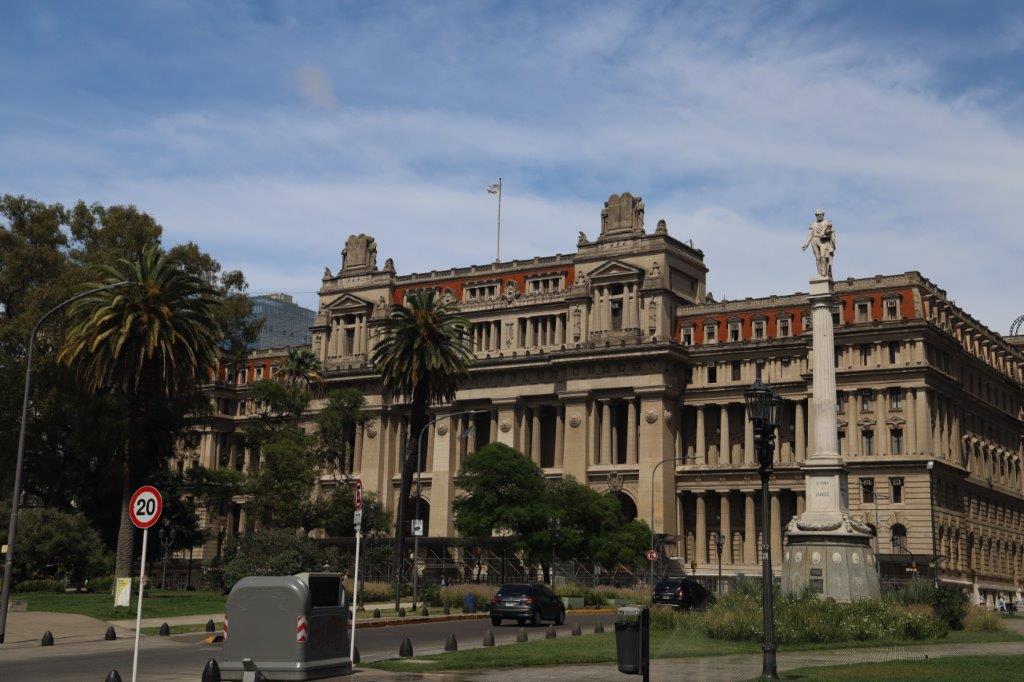 In its center is a column with on its pinnacle a statue of in memory of Juan Galo Lavalle (17 October 1797 – 9 October 1841) who was an Argentine military and political figure, by the Italian artist Pietro Costa.
In its center is a column with on its pinnacle a statue of in memory of Juan Galo Lavalle (17 October 1797 – 9 October 1841) who was an Argentine military and political figure, by the Italian artist Pietro Costa.
Teatro Colon
The Teatro Colón (Columbus Theatre) is the main opera house in Buenos Aires, Argentina. It is considered one of the ten best opera houses in the world by National Geographic. According to a survey carried out by the acoustics expert Leo Beranek among leading international opera and orchestra directors, the Teatro Colón has the room with the best acoustics for opera and the second best for concerts in the world.
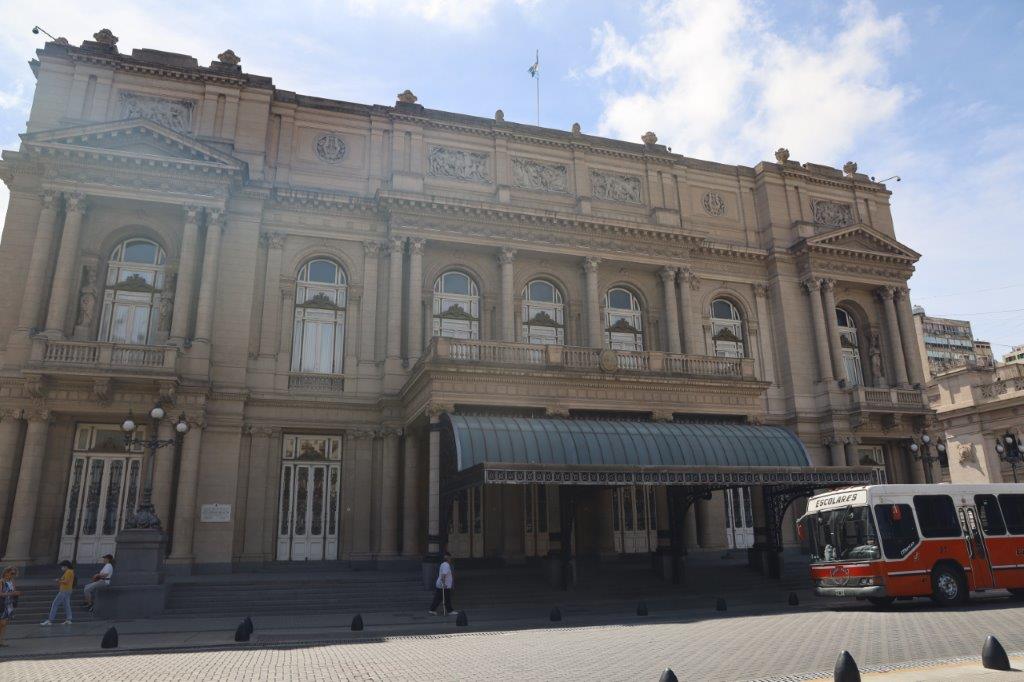 This makes it a famous place for artists to perform.
This makes it a famous place for artists to perform.
Beneath the backside of Teatro Colon:
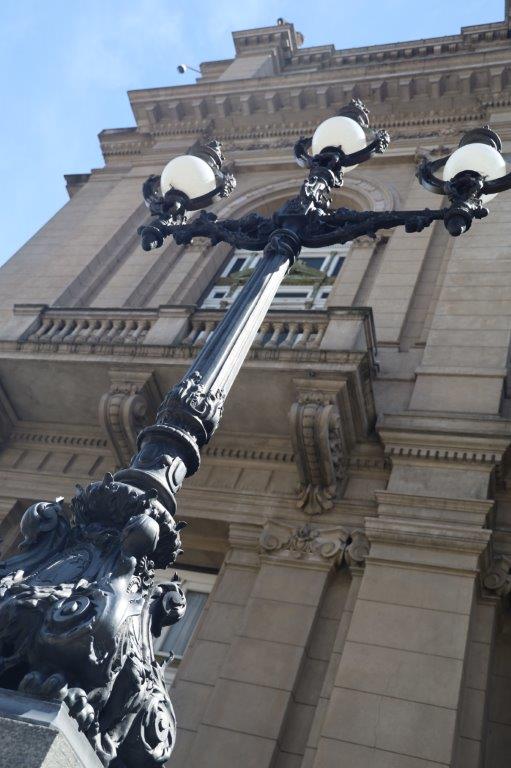 After a brief visit to the theater, The Wandelgek moved on through theneighbouring Retiro barrio.
After a brief visit to the theater, The Wandelgek moved on through theneighbouring Retiro barrio.
4. Retiro
Retiro is a barrio or neighborhood in Buenos Aires, Argentina. Located in the northeast end of the city, Retiro is bordered on the south by the Puerto Madero and San Nicolás, and on the west by the Recoleta.
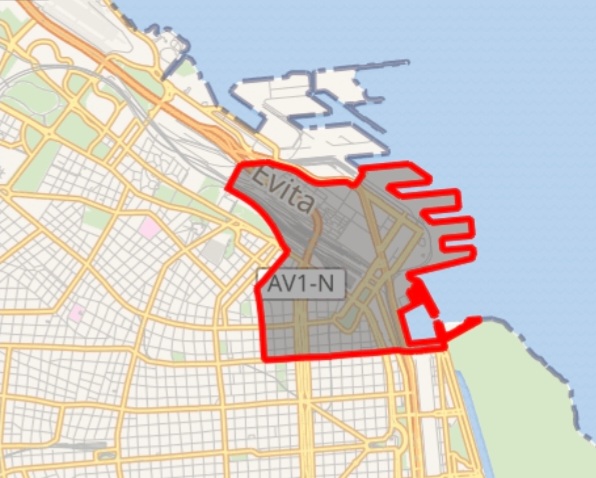
Barrio of Retiro
Plaza San Martin
Plaza San Martín (San Martín Square) is a park located in the Retiro neighbourhood of Buenos Aires, Argentina. Situated at the northern end of pedestrianized Florida Street, the park is bounded by Libertador Ave. (N), Maipú St. (W), Santa Fe Avenue (S), and Leandro Alem Av. (E).
Monument to José de San Martín
José Francisco de San Martín y Matorras (25 February 1778 – 17 August 1850), known simply as José de San Martín or the Liberator of Argentina, Chile and Peru, was an Argentine general and the primary leader of the southern and central parts of South America’s successful struggle for independence from the Spanish Empire who served as the Protector of Peru. Born in Yapeyú, Corrientes, in modern-day Argentina, he left the Viceroyalty of the Río de la Plata at the early age of seven to study in Málaga, Spain.
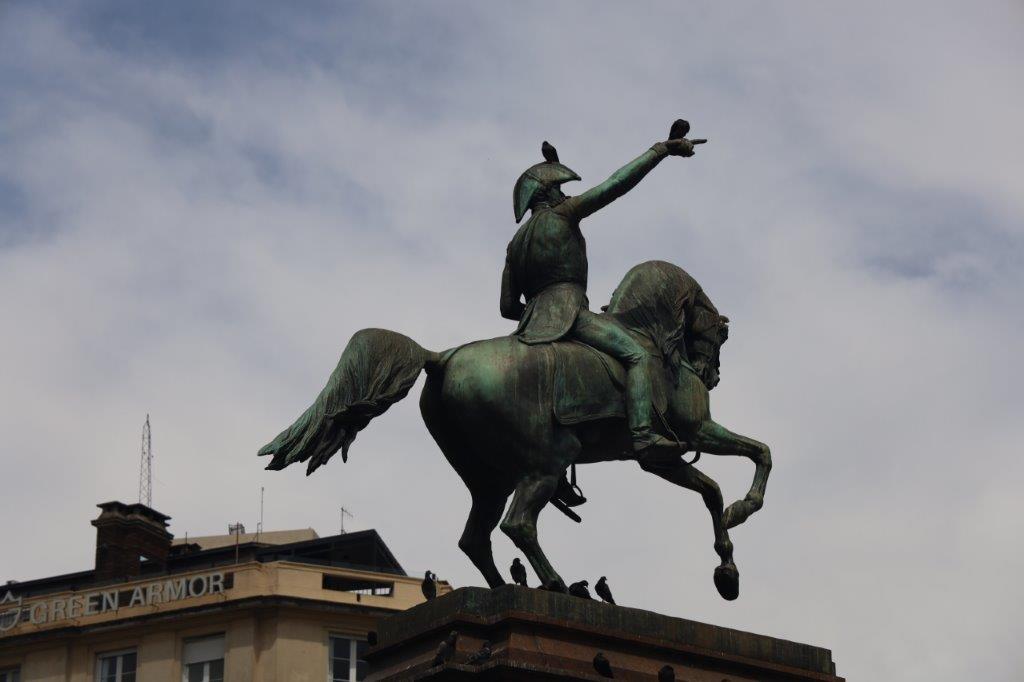 A succession of colonial Spanish governors had their official residences built on what today is the plaza and, in 1713, the land was sold to the British South Sea Company. The South Sea Company operated their slave trade out of the former governor’s residence and a fort and bullring were later built nearby. The land was the site of Gen. John Whitelocke’s 1807 defeat upon Britain’s second attempt to conquer Buenos Aires, whereby the area became known as the “Field of Glory”. The Revolution of 1810 brought an autonomous government to Buenos Aires, which entrusted the Mounted Grenadiers to José de San Martín and allowed him to establish his main barracks at the plaza. An 1813 resolution abolished the slave trade in the United Provinces of the Río de la Plata and the slave quarters were shuttered. Following his decisive military victories, Gen. San Martín was forced into exile in 1824 for political reasons; but a reappraisal of his place in history led to his becoming nearly eponymous in Argentina after his death in 1850.
A succession of colonial Spanish governors had their official residences built on what today is the plaza and, in 1713, the land was sold to the British South Sea Company. The South Sea Company operated their slave trade out of the former governor’s residence and a fort and bullring were later built nearby. The land was the site of Gen. John Whitelocke’s 1807 defeat upon Britain’s second attempt to conquer Buenos Aires, whereby the area became known as the “Field of Glory”. The Revolution of 1810 brought an autonomous government to Buenos Aires, which entrusted the Mounted Grenadiers to José de San Martín and allowed him to establish his main barracks at the plaza. An 1813 resolution abolished the slave trade in the United Provinces of the Río de la Plata and the slave quarters were shuttered. Following his decisive military victories, Gen. San Martín was forced into exile in 1824 for political reasons; but a reappraisal of his place in history led to his becoming nearly eponymous in Argentina after his death in 1850.
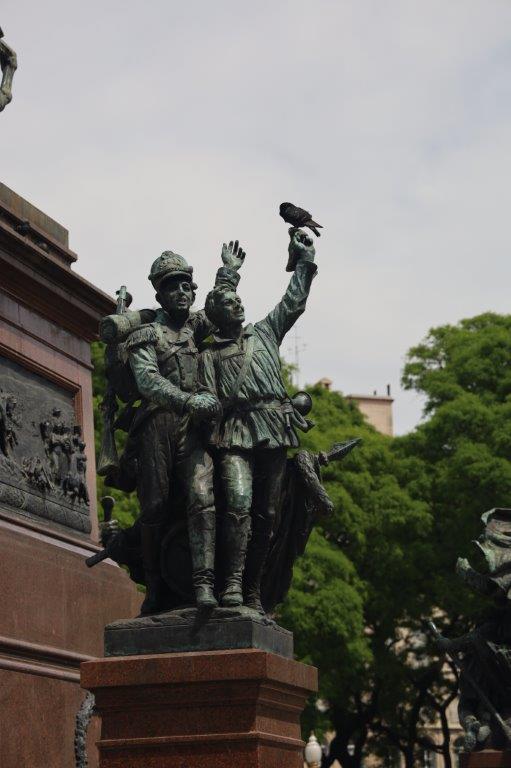 Accordingly, French sculptor Louis-Joseph Daumas was commissioned in 1862 to create an equestrian statue of the hero of the Wars for Independence and the square was renamed in his honor in 1878, upon the hundredth anniversary of his birth.
Accordingly, French sculptor Louis-Joseph Daumas was commissioned in 1862 to create an equestrian statue of the hero of the Wars for Independence and the square was renamed in his honor in 1878, upon the hundredth anniversary of his birth.
The park around the statue was full of blooming trees…
Torre de los Ingleses
In 1910 the British residents of Buenos Aires financed the construction of the Torre de los Ingleses (renamed in 1982 to Torre Monumental), on the occasion of the centenary of the May Revolution. The work was entrusted to the English architect Ambrose Macdonald Poynter, being inaugurated by the president Victorino de la Plaza on May 24, 1916 .
Basílica del Santísimo Sacramento
The Basilica of the Blessed Sacrament or Church of the Blessed Sacrament of the city of Buenos Aires, Argentina is a church located at 1039 San Martín Street in the Retiro neighborhood of that city, which was consecrated in 1914.
Ordered to be built by Mercedes Castellanos de Anchorena, the work was executed by the architects Coulomb and Chauvet and supervised by the superior brother of the Congregation of the Blessed Sacrament who chose the materials. His style is eclectic, the Angoulême Cathedral was taken as inspiration. Its construction, which took eight years, was promoted by Mercedes Castellanos de Anchorena, who lived in the Anchorena Palace located about 150 meters from the church. It is dedicated to Perpetual Adoration and in this basilica -unlike others from the same period- the Table of Sacrifice is not highlighted. Its architecture is harmonious and proportionate, it has five towers, three in the front and two in the apse, which, unlike Gothic cathedrals, are not arrows shot into the sky, nor are they the square walls of Romanesque churches.
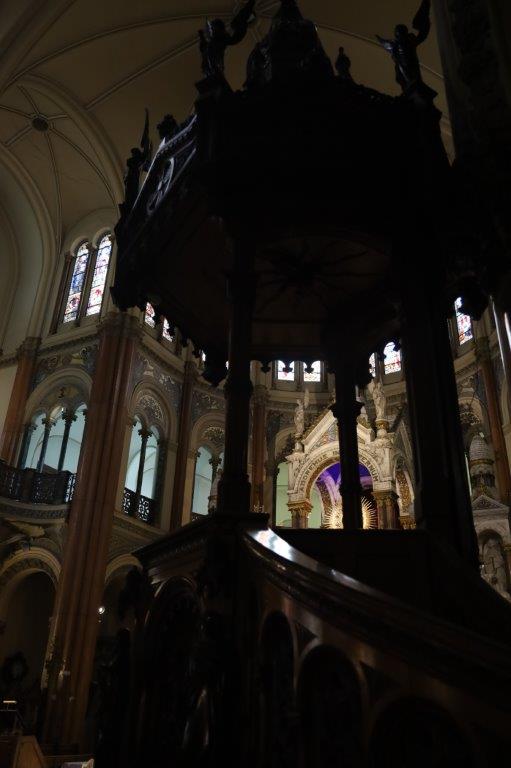 Its interior, which consists of three naves and is neo-Gothic in style, is decorated with highly valuable artistic pieces, highlighting the stained glass windows in the three main naves, gold and silver applications on the altar, the granite coverings from Baveno and the Vosges, as well as red marble from Verona and white from Carrara, garnet onyx from Morocco, blue granite and Venetian majolica, as well as artistic sculptures in white marble. It has wood carvings made in Europe and a Mutin – Cavaillé-Coll brand organ with five thousand pipes, inaugurated in 1915 with the interpretation of Widor’s Fifth Symphony in the presence of the owner of the musical instrument manufacturer Charles Mutin.
Its interior, which consists of three naves and is neo-Gothic in style, is decorated with highly valuable artistic pieces, highlighting the stained glass windows in the three main naves, gold and silver applications on the altar, the granite coverings from Baveno and the Vosges, as well as red marble from Verona and white from Carrara, garnet onyx from Morocco, blue granite and Venetian majolica, as well as artistic sculptures in white marble. It has wood carvings made in Europe and a Mutin – Cavaillé-Coll brand organ with five thousand pipes, inaugurated in 1915 with the interpretation of Widor’s Fifth Symphony in the presence of the owner of the musical instrument manufacturer Charles Mutin.
It is considered one of the most luxurious churches in the city of Buenos Aires and the one chosen to celebrate weddings by Buenos Aires high society. In a crypt lie the remains of Mrs. Mercedes C. de Anchorena, who had declared that “if she lived in a Palace, her God should have her own.”
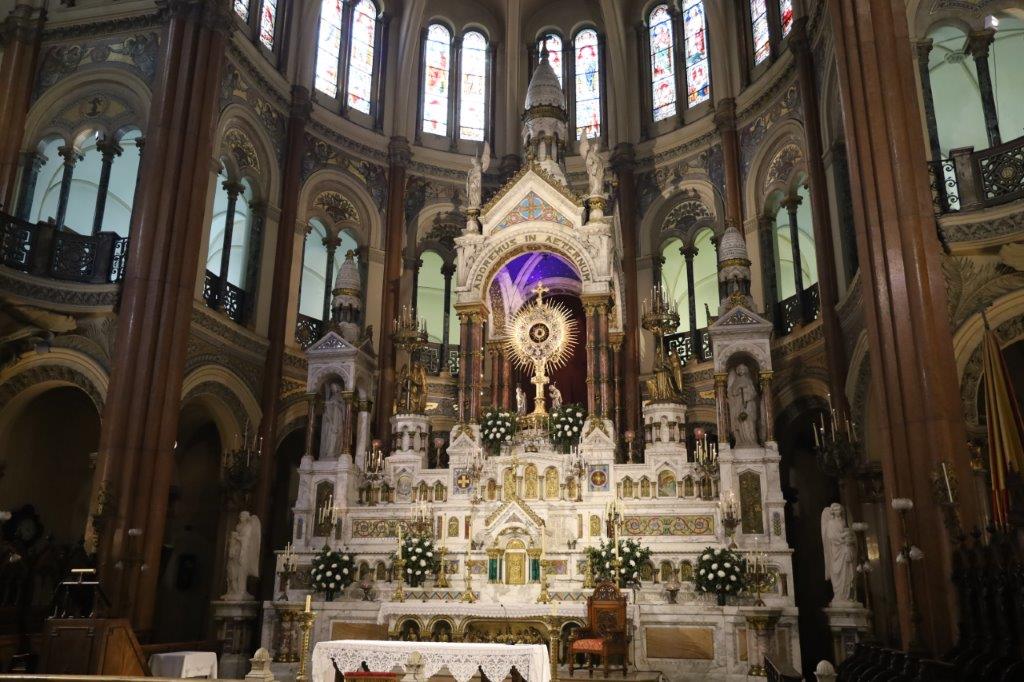 It was time for a coffee break. For this, The Wandelgek went to the next barrio; La Recoleta.
It was time for a coffee break. For this, The Wandelgek went to the next barrio; La Recoleta.
5. La Recoleta
Recoleta is a barrio or neighborhood of Buenos Aires, Argentina, located in the northern part of the city, by the Río de la Plata. The area is perhaps best known to be the home of the distinguished Recoleta Cemetery.
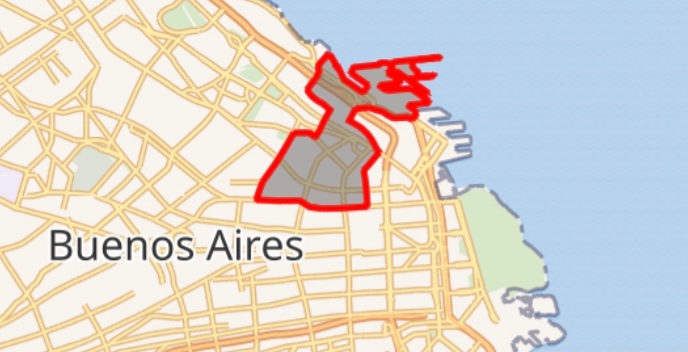
Barrio of La Recoleta
It is a traditional upper-class and conservative neighborhood with some of the priciest real estate in the city, known for Paris-style townhouses, lavish former palaces and posh boutiques.
The historical center of the neighborhood is the Church of Nuestra Señora del Pilar, construction of which was completed in 1732. For that reason, the neighborhood was occasionally called El Pilar. The church was originally situated at the edge of the banks that sloped down to the Río de la Plata and Manso Creek. The creek, also known as Tercero del Norte, currently flows through an underground pipe, and runs below present-day Pueyrredón Avenue. It formed a type of small delta, with channels along the current Austria and Tagle Streets, which flowed into the Río de la Plata.
When Buenos Aires suffered terrible cholera and yellow fever epidemics in the 1870s, the population of the city spread out to avoid the contagion. It was for that reason that, while the underprivileged classes settled in the south-southwest of the city, the most wealthy settled in the Recoleta area, where the height of the terrain reduced the presence of insects which transmitted the diseases.
These families (many of which were members of the ruling national elite, considered of “noble” ancestry (although there were no noblemen in the former Hispanic territories) for having descended from respected historical figures from the period of Argentine independence), built mansions and other notable buildings in several European architectural styles of the period (many of which were demolished towards the end of the 1950s and beginning of the 1960s and once again during the 2000s). Consequently, Buenos Aires has often been referred to as the “Paris of South America”. Nowadays, what is left of these traditional buildings coexist with elegant modern constructions.
Together with some sections of the neighboring communities of Retiro and Palermo, Recoleta forms a part of the area known as Barrio Norte, Buenos Aires, a traditional residential zone for the city’s most affluent families, where a great portion of the cultural life of the city is concentrated.
One thing The Wandelgek noticed were these often young men walking a large bunch of dogs. These guys are walking these dogs for a fee paid by their rich owners who feel the need to own a dog (status) but don’t have the time to walk the dog 3 or 4 times per day. Recoleta and Palermo are neighbourhoods were lots of the wealthy citizens of Buenos Aires live. The men work and the ladies are either working or shopping.
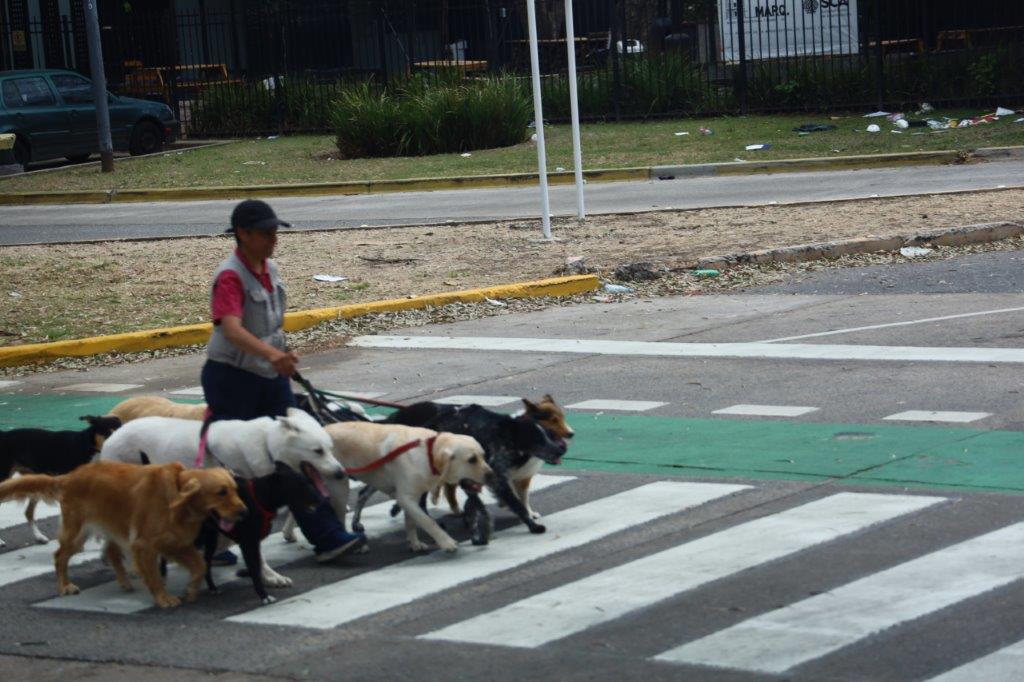 The neighborhood is served by Line D and Line H of the Buenos Aires Underground, as well as by many bus lines in Avenida Santa Fe.
The neighborhood is served by Line D and Line H of the Buenos Aires Underground, as well as by many bus lines in Avenida Santa Fe.
Buenos Aires has really great places for coffee breaks, like e.g:
La Biela café
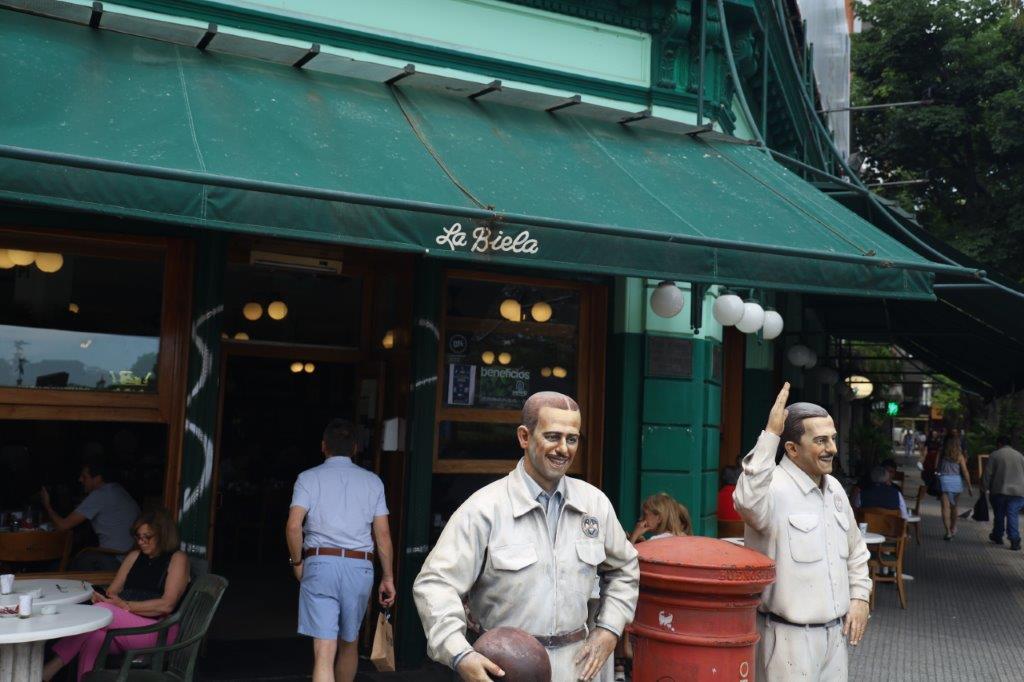 Café La Biela (The Connecting-rod Café) is a traditional café in the Recoleta district of Buenos Aires, Argentina situated at 600 Quintana Avenue on the corner of Junin street, opposite the church of Nuestra Senora del Pilar and the adjoining Recoleta Cemetery.
Café La Biela (The Connecting-rod Café) is a traditional café in the Recoleta district of Buenos Aires, Argentina situated at 600 Quintana Avenue on the corner of Junin street, opposite the church of Nuestra Senora del Pilar and the adjoining Recoleta Cemetery.
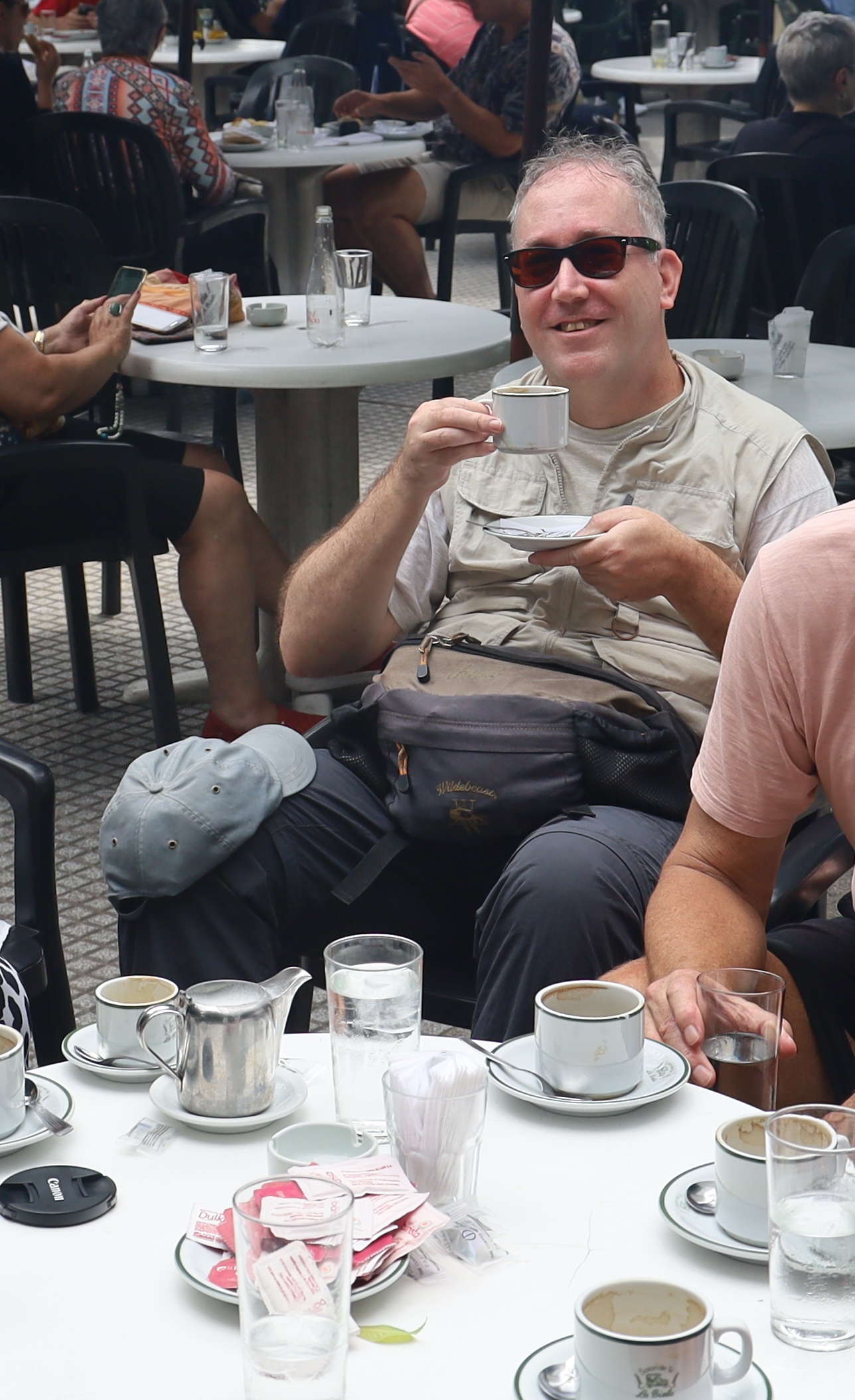 The café has a large terrace in front with outdoor tables under the shade of a giant rubber tree, and is a popular with locals and tourists alike. In front of its entrance are 2 life-like statues who smile friendly while welcoming you or waving you goodbye.
The café has a large terrace in front with outdoor tables under the shade of a giant rubber tree, and is a popular with locals and tourists alike. In front of its entrance are 2 life-like statues who smile friendly while welcoming you or waving you goodbye.
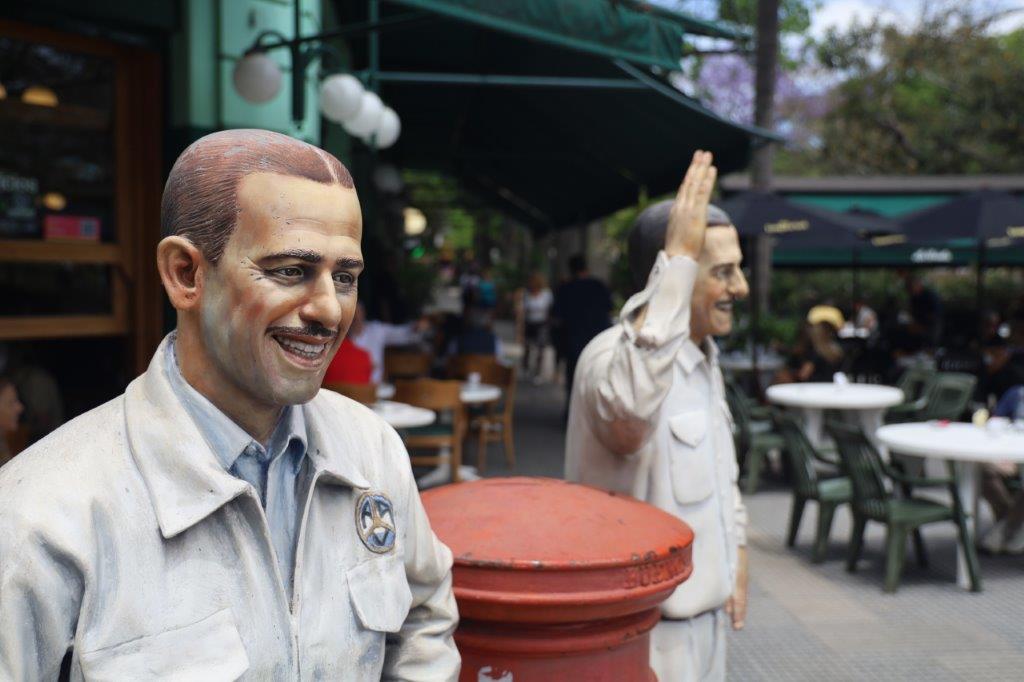 Interior
Interior
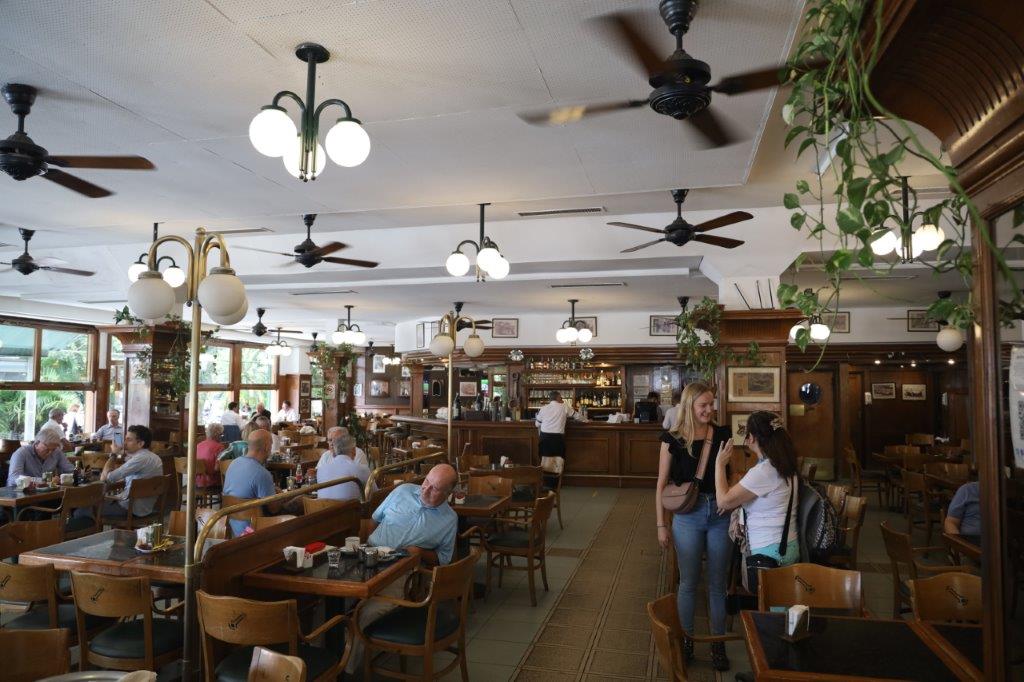 Black-and-white photos of racing car champions, together with a variety of motoring memorabilia (including radiator grills, connecting rods, lamps and horns) decorate the walls of the traditional interior which has wood paneling and curtains at the windows.
Black-and-white photos of racing car champions, together with a variety of motoring memorabilia (including radiator grills, connecting rods, lamps and horns) decorate the walls of the traditional interior which has wood paneling and curtains at the windows.
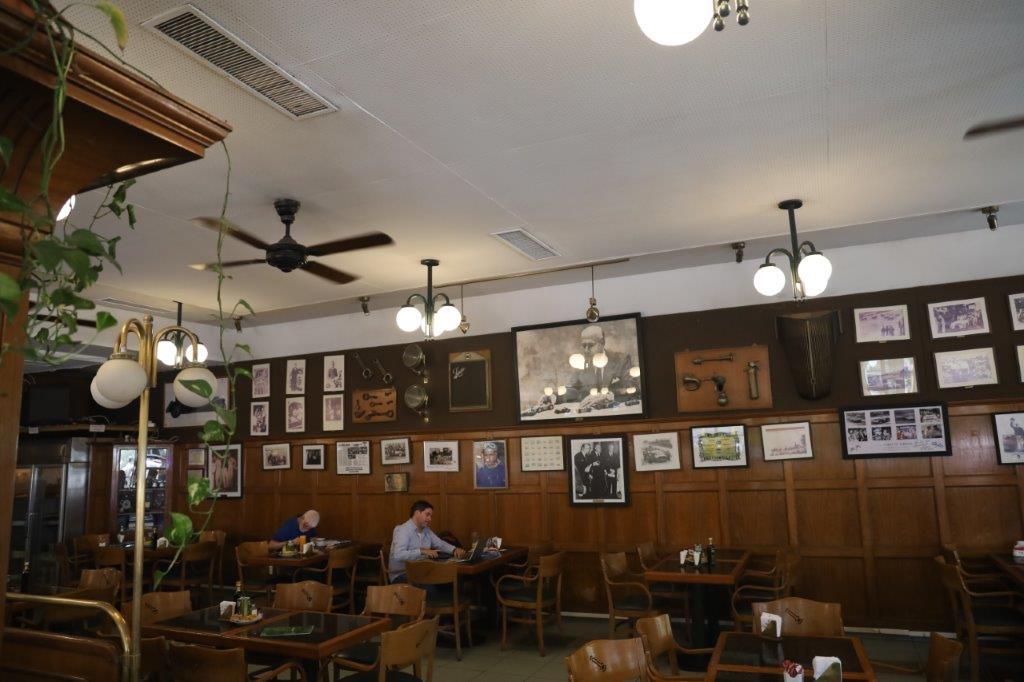 Behind the bar are photographs taken by the Argentine writer Adolfo Bioy Casares, who used to frequent the café along with his writer friend Jorge Luis Borges, and who took these photographs to illustrate a book they wrote together.
Behind the bar are photographs taken by the Argentine writer Adolfo Bioy Casares, who used to frequent the café along with his writer friend Jorge Luis Borges, and who took these photographs to illustrate a book they wrote together.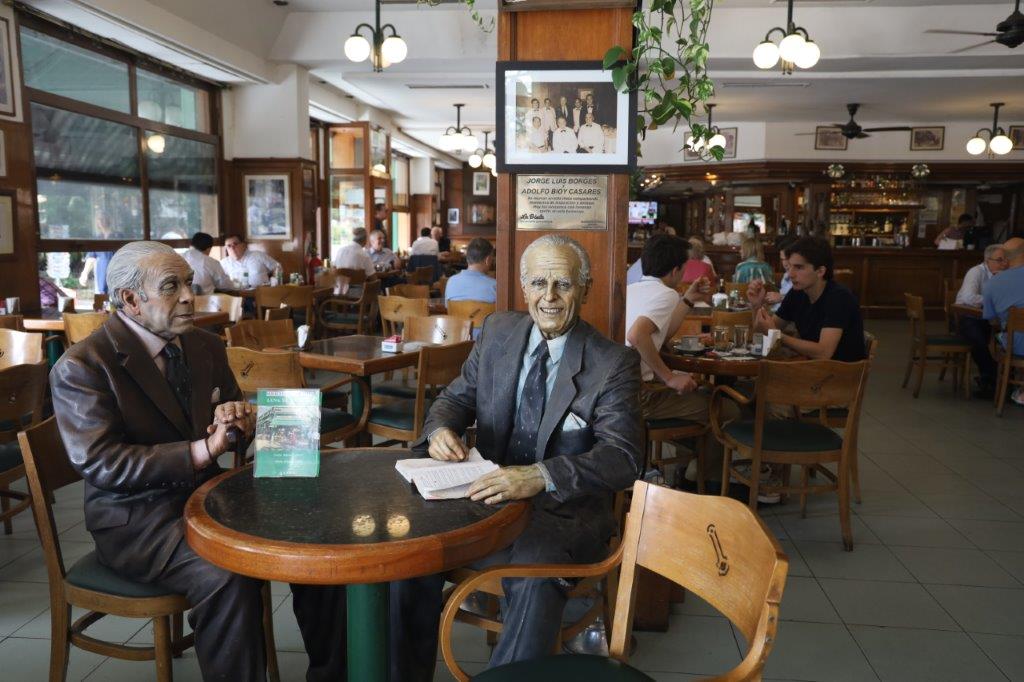 As you enter, you’re greeted by a table occupied by life-like statues of two men who used to frequent the place, Argentine writer Adolfo Bioy Casares and his writer friend Jorge Luis Borges, both of whom wrote a book together and whose photos adorn the restaurant’s walls.
As you enter, you’re greeted by a table occupied by life-like statues of two men who used to frequent the place, Argentine writer Adolfo Bioy Casares and his writer friend Jorge Luis Borges, both of whom wrote a book together and whose photos adorn the restaurant’s walls.Today
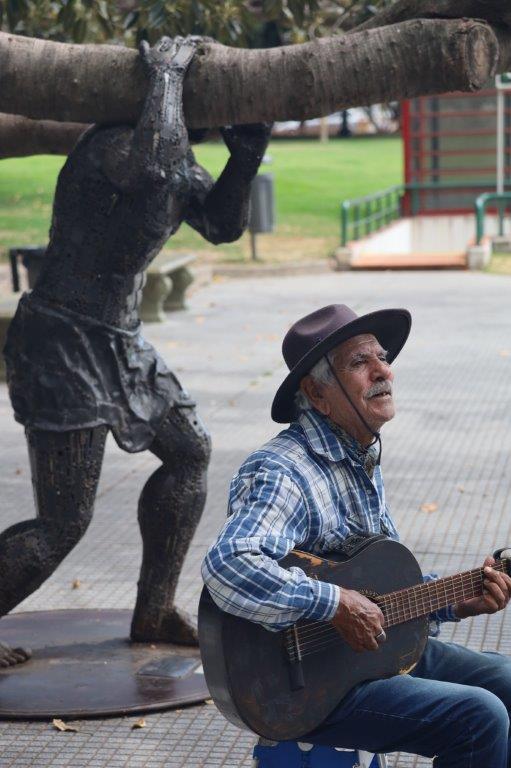
I thought he had a very photogenic head…
Famous Rubber Tree: Gomero de la Recoleta
The Gomero is a huge rubber tree planted in the late 18th century so it is over 200 years old. It has a spread of 50 meters and a height of 20 meters.
Centro Cultural Recoleta
Built in 1732, this building was originally the convent of the Recoleto monks – from whom the Recoleta neighbourhood took its name. It later served as a hospital, military barracks, refuge for the homeless and an elderly people’s home.
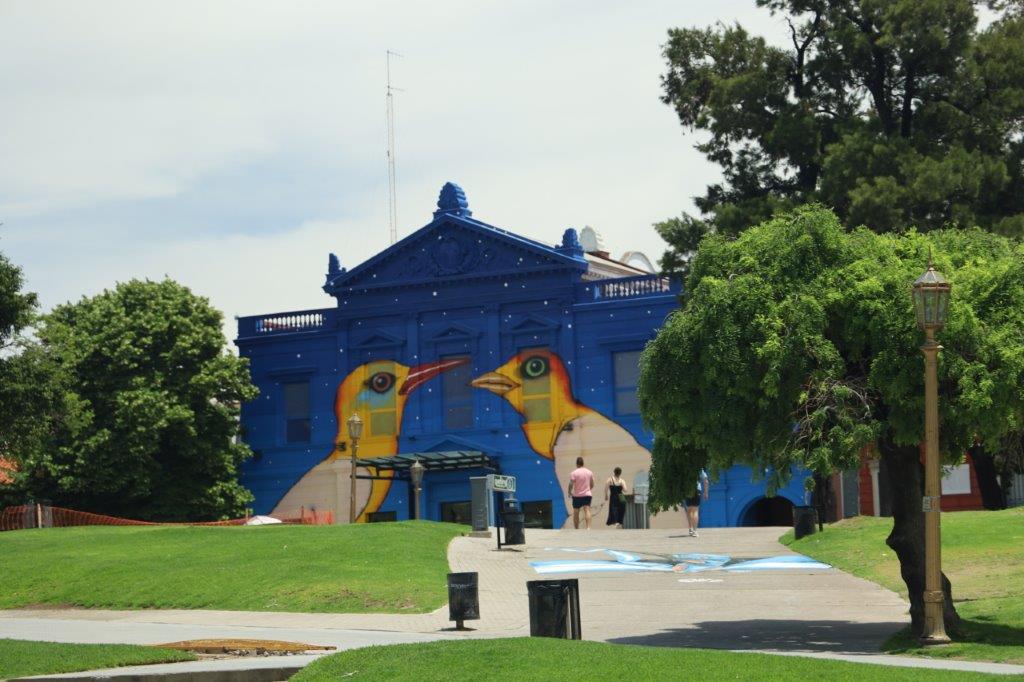 The facade of the cultural center has had many different painted decorations through the years.
The facade of the cultural center has had many different painted decorations through the years.
Church of Nuestra Senora del Pilar
The name of the neighborhood comes from the monastery – the Recollect Convent (Convento de la Recoleta) – of the Recollect fathers, members of the Franciscan Order, which was established in the area at the beginning of the 18th century. They founded a monastery and a church dedicated to Nuestra Señora del Pilar (the virgin Mary) with a cemetery attached.
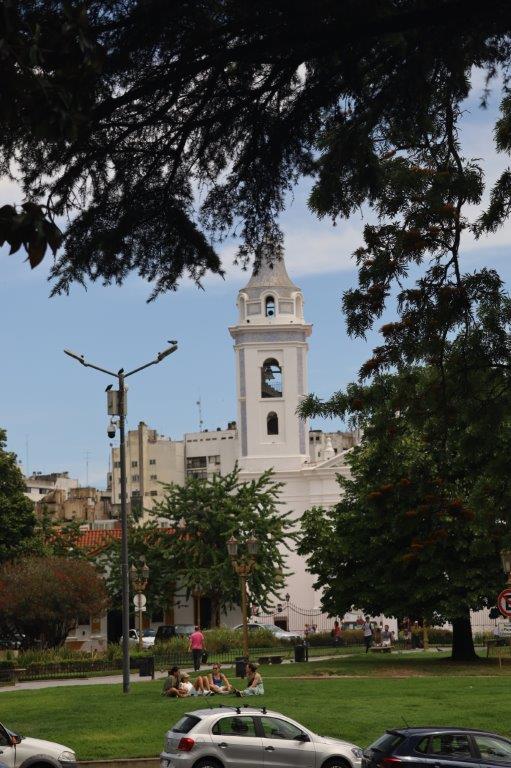 Our Lady of the Pillar (Nuestra Señora del Pilar) is the name given to the Blessed Virgin Mary in the context of the traditional belief that Mary, while living in Jerusalem, supernaturally appeared to the Apostle James the Greater in AD 40 while he was preaching in what is now Spain. Those who adhere to this belief consider this appearance to be the only recorded instance of Mary exhibiting the mystical phenomenon of bilocation. Among Catholics, it is also considered the first Marian apparition, and unique because it happened while Mary was still living on Earth.
Our Lady of the Pillar (Nuestra Señora del Pilar) is the name given to the Blessed Virgin Mary in the context of the traditional belief that Mary, while living in Jerusalem, supernaturally appeared to the Apostle James the Greater in AD 40 while he was preaching in what is now Spain. Those who adhere to this belief consider this appearance to be the only recorded instance of Mary exhibiting the mystical phenomenon of bilocation. Among Catholics, it is also considered the first Marian apparition, and unique because it happened while Mary was still living on Earth.
Next to the church is the famous Recoleta Cemetry, where among others, Eva Perón has a grave, but The Wandelgek skipped visiting that.
Floralis Generica
Floralis Genérica is a sculpture made of steel and aluminum located in Plaza de las Naciones Unidas, Avenida Figueroa Alcorta, Buenos Aires, a gift to the city by the Argentine architect Eduardo Catalano. Catalano once said that the flower “is a synthesis of all the flowers and, at the same time, a hope reborn every day at opening.” It was created in 2002. The sculpture was designed to move, closing its petals in the evening and opening them in the morning.
The sculpture is located in the center of a park of four acres of wooded boundaries, surrounded by paths that get closer and provide different perspectives of the monument, and placed above a reflecting pool, which apart from fulfilling its aesthetic function, protects it. It represents a large flower made of stainless steel with aluminum skeleton and reinforced concrete, which looks up at the sky, extending to its six petals. It weighs eighteen tons and is 23 meters high.
One of the characteristics of the flower is an electrical system that automatically opens and closes the petals depending on the time of the day. At night the flower closes, emanating a red glow from inside, and reopens (“…is reborn…”) the following morning. This mechanism also closes the flower if strong winds blow.
It opens every morning at 8 and closes at sunset, on a schedule that changes according to the season. When its petals were inaugurated, they didn’t close due to technical problems which were solved two months later.
There are four special nights in which the petals are open: May 25, September 21, December 24 and December 31.
According to Eduardo Catalano, the author, Floralis “means belonging to the flora and therefore the flowers”, and Genérica “from the concept of “gender” and indicates that it represents all the flowers in the world”.
The electronics employed in opening and closing the flower were disabled in 2010 to prevent damaging the sculpture, and it remained permanently open until 2015. This was due to the fact that one of the petals was incorrectly installed during its assembly, as noted by Catalano himself. The company responsible for its construction, Lockheed Martin Aircraft Argentina, provided a 25-year warranty, but as the company was nationalized in 2009 its repair was delayed. The mechanism was functional again by June 2015.
Measurements
- 23 meters high
- Diameter:
- Petals closed: 26 meters
- Petals open: 32 meters
- Diameter of the reflecting pool: 44 meters
Maria Eva Duarte de Perón Monument
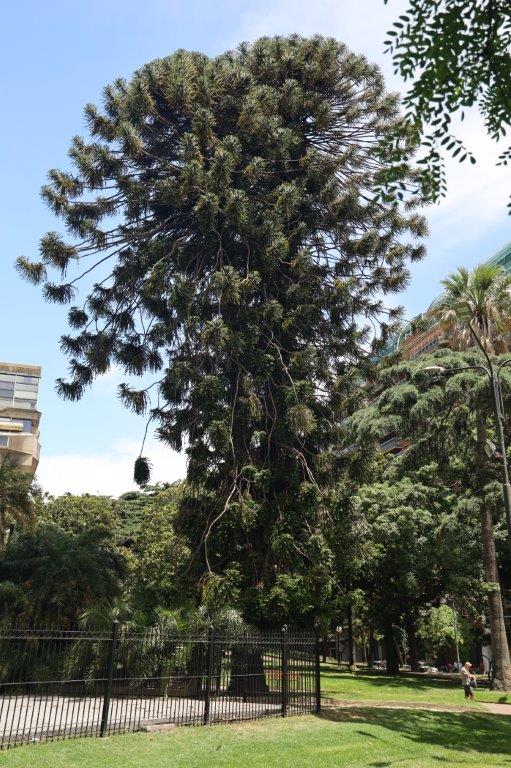
In a small park baring the name: Plaza Evita Perón, is the Maria Eva Duarte de Perón Monument. It is known that before marrying Juan Domingo Perón, Eva moved to Buenos Aires (coming from a small rural village), found jobvs a a performer and became a succesful model and later movie actress. As a result of her success with radio dramas and the films, Eva achieved some financial stability. In 1942, she was able to move into an apartment in the exclusive neighborhood of Recoleta, on 1567 Calle Posadas. The next year, Eva began her career in politics, as one of the founders of the Argentine Radio Syndicate (ARA).
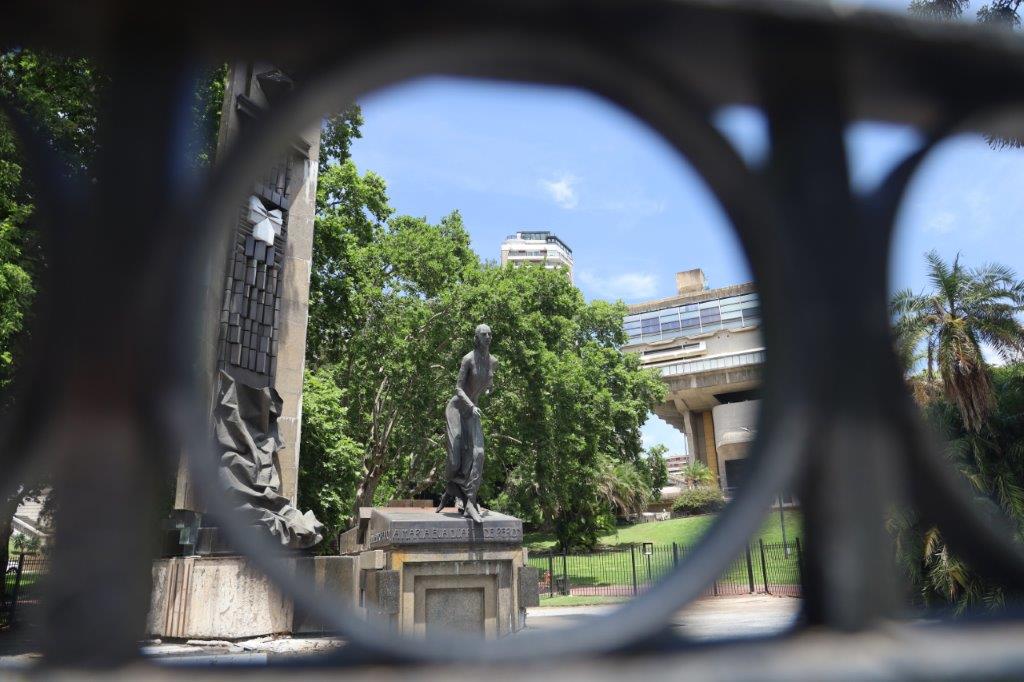 On 15 January 1944, an earthquake occurred in the town of San Juan, Argentina, killing ten thousand people. In response, Perón, who was then the Secretary of Labour, established a fund to raise money to aid the victims. He devised a plan to have an “artistic festival” as a fundraiser, and invited radio and film actors to participate. After a week of fundraising, all participants met at a gala held at Luna Park Stadium in Buenos Aires to benefit earthquake victims.
On 15 January 1944, an earthquake occurred in the town of San Juan, Argentina, killing ten thousand people. In response, Perón, who was then the Secretary of Labour, established a fund to raise money to aid the victims. He devised a plan to have an “artistic festival” as a fundraiser, and invited radio and film actors to participate. After a week of fundraising, all participants met at a gala held at Luna Park Stadium in Buenos Aires to benefit earthquake victims.
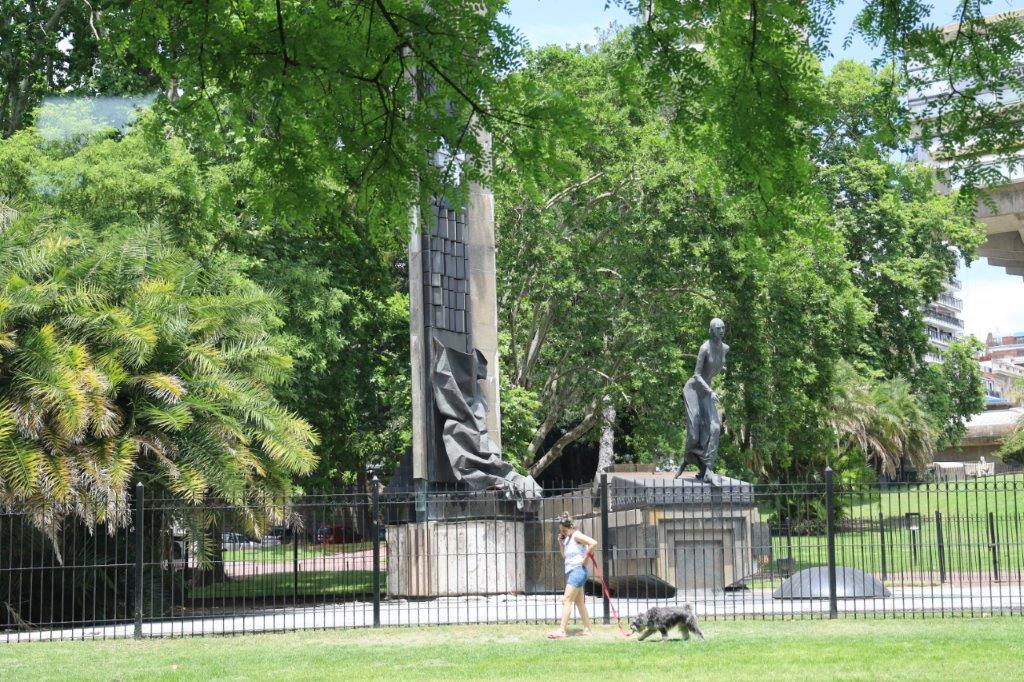
It was at this gala, on 22 January 1944, that Eva Duarte first met Colonel Juan Perón. Eva promptly became the colonel’s girlfriend. She referred to the day she met her future husband as her “marvelous day”. Juan Perón and Eva left the gala together at around two in the morning. (Perón’s first wife, Aurelia Tizón, had died of uterine cancer in 1938.)
Bibliotheca Nacional
The statue is located in front of the Bibliotheca Nacional. This building which took 30 years to construct, was inaugurated in 1992. It was build on the location of the former Unzué Palace, which was then the presidential palace, but it was torn down in 1955 because the military government considered it “contaminated” by the fact that the Peróns had lived there (and Evita died in the building). The statue was erected in 1999.
The library has several millions of books and a newspaper library as well with extensive reading rooms. A larfe outside park space with benches for readers is also property of the library. Its most famous exhibits are a first edition of Don Quixote and a desk used by novelist Jorge Luis Borges, who once had been the library’s director.
Then The Wandelgek drove to the next Barrio he wanted to visit:
6. La Boca
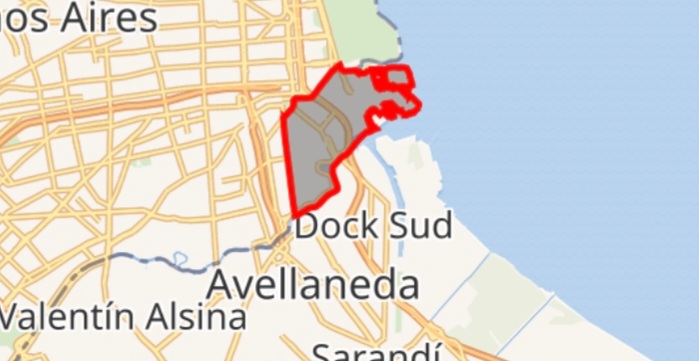
Barrio of La Boca
La Boca; “the Mouth”, probably of the Matanza River) is a neighborhood (barrio) of Buenos Aires, the capital of Argentina. It retains a strong Italian flavour, many of its early settlers having originated in the city of Genoa. The actual area visited by tourists is only a few blocks long and has been built up for tourism very actively over the last few years, with many market stalls and restaurants catering to tourists. Outside this tourist area, it is a fairly poor neighborhood that has had many regular occurrences of petty crimes reported. On the other hand I also saw men walking dogs, just like I previously saw in La Recoleta…
There were these large flats which normally would have been a boring and inspirationless place to live, but these flats had large street art paintings on their blind windowless side walls…
People living here had a view over the football training fiels and the football stadium of Boca Juniors…
Stadion Boca Juniors
The club colors blue and yellow were present everywhere…
even in some paintings…
“They are all unforgettable. Those here, and those we will hear from tomorrow.”/ Todos son inolvidables. aquellos, estos y los que vendran…
Personality Cult: Diego Maradona
Diego Amando Maradona (30 October 1960 – 25 November 2020) was an Argentine professional football player and manager. Widely regarded as one of the greatest players in the history of the sport, he was one of the two joint winners of the FIFA Player of the 20th Century award. He was also present almost everywhere in La Boca, starting at the Stadium of Boca Juniors, the club where he signed a contract on 20 February 1981. He made his debut two days later against Talleres de Córdoba, scoring twice in the club’s 4–1 win. On 10 April, Maradona played his first Superclásico against River Plate at La Bombonera stadium. Boca defeated River 3–0 with Maradona scoring a goal after dribbling past Alberto Tarantini and Fillol. Despite the distrustful relationship between Maradona and Boca Juniors manager, Silvio Marzolini, Boca had a successful season, winning the league title after securing a point against Racing Club. That would be the only title won by Maradona in the Argentine domestic league. After the 1982 Worldcup, Maradona left for his great European adventures in Barcelona and Naples.
The Wandelgek has seen lots of examples of personality cult on his travel, like in Turkmenistan, Russia and China even that of Eva Perron in Argentina, but this was the 1st one which was not top down but bottom up, meaning it was a personality cult coming from the people, not from its leaders.
Of course there was also a Boca Juniors fan shop, where the new Argentine football hero Leonel Messi was garding the entrance (bare in mind he did not win the 2023 worldcup yet when I visited La Boca).
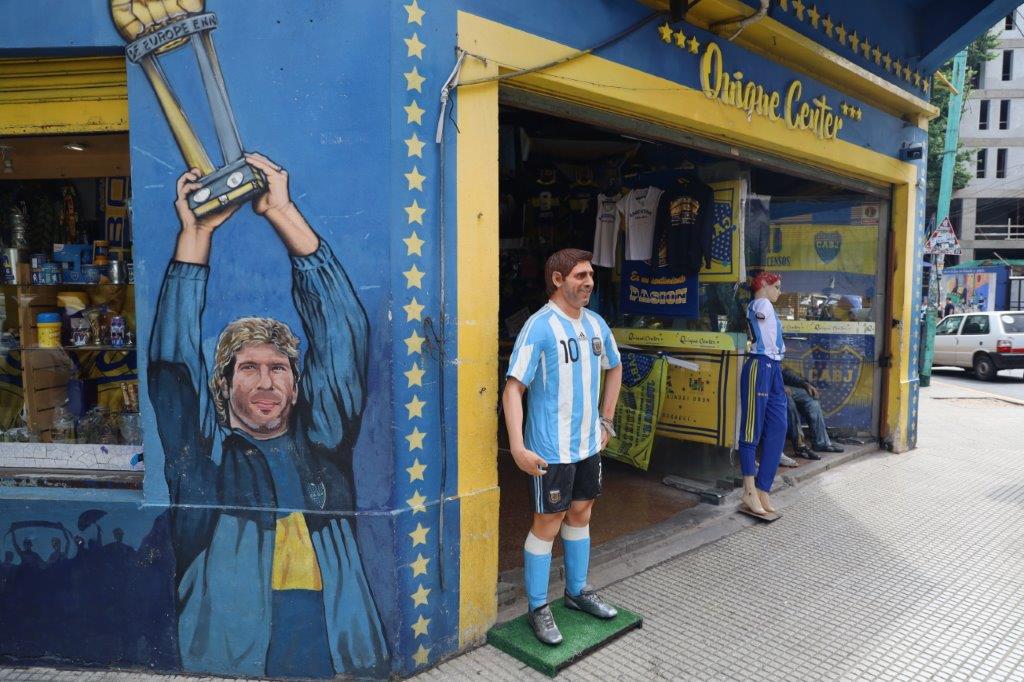
Where Football meets Politics
In 1978, the Dutch team played the Worldcup final against Argentina. In those days, Argentina was still ruled by a Miltary dictator and the mothers at the Plaza de Mayo tried to get the trueth out in the open about the many sons that had disappeared under the Videla regime. The military government tried to conseal this as much as possible, but dutch football fans interviewed the Mothers and videotaped these interviews. The regime was informed about this and prepared to confiscate and destroy these videotapes when the dutch fans would leave the country. But the dutch fans were warned that this would happen and they asked German football fans of whom most were leaving the country earlier, to take these tapes to Europe and they did. The story of the mothers got out in Europe and became internationally known.
Italians
Argentina is a very large land (number 8 of largest countries in the world), but it is also a very empty land with not a large population. This is why many Europeans, like the Swiss, Germans, Welsh and also Italians were encouraged to come to Argentina and start a living there. Massive settlement of La Boca began in 1830 of immigrants from Genoa, Italy. Coming from a port city, it was natural for the Genoese to settle along the Buenos Aires waterfront. There were so many Genoese in La Boca at that time that some say the name is a spin-off of the name Boccadasse, a neighborhood in Genoa. The new inhabitants constructed tenements made of scrap metal and painted the shacks with bright leftover marine paint to brighten up the one-time wasteland. Soon the Italians were joined by immigrants from other European countries like e.g. Spain, Greece, France, England, Ireland and, Eastern Europe.
By the turn of the 19th century the area was the second most populated zone in Buenos Aires but the construction of a new port in Puerto Madero (where The Wandelgek went next) meant the shipping industry would move northward. As Argentina entered its golden era, residents moved further inland and La Boca began to decline.
La Caminito
In the 1950’s a revival of La Boca occured because local artists began to open little ateliers and studios in the colorful houses, mainly at La Caminito.
After the General Roca railway train line, which ran through here shut down in 1954, Quinquela Martín, a famous Argentine artist who lived in La Boca, set to work to save the barrio. He gathered neighbors to paint the houses bright colors, emulating the early immigrants. The artists began to host outdoor theater here utilizing the colorful houses as part of the backdrop. The government officially declared Camanito street an open air museum in 1959. And it does look like that…
The harbour
La Camanito ends at the harbour where once, long ago the Italians had worked on ships.
The Wandelgek stayed a bit in the harbour area but also remembered to be careful when walking through La Boca. There were lots of things to think about, like not dressing to flashy and to not carry valuable stuff that you cannot miss. Try to not look like a foreigner (in Buenos Aires live lots of European and Asian mix people so it isn’t that impossible to do) and not look like a wealthy person either. Divide money over several locations, preferably in several bags and if possible partly in a hotelroom vault. Don’t wear a wallet, but use a moneybelt instead. At Camanito, La Boca is is mostly safe in day time, but when going there for a dinner at night time, take a cab to the doorstep. Outside La Caminito, La Boca is an area where less fortunate people live so preferably do not go there alone. Hope these tips avoid you becoming a victim of petty crime.
Again there were loads of artworks depicting either Diego Maradona or Leonel Messi…
At a small square where there were many colorful restaurants, The Wandelgek ordered a typical low alcholic sugar cane drink and a Chorizo sausage burger.
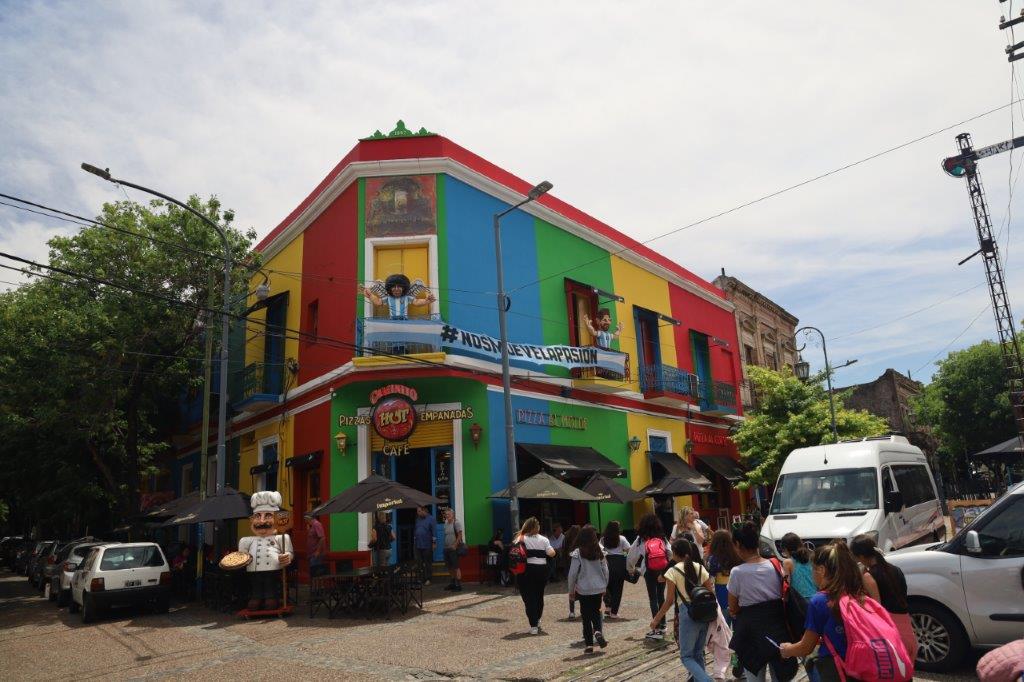
Outside of the Caminito area were lots of really beautiful streetart and griffity art works covering the otherwise grey walls:
Then The Wandelgek decided to move on towards one of the newer barrios of Buenos Aires:
7. Puerto Madero
Puerto Madero, also known within the urban planning community as the Puerto Madero Waterfront, is a barrio of Buenos Aires in Argentina in the central business district, occupying a significant portion of the Río de la Plata riverbank and representing the latest architectural trends.
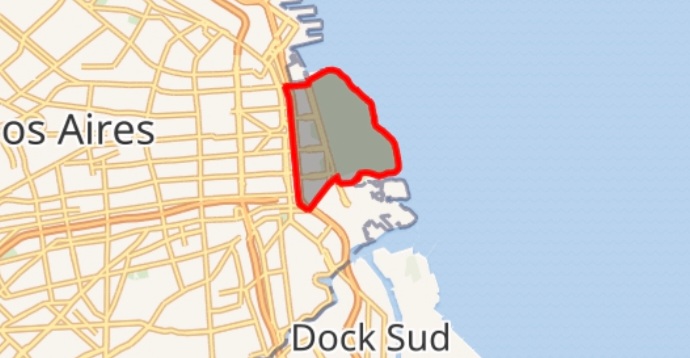
Barrio of Puerto Maduro
From its inception, the city of Buenos Aires had a problem accommodating large cargo ships, as per Puerto La Boca, because the shallow river did not allow for direct docking. Instead ships were moored away from the shore and passengers and merchandise were unloaded onto barges and ferries for transport to the pier.
In 1882 the national government contracted the local businessman Eduardo Madero to take charge of the construction of a new port which would solve these problems. Construction began in 1887 and was completed in 1897, although the installed fittings had been partially operative some years before completion of the port. It was a costly project and an engineering landmark at the time but ten years after its completion the appearance of larger cargo ships made Puerto Madero obsolete.
The government had to then face the construction of a new port, this time contracting engineer Luis Huergo, whose plans for a port of staggered docks which would open directly onto the river was among those rejected in the 1880s. His plans resulted in the “Puerto Nuevo” (New Port), still operating today, whose first section opened in 1911.
The New Port of Buenos Aires was completed in 1926, making the existing Madero docks superfluous. Though these continued to serve in ancillary port functions, the zone gradually decayed, becoming one of the city’s most degraded areas, a mixture of warehouses and large tracts of undeveloped land. In 1925, 1940, 1960, 1969, 1971, 1981 and 1985, successive proposals were put forth with the intent of urbanizing the old port, or to demolish it outright; none of these plans came to fruition, however.
On November 15, 1989, the Ministry of Works and Public Services, the Department of the Interior and the City of Buenos Aires signed the acts of incorporation of a joint-stock company denominated “Corporación Antiguo Puerto Madero” (“Old Puerto Madero Corporation”). Having as objective the urbanization of the area, the federal and city governments participated as egalitarian partners.
The 170 hectares of the place had overlapping jurisdictions: the General Administration of Ports, Argentine railroads and the “Junta Nacional de Granos” (National Grain Board) had interests in the zone. The signed agreement implied the transference of the totality of the area to the Old Puerto Madero Corporation S.A., whereas the government of the city remained in charge of the urban development regulations.
In the 1990s, local and foreign investment led to a massive regeneration effort, recycling and refurbishing the west side warehouses into elegant houses, offices, lofts, private universities, luxurious hotels and restaurants that conform to a gallery of options for this new district in a city that grew up turning its back to the river.
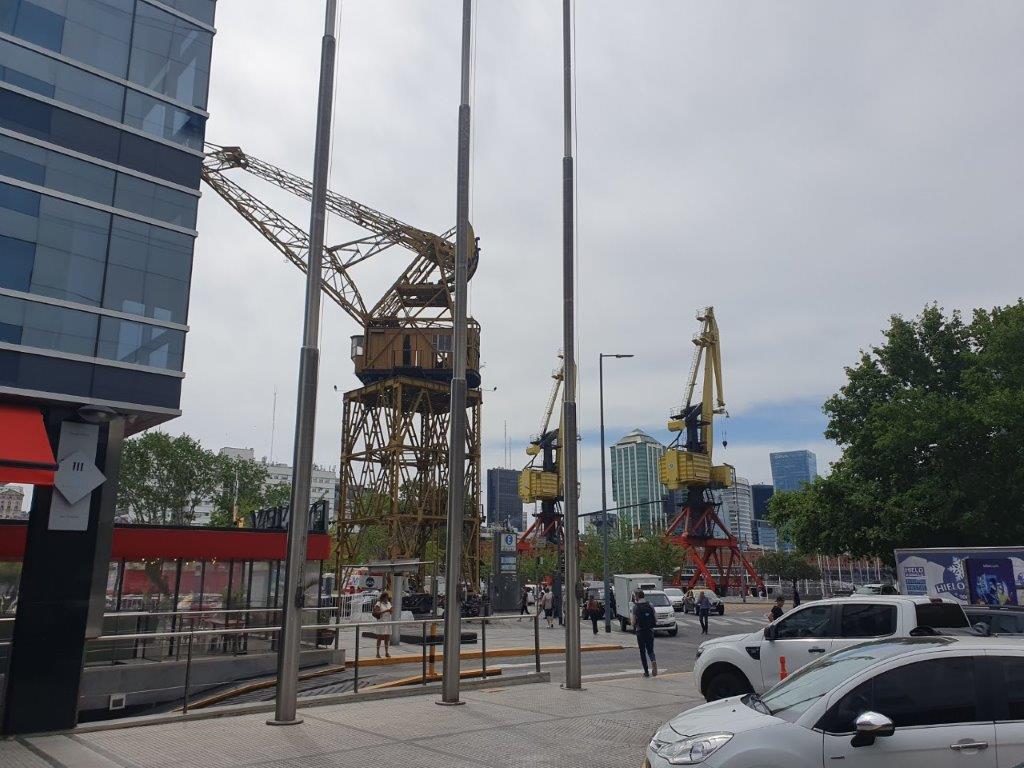
Led by the 1999 opening of the Hilton Buenos Aires, luxurious hotels, state-of-the-art multiplex cinemas, theatres, cultural centres, and office and corporate buildings are located mostly in the east side.
Puerto Madero has been redeveloped with international flair, drawing interest from businessmen, architects and designers such as Santiago Calatrava, Norman Foster, César Pelli, Alan Faena, Philippe Starck among others. Today one of the trendiest boroughs in Buenos Aires, it has become the preferred address for growing numbers of young professionals and retirees, alike. Increasing property prices have also generated interest in the area as a destination for foreign buyers, particularly those in the market for premium investment properties.
Every street in Puerto Madero is named after women. The Puente de la Mujer (Women’s Bridge), by Spanish architect Santiago Calatrava, is the newest link between the east and west docks of Puerto Madero; a museum inaugurated in 2008, the Fortabat Art Collection, itself resulted from an initiative by Amalia Lacroze de Fortabat (the wealthiest woman in Argentina).
Puerto Madero currently represents the largest urban renewal project in the city of Buenos Aires. Having undergone an impressive revival in merely a decade, it is one of the most successful recent waterfront renewal projects in the world.
The Wandelgek had a feeling of walking through the city of Amsterdam along the warehouses at the IJ, behind the Central Station while walking along the warehouses of Puerto Madero. It was very similar.
Maxima monument
The Queen Maxima monument includes an orange colored wall with the text Reina de Holanda (Queen of The Netherlands) in golden letters and two pedestals but only one with a statue on top. That is the Ana Frank (Anne Frank) statue.
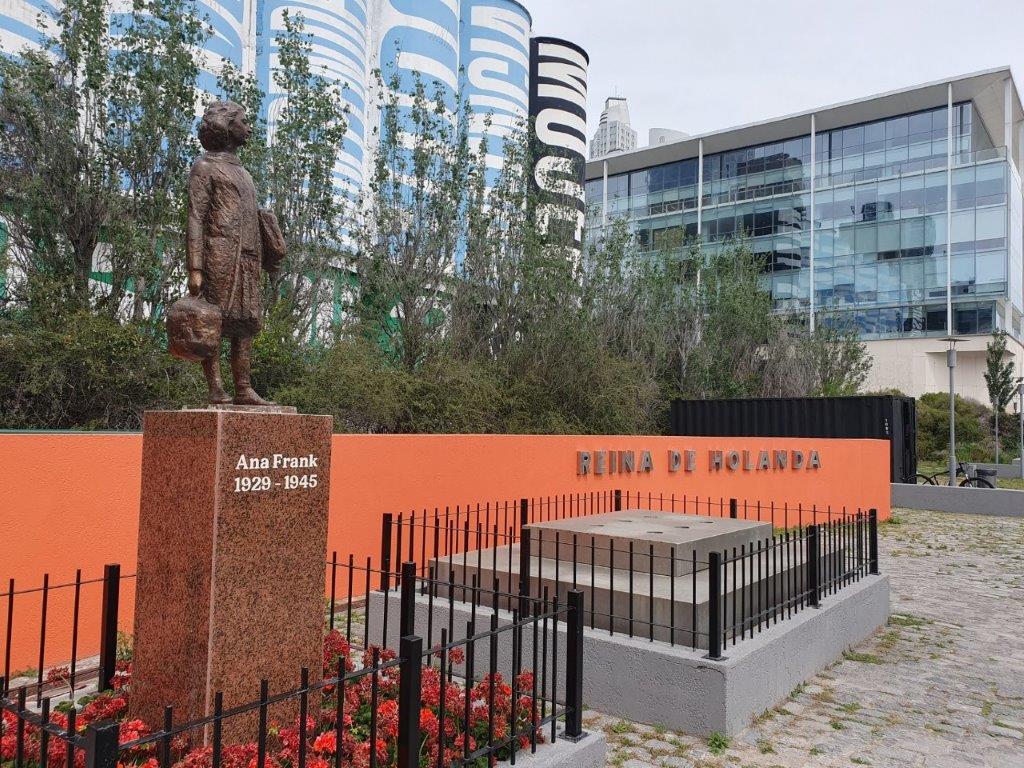
The missing statue was that of Queen Maxima herself which got stolen.
That concluded the citytrip of The Wandelgek through the most important 7 barrios of Buenos Aires.

